
Namibia Reisen im Juni
Namibia reise im juni.
Der Juni eröffnet die Saison für Wildtierbeobachtungen auf Namibia-Reisen . In der Mitte des Jahres fällt zusehendes weniger Regen, die Luft wird trockener und die Nächte kühlen auf bis zu 5°C ab. Das konstante Wetter im Juni sorgt dafür, dass alle Hauptstraßen und die meisten Wege frei befahrbar sind, was die Wintermonate in Namibia ideal für Safari-Reisen in Afrika macht.
Reisende sollten bei ihrer Urlaubsplanung mit einbeziehen, dass Parks und Sehenswürdigkeiten sich gegen Ende des Monats erheblich füllen. Deswegen wird dazu geraten schon im Voraus zu planen und bei Möglichkeit private Unterkünfte außerhalb, den Camps innerhalb von Reservaten vorzuziehen.
Unsere Natur- und Erlebnisreisen in Namibia
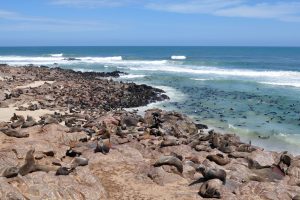
Namibia – Rundreisen
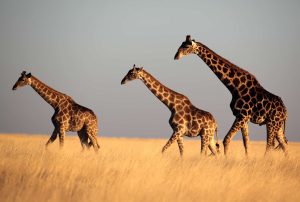
Namibia – Gruppenreisen
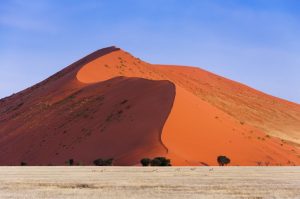
Namibia – Individualreisen
Die landesmitte von namibia und der etosha nationalpark im juni.
Naturtouristen zieht es nun immer mehr zum Gebiet des Caprivi Streifens , der durch sein tropisches Klima und enormen Wasservorkommen besonders viele Wildtiere beherbergt und eine dichte Vegetation vorweist. Das Buschland grenzt an die Flüsse Okavango , Kwando, Chobe und Sambesi an und beherbergt, trotzt seiner vergleichsweise kleinen Fläche, die vier Natur- und Wildschutzgebiete Bwabata National Park, Khaudom Game Park, Mamilia Game Park und Mudumu Game Park.
Reisende, von zum Beispiel Gruppenreisen Namibia , können sich besonders auf große Herden von Elefanten freuen. Auch der Etosha Nationalpark füllt sich nach dem Ende der Wintersaison mit immer mehr Wildtieren. Die durch den vorhergegangen Regen entstandenen Wasserlöcher trockenen zur Mitte des Jahres kontinuierlich aus und locken den Wildbestand dadurch zu den Hauptwasserstellen.
Auch im Etosha Nationalpark können ab Juni wieder Elefanten und andere große Wildtiere gesichtet werden. Durch die noch relativ grüne Landschaft und das vermehrte Aufkommen von Arten ist der Juni auch ein besonders beliebter Monat für Wildtierfotografie .
Die Küste und der Süden von Namibia im Juni
Das Schloss Duwisib ist ein wahrer Hingucker auf Individualreisen Namibia und befindet sich rund 80 Kilometer südwestlich von dem Dorf Maltahöhe . Das optisch auffällige Schloss wurde 1908 im Stil des Historismus von dem sächsischen Offizier Hansheinrich von Wolf erbaut. Der am Rand der Namib Wüste gelegene rote Sandsteinbau wurde 1991 renoviert und kann seither als Museum besichtigt werden.
Reisende die nach dem Aufenthalt in der Wüste Lust auf eine frische Meeresbrise verspüren, verschlägt es über die Hauptstraßen Namibias in die wenige Stunden entfernte Hafenstadt Lüderitz . Die durch die deutsche Kolonialzeit geprägte Stadt ist auf Grund der selten über 20°C liegenden Wassertemperaturen zwar nicht unbedingt als Badeort geeignet, bietet dafür einen eindrucksvollen Einblick in Kultur der Stadt.
Das bekannte Denkmal von Adolf Lüderitz, dem Namensgeber der Stadt, steht auf der Haifischinsel und das vom Zentrum unweit entfernte Museum klärt über den Diamantbergbau und die Geschichte von Lüderitz auf.
Feiertage und Feste im Juni
Namibia Tourism Expo
Die Namibian Tourism Expo gilt als die drittgrößte Messe des Landes und findet seit 1999 jährlich im Juni, über einen Zeitraum von vier Tagen, statt. Die von der afrikaanssprachigen Tageszeitung Die Republikein in Zusammenarbeit mit dem Namibia Tourism Board organisierte Veranstaltung findet auf den Windhoek Show Grounds von Windhoek statt. Die Tourismusmesse beschäftigt sich mit Themen die Bezug auf Namibias Gastfreundschaft, die Förderung des Lokaltourismuses und im allgemeinen Reisen im südlichen Afrika, nehmen.
Namibia – Naturerlebnisse pur!
Der Etosha-Nationalpark ist der größte Nationalpark des Landes und eignet sich bestens für aufregende Pirschfahrten und Safaris bei denen man unzählige Tiere beobachten kann.
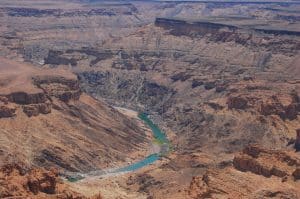
Einer der größten Canyons – der Fish River Canyon – liegt in Namibia. Er bietet besonders bei Sonnenuntergang einen wunderschönen Ausblick über die einmaligen Felsformationen und tiefen Schluchten.
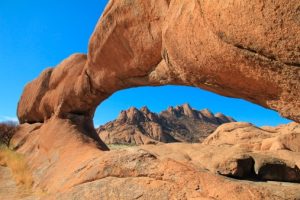
Das Erongo Gebirge ist der Überrest eines riesigen Vulkans und lädt zum Staunen ein: Riesige Granitblöcke liegen in der Landschaft verteilt und schimmern im Sonnenuntergang rötlich.
Das Sousoussvlei im Namib Naukluft Nationalpark beindruckt mit seinen roten Sanddünen und dem ausgetrockneten Deadvlei.
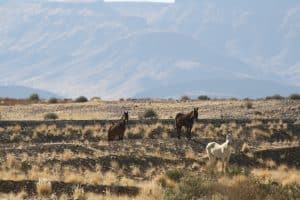
In Namibia begegnen Sie neben Elefanten, Giraffen, Zebras, Gnus, Antilopen, Löwen und Leoparden auch Wildpferden und Erdmännchen .
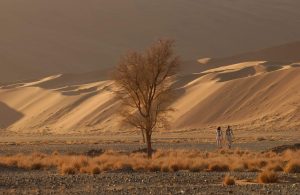
Auf dem Tok Tokie Trail wandern sie durch die älteste Wüste der Welt und können eine Nacht freiem Sternenhimmel verbringen.
Die wichtigsten Tipps für eine Namibia Reise im Juni
- Start der Saison für Wildtierbeobachtungen
- Auf Grund der Sommerferien verstärkt sich der Tourismus
- Erleben Sie große Elefantenherden im Caprivi Streifen
- Vermehrter Wildbestand an den Haupwasserquellen im Etosha Nationalpark
- Start der Namibian Tourism Expo, der dritt größten Messe Namibias
Weitere schöne Reisemonate für Namibia
Namibia reisen von natürlich reisen, ihr spezialist für natur- und erlebnisreisen.
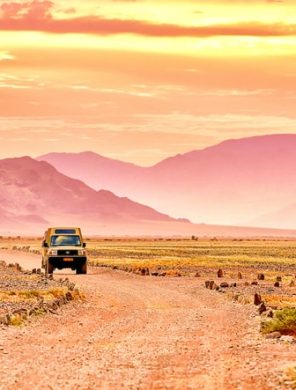
- Erongo Mountains
- Etosha South
- Onguma Game Reserve
- Waterberg Region
- Central Namibia
- Individualreise
- Flug zubuchbar
- Mittelklasse
- - Tierbeobachtung im Etosha Nationalpark
- - Bootsfahrt auf dem Okavango
- - Sundowner per Boot auf dem Chobe River
- - 3 Länder Erleben , Namibia, Botswana und Zimbabwe
- - Kleine Gruppengröße von max. 7 Personen
- - Erfahrene und deutschsprachige Reiseleitung
- - Ausgewählte Unterkünfte/Lodges
- - Gutes Preis-/Leistungsverhältnis
- Gruppenreise (7 max.)
- - Erlebnisse in der Kalahari und im Sossusvlei (Übernachtung im Park!)
- - Tierbeobachtung im Etosha Nationalpark und Damaraland
- - Leben der Wüste Tour "Little 5" bei Swakopmund
- Tierparadies Etosha Nationalpark
- Die Wüste lebt - Abenteuer auf Namibias höchsten Dünen
- Ein Tag mit den San - der ältesten Volksgruppe Afrikas
- Tiefe Schluchten und traumhafte Ausblicke am Fish-River-Canyon
- Surreale Welt der ehemaligen Diamantenstadt Kolmanskop
- Die Heimat der Erdmännchen - Die Kalahari
- Gruppenreise (12 max.)
- Flug inklusive
- Das Farbenspiel der Wüste erleben
- Spaziergänge auf Namibias höchsten Dünen
- Buntes Treiben am Wasserloch im Etosha Nationalpark
- Grünes Namibia, der Caprivi-Zipfel
- Ein Besuch bei den Mafwe, die Könige des Caprivi
- Bootssafari mit Hippos
- Die Victoria Fälle - ein einzigartiges Erlebnis
Neueste Beiträge
- Die 10 besten Webcams an Wasserlöchern in Afrika
- Maximieren Sie Ihre Urlaubszeit – Brückentage 2025 optimal nutzen
- Langstreckenflug mit Kindern – lange Flugreisen mit der ganzen Familie meistern
- Die ultimative Packliste für Ihre Afrika Reise
- Kulinarik auf Reisen – Märkte und Food Tours in Europäischen Städten
- Erleben Sie die Stille: Digital Detox beim Glamping in den entlegenen Ecken Afrikas
Natürlich.Reisen
- Unser Reiseblog
- Die Entstehungsgeschichte
- Warum beim Reiseveranstalter buchen
- Unser Reisemagazin
Unsere Destinationen
- Lateinamerika
Unsere Naturhelden Reisen
- Außergewöhnliche Naturreisen
- Hohe Beiträge für den Natur- und Artenschutz
- CO2 kompensiert
- Ganz nah rankommen
- Qualifizierte Reiseleitung & Expertengespräche
Jetzt Naturheld werden
Sie müssen den Inhalt von reCAPTCHA laden, um das Formular abzuschicken. Bitte beachten Sie, dass dabei Daten mit Drittanbietern ausgetauscht werden.
Sie sehen gerade einen Platzhalterinhalt von ProvenExpert.com . Um auf den eigentlichen Inhalt zuzugreifen, klicken Sie auf die Schaltfläche unten. Bitte beachten Sie, dass dabei Daten an Drittanbieter weitergegeben werden.

Geschrieben von: Webmaster am 24 September 2024
Namibia im Juni – alles, was du wissen musst
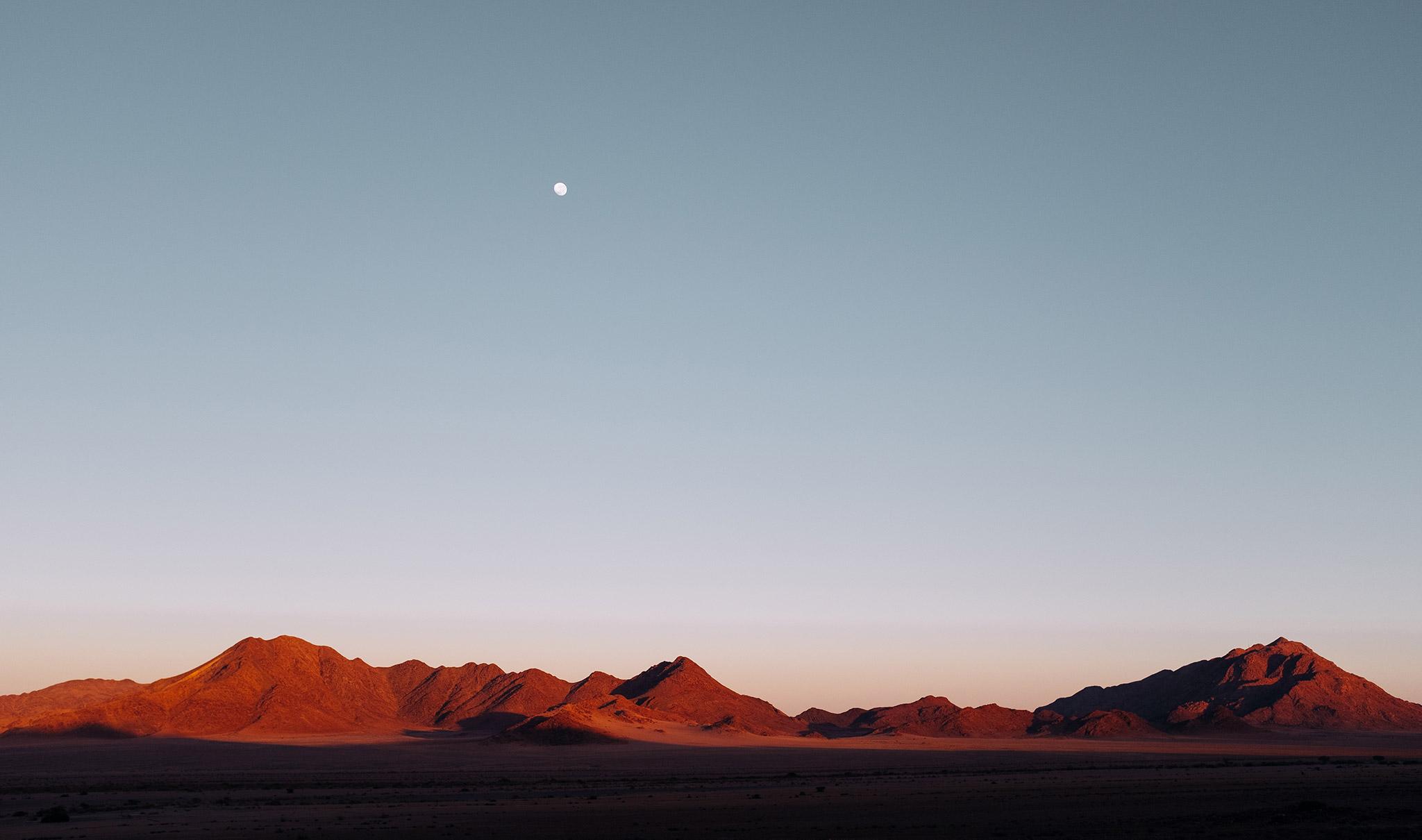
Inhaltsverzeichnis
Eine Reise nach Namibia im Juni ist wie die Entdeckung eines verborgenen Schatzes, bevor alle anderen davon erfahren. Im Juni beginnt die Hochsaison und der Winter auf der Südhalbkugel. Du kannst die bekannten Ziele wie den Etosha Nationalpark und die Namib Wüste in Ruhe erkunden, bevor im Juli und August die Hauptreisezeit mit mehr Besuchern beginnt.
Wenn du Namibia im Juni besuchen möchtest, empfehlen wir, bis zu einem Jahr im Voraus zu buchen .

Der Juni gehört zur Trockenzeit, und die Tiere im nördlichen Namibia beginnen, sich an den Wasserlöchern zu sammeln. Das schafft gute Bedingungen für Wildbeobachtungen. Stell dir vor, du bist auf deiner Traumsafari und siehst berühmte afrikanische Tiere wie Nashörner, Flusspferde, Giraffen und Elefanten, umgeben von endloser Weite und Stille. Der klare Himmel bietet die perfekte Kulisse für atemberaubende Fotos und unvergleichliche Sternenbeobachtungen.
Klingt gut? Wir können dir versichern: Ein Besuch in Namibia im Juni ist ein echtes Highlight. Egal, ob du Safari-Liebhaber, Abenteurer oder Wüstenfan bist, der Juni bietet dir die perfekte Mischung aus beeindruckenden Landschaften, vielfältiger Tierwelt und einer friedlichen, ungezwungenen Atmosphäre.
Das Wetter in Namibia im Juni
Mit trockenen, sonnigen Tagen und kühlen bis kalten Nächten markiert der Juni den Beginn der Trockenzeit Während die Morgende und Abende kühl sein können, sind die Tage in der Regel angenehm warm, mit Temperaturen zwischen 20°C und 25°C, viel Sonnenschein und kaum Regen. Auch wenn du morgens und abends eine zusätzliche Lage Kleidung brauchst, sind die Tage ideal, um die Namib Wüste, den Etosha Nationalpark , den Fish River Canyon oder die Küstengebiete wie Swakopmund und Walvis Bay zu erkunden.
Das sonnige Wetter mit klarem Himmel bietet dir hervorragende Fotografie Möglichkeiten. Die Trockenzeit bedeutet auch, dass die Straßen gut befahrbar sind, was den Zugang zu abgelegenen Gebieten wie der Namib Wüste und dem Etosha Nationalpark erleichtert.

Durchschnittliche Temperaturen in Namibia im Juni
Es gibt regionale Unterschiede im Klima, aber ganz Namibia bleibt im Juni generell trocken und regenfrei. In höher gelegenen Gebieten, wie der Hauptstadt Windhoek , liegen die Temperaturen tagsüber bei etwa 20°C, während sie nachts auf 10°C fallen können. Dieses Klima ist ideal, um die kulturellen Attraktionen der Stadt zu erkunden, ohne extreme Hitze oder Kälte erleben zu müssen.
Im Süden, besonders in der Namib-Wüste, liegen die Tagestemperaturen bei angenehmen 22°C, aber die Nächte können deutlich kälter werden, und manchmal sogar auf 5°C und darunter fallen. Wer gerne den Nachthimmel beobachtet, hat hier eine einmalige Gelegenheit: Die klaren, kalten Nächte bieten einen spektakulären Sternenhimmel.

An der Küste Namibias ist es immer kühler als im Landesinneren, und im Winter kommt es besonders entlang der Skelettküste zu Nebel.
Im Norden des Landes, einschließlich des berühmten Etosha Nationalpark , bewegen sich die Tagestemperaturen um die 25°C, was perfekt für Pirschfahrten ist. Morgens und abends wird es kühler, also zieh dich für die frühen Safarifahrten warm an.
In all diesen Regionen sind die gemäßigten Tagestemperaturen und die kühlen Nächte im Juni ideal zum Wandern, Fotografieren und Genießen der weiten Landschaften.
Unsere beliebtesten Safaris in Namibia im Juni:

Namibia Explorer
Orte: Namib Wüste, Swakopmund, Skelettküste, Damaraland, Etosha Nationalpark
ab 30.800 NAD (bei 6 Personen)

Namibia Entdecken
Orte: Windhoek, Kalahari, Namib Wüste, Swakopmund, Erongo Gebirge, Damaraland, Etosha Nationalpark, Waterberg Plateau
ab 63.000 NAD im Doppelzimmer
Ist Juni eine gute Zeit für eine Safari im Etosha Nationalpark?
Juni ist ein guter Monat, um den berühmten Etosha Nationalpark im Norden Namibias zu besuchen. Etosha gilt unter anderem als einer der besten Orte in Afrika, um das Spitzmaulnashorn in seiner natürlichen Umgebung zu sehen. Der Park, der sich um die riesige, salzhaltige Etosha-Pfanne erstreckt, wimmelt zudem von Flamingos, Elefanten, Giraffen, Leoparden und Straußen.
Im Juni beginnt in Namibia die Trockenzeit. Das heißt, die Vegetation kann an einigen Stellen noch sehr dicht sein. Allerdings sind jetzt auch weniger andere Besucher im Parks unterwegs als im Juli, August und September, wenn die Trockenzeit schon weiter vorangeschritten ist. Wenn dir ein abgeschiedenes Safarierlebnis wichtig ist, kann das ein entscheidender Vorteil sein. Die Bedingungen für Safaris sind auch bereits im Juni sehr gut.

Die kühleren Temperaturen von 20°C bis 25°C tagsüber sind ideal für Pirschfahrten. In den frühen Morgenstunden und späten Nachmittagen, wenn die Tiere besonders aktiv sind, hast du die besten Chancen auf beeindruckende Sichtungen. Das trockene, klare Wetter erleichtert es außerdem, Wildtiere auf den weiten Ebenen zu sehen und unvergessliche Fotos zu machen.
Wenn du etwas Abwechslung suchst, empfehlen wir dir die Sambesi Region mit ihren üppigen Landschaften, Flüssen und Feuchtgebieten. Hier findest du atemberaubende Nationalparks wie den Mudumu Nationalpark , bekannt für seine Flutebenen und reiche Tierwelt wie Elefanten und Büffel. Der Bwabwata Nationalpark bietet eine beeindruckende Artenvielfalt und hervorragende Möglichkeiten für Vogelbeobachtungen, während der Mamili (Nkasa Rupara) Nationalpark für seine Feuchtgebiete bekannt ist und ein Paradies für verschiedene Wasservögel und Wasserlebewesen darstellt. Diese Parks bieten einzigartige Erlebnisse, von Bootstouren bis hin zu Buschwanderungen, und zeigen das reiche Naturerbe der Zambezi-Region.
Ob du ein erfahrener Safari-Gänger oder ein Erstbesucher bist, Etosha und die Nationalparks der Zambezi-Region bieten dir im Juni ein unvergessliches Abenteuer.

Ist Juni eine gute Zeit, um die Namib Wüste zu besuchen?
Ein Besuch der Namib Wüste im Juni wird ein unvergessliches Erlebnis sein, denn du kannst das Beste herausholen und dabei optimale Wetterbedingungen genießen. Tagsüber liegen die Temperaturen angenehm zwischen 20°C und 25°C, bei geringer Luftfeuchtigkeit – perfekt für Aktivitäten wie Wandern, Sandboarding oder Quad-Touren. Die kühleren Temperaturen machen das Erklimmen der Düne 45 oder die Erkundung von Deadvlei besonders angenehm, ohne die extreme Hitze, die du in den Sommermonaten erleben würdest. Allerdings können die Nächte kalt werden und manchmal unter 0°C fallen, also vergiss nicht, warme Kleidung einzupacken.
Der klare, frische Himmel im Juni bietet atemberaubende Sonnenauf- und -untergänge, besonders an bekannten Orten wie Sossusvlei und Deadvlei. Diese Momente sind nicht nur ideal für deine Fotos, sondern werden auch in deinen Erinnerungen für immer lebendig bleiben. Die Lichtverhältnisse heben die dramatischen Landschaften besonders hervor, und die fehlende Lichtverschmutzung bietet dir einige der besten Möglichkeiten für Sternenbeobachtungen. Der Anblick der Milchstraße und zahlloser funkelnder Sterne wird garantiert zu einem Erlebnis, das du so schnell nicht vergessen wirst.

Denke bei einem Besuch im Juni daran, dich auf kalte Nächte vorzubereiten und mehrere warme Schichten an Kleidung mitzunehmen. Dennoch bleibt die Sonne tagsüber stark, also vergiss nicht, Sonnencreme, Hut und Sonnenbrille einzupacken, um dich vor UV-Strahlen zu schützen. Es ist wichtig, auch bei kühlerem Wetter genug Wasser zu trinken, besonders bei Outdoor-Aktivitäten.
All das macht den Juni zur idealen Zeit, um die außergewöhnlichen Landschaften, die Tierwelt und die Kultur der Namib-Wüste in einer ruhigen und komfortablen Atmosphäre zu erleben.
Du möchtest im Juni nach Namibia reisen? Melde dich bei uns, um deine Reise zu planen!
Die besten Orte und Aktivitäten in Namibia im Juni
Im Juni erwartet dich in Namibia eine unglaubliche Vielfalt an Erlebnissen, die die reiche Kultur, die abwechslungsreiche Tierwelt und die atemberaubenden Landschaften des Landes verbinden.
Für ein ganz besonderes Tiererlebnis solltest du Swakopmund und das nahegelegene Walvis Bay ansteuern. Zwischen Juni und November ziehen hier die südlichen Glattwale und Buckelwale entlang der Atlantikküste und bieten einmalige Gelegenheiten für Walbeobachtungen. Auch Vogelliebhaber kommen in den geschützten Feuchtgebieten von Walvis Bay, einem Ramsar-Gebiet, auf ihre Kosten. Hier bieten Pelikane und Flamingos ein farbenprächtiges Spektakel vor der Küstenkulisse.

Ein weiteres Highlight ist das Damaraland , die Heimat wüstenangepasster Elefanten und einzigartiger Wildtiere wie das vom Aussterben bedrohte Spitzmaulnashorn und das Hartmann-Bergzebra. Hier Wildtiere zu beobachten, die es geschafft haben, in diesen harschen und trockenen Bedingungen zu überleben, ist ein besonderes Erlebnis. Darüber hinaus bietet das Damaraland eine reiche kulturelle Geschichte, mit den antiken Felsgravuren von Twyfelfontein , einer UNESCO-Welterbestätte, die einen Einblick in das Leben der San vor Tausenden von Jahren gibt.

Ein weiterer faszinierender Ort, den du unbedingt in deine Reise einplanen solltest, ist die Skelettküste. Sie erstreckt sich entlang der nördlichen Küste Namibias und ist bekannt für ihre gefährlichen Gewässer, die zahlreiche Schiffswracks verursacht haben. Die rostigen Schiffsrümpfe entlang der Küste erzählen von Tragödien und Mut. Hier findest du auch Kolonien von Kap-Pelzrobben, besonders am Cape Cross, wo Tausende dieser Meeressäuger auf den Felsen in der Sonne liegen. Die gelegentlich vom Atlantik hereinziehenden Küstennebel verleihen der ohnehin schon dramatischen Landschaft eine geheimnisvolle, fast außerirdische Atmosphäre, die die Skelettküste zu einem wirklich einzigartigen Reiseziel in Namibia macht.
Egal, was du in dein Reiseprogramm aufnimmst: Es wird deine Reise zu einem unvergesslichen Erlebnis machen. Bei Namibia-Experience sind wir dafür da, dir zu helfen, das Beste aus deinem Namibia-Besuch herauszuholen. Kontaktiere uns gerne für Unterstützung bei deiner Reiseplanung.
Wie viel kostet eine Reise nach Namibia im Juni?
Eine Reise nach Namibia im Juni kann etwas günstiger ausfallen, da die Hauptreisezeit erst im Juli und August beginnt. In dieser Zeit findest du mit Glück auch etwas günstigere Angebote für Unterkünfte, da viele Lodges, Tented Camps und Hotels vergünstigte Preise im Vergleich zur Hochsaison anbieten. Trotzdem empfehlen wir, deine Reise rechtzeitig zu buchen, da die Besucherzahlen schnell steigen.

Zwar ist Juni generell etwas günstiger als die Monate Juli und August, aber die Preise sind dennoch höher als in der Regenzeit (November bis April).
Auch geführte Touren und Safaris sind in dieser Zeit oft etwas preiswerter, sodass du ein gutes Preis-Leistungs-Verhältnis erhältst. Selbstfahrertouren sind eine beliebte und kostengünstige Möglichkeit, Namibia zu erkunden. Dabei hast du die Freiheit, dein Budget zu kontrollieren, indem du aus einer Vielzahl von Unterkünften wählen kannst – von Luxus-Lodges bis hin zu preiswerteren Gästehäusern und Campingplätzen.
Flüge nach Namibia können einen größeren Kostenpunkt darstellen, früh zu buchen, lohnt sich oft. Du kannst dich auch für eine Gruppenreise statt für eine Privatreise entscheiden, um mehr aus deinem Reisebudget rauszuholen. Insgesamt bietet der Juni ein gutes Gleichgewicht zwischen Erschwinglichkeit und Zugang zu Namibias beliebtesten Sehenswürdigkeiten, was ihn zu einer hervorragenden Reisezeit macht, ohne dass du dein Budget überstrapazierst.

Welche Kleidung sollte ich für Namibia im Juni mitnehmen?
Wenn du dich für eine Safari mit uns entscheidest, erhältst du von uns eine umfangreiche Packliste und hilfreiche Tipps. Hier schon mal einige allgemeine Hinweise:
- Wähle langärmelige Tops und lange Hosen, um dich vor der Sonne und Insektenstichen zu schützen.
- Vermeide auffällige Farben sowie Tarnmuster, Dunkelblau und Schwarz.
- Packe warme Kleidung ein, die du bei den morgendlichen Pirschfahrten tragen kannst.
- Ein Hut und eine Sonnenbrille bieten zusätzlichen Schutz vor der Sonne.
- Nimm geschlossene Schuhe für die Pirschfahrten und gemütliche Abende am Lagerfeuer mit.
- Packe auch einen Badeanzug für die Pools in den Lodges ein.
- Nimm etwas Schickes mit, um ein klassisches Safari-Dinner zu genießen.

Ist Juni ein guter Reisemonat für Namibia?
Juni ist eine hervorragende Zeit, um Namibia zu bereisen, denn es bietet eine perfekte Kombination aus fantastischen Erlebnissen, noch bevor die meisten Touristen im Juli und August eintreffen. Den ganzen Monat über hast du die Gelegenheit, Namibias vielfältige Landschaften zu erkunden – vom wildreichen Etosha Nationalpark über die üppige Sambesi Region bis hin zur atemberaubenden Namib Wüste und der geheimnisvollen Skelettküste – und das bei idealen Wetterbedingungen. Das trockene, kühle Wetter ist perfekt für Tierbeobachtungen und Outdoor-Aktivitäten, während die geringeren Besucherzahlen für entspanntere Erlebnisse sorgt. Aufgrund der hohen Beliebtheit empfehlen wir, deine Reise so früh wie möglich zu planen, idealerweise bis zu einem Jahr im Voraus.
Wir bei Namibia-Experience sind Experten darin, deine perfekte Namibia-Reise zu gestalten – melde dich bei uns , um dich bei der Planung zu unterstützen.
Das könnte dich auch interessieren:

Wann ist die beste Reisezeit für den Etosha Nationalpark?
Unser Monat-für-Monat-Leitfaden zur besten Reisezeit für den Etoscha Nationalpark - Namibias beliebtes Safariziel. Temperaturen, Wetter & mehr.

Lohnt sich ein Besuch im Khaudum Nationalpark?
Abgelegen, kaum Menschen, viel Natur – lohnt sich ein Besuch im Khaudum Nationalpark? Unser Guide Juan teilt hier seine Einschätzung zum Abenteuer.

Wann ist die günstigste Reisezeit für Namibia?
Wann ist die günstigste Zeit für eine Namibia Reise? Unsere Tipps für preisbewusste Reisende – wie du das meiste aus deinem Reisebudget machst!
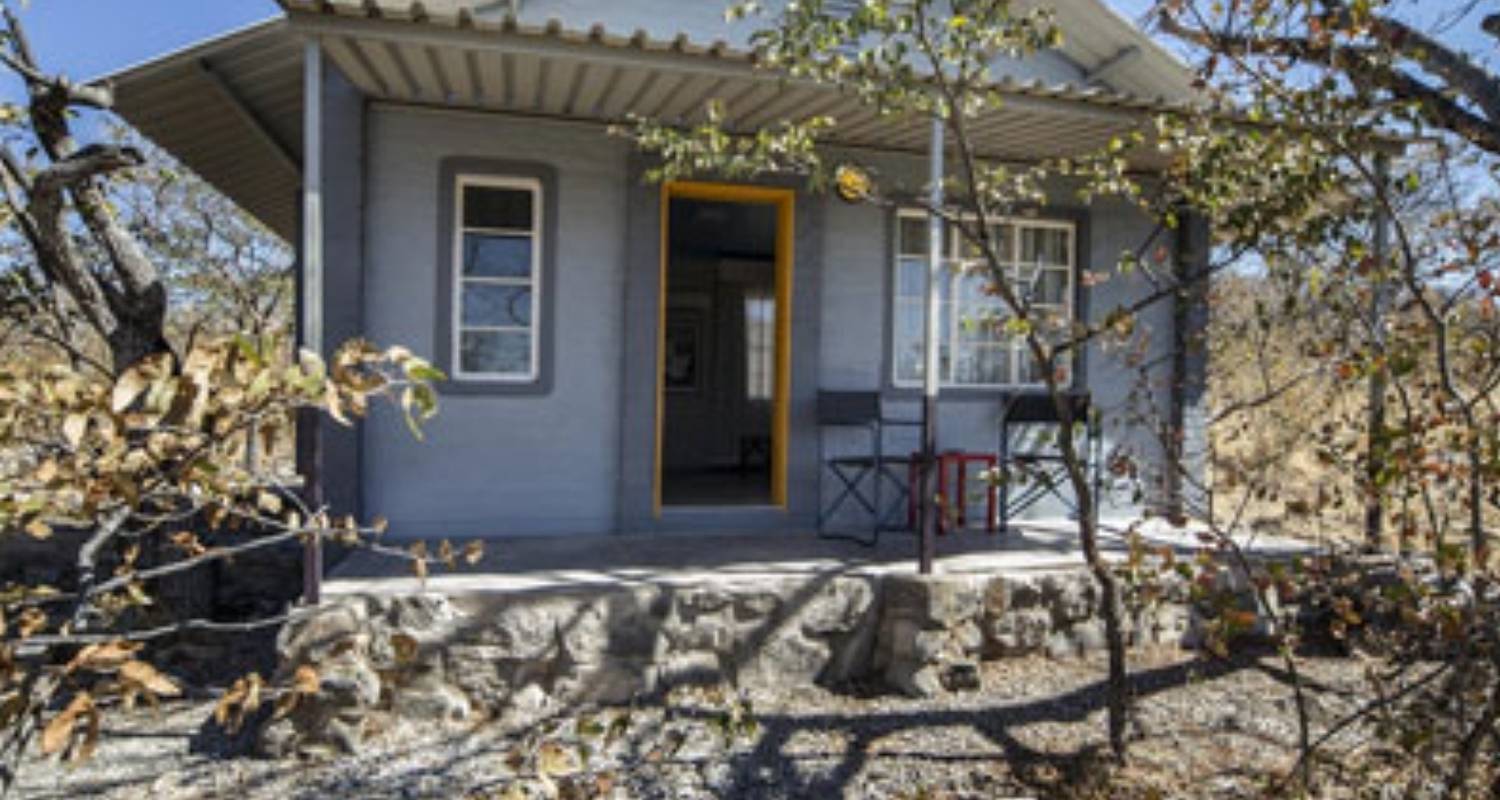
Namibia Safari Tours
- Choose from 50+ Namibia tours
- 46 verified reviews from TourRadar travelers
- 24/7 customer support
10 best Namibia safari tour packages
Compiled by

Steff Namibia travel expert at TourRadar
6 Day Etosha & Skeleton Coast Experience * DEPARTING THURSDAYS
6 days sossusvlei, swakopmund and etosha national park lodging, 6 days sossusvlei, swakopmund and etosha np camping, 7 day southern namibia & sossusvlei – camping safari *departing thursdays, essential of 6 days dunes & wildlife safari, namibia jewel, african safari adventure in namibia - 11 days, 10-day highlights of namibia private trip, 7-day best of namibia luxury fly-in safari, 3 days etosha national park | private guided camping.

- Christmas & New Year
- Enjoy a dolphin cruise in Walvis Bay
- Watch wildlife at a floodlit waterhole
- Visit the shipwreck on the Skeleton Coast
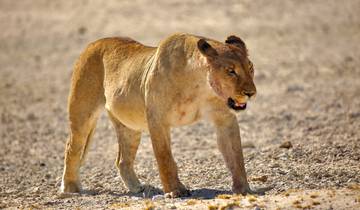
- Go on a half-day game drive in Etosha
- Shop at Okahandja Wood Carving Market
- Climb Dune 45 at sunrise
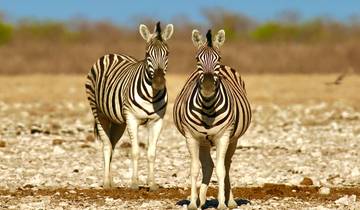
- Explore Namib Naukluft National Park
- Enjoy a full-day game drive in Etosha
- Visit Okahandja Wood Carving Market

- Explore the birdlife at Walvis Bay lagoon
- Tour the ghost town of Kolmanskop
- View the vast Fish River Canyon
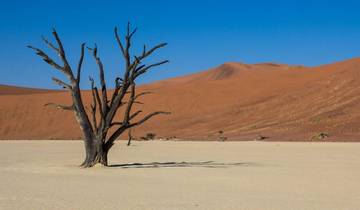
- Climb the towering dunes of Sossusvlei
- Visit the eerie Skeleton Coast shipwrecks
- Sample famous apple pie in Solitaire
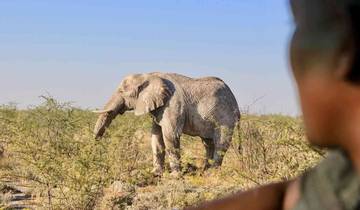
- Explore N/a’an ku se Wildlife Sanctuary
- Taste famous apple pie in Solitaire
- Spot wildlife at Etosha National Park
“The sites exceeded our expectation, we saw a lot of wild life and breathtaking sunsets.” Ann-margaret Susan Engelbrecht, traveled in June 2018

- Stand silent and admire the stark ambience of Dead Vlei
- Be overwhelmed by the abundant animals in Etosha
- Marvel at the sea of sand from the top of Dune 45
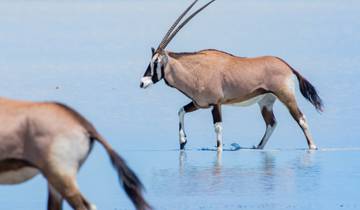
- Climb the dunes for sunrise at Sossusvlei
- Discover Swakopmund's colonial charm
- Explore the ancient Sesriem Canyon
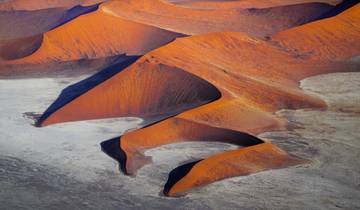
- Explore Sandwich Harbour from Swakopmund
- Join game drives in Etosha National Park
- Relax at Ongava Tented Camp at sunset
“We enjoyed tour very much. Particularly, the guide was sincere and hardworking.” Sang Mok Suh, traveled in September 2023
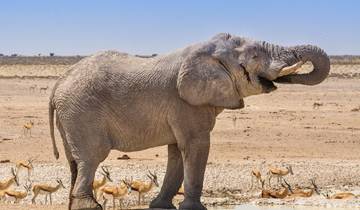
- Experience an afternoon game drive
- Enjoy evening chats under Namibian stars
- Observe wildlife in Etosha National Park
More about Namibia
Discover TourRadar
- Travel Guides Plan your adventure
- Destinations Our favourite places
- Tours Book a trip
- Travel Companies Independent specialists
- Travel Guides
- Destinations
- Travel Companies
Safari in Namibia
An expert guide to the best safaris in namibia.
Melanie van Zyl
- Where to go
- Need to know
How it works
Namibia safari.
Researching travel guides, reviewing campsites and finding new ways to photograph its sublime scenery, I've been going on safari in Namibia for over a decade and have visited virtually every corner of this vast and little-known country.
Namibia shares borders with some of Southern Africa’s safari heavyweights: South Africa , Botswana and Zambia . But the Namibia safari experience has little in common with its neighbours. Yes, there are all the “big five” and other blockbuster megafauna, but all in much lower densities. There are few open savannahs and vast river deltas. Here, the desert reigns supreme. Namibia is Sub Saharan Africa’s driest country, where the elephants have evolved into their own subspecies to adapt to the scarcity of water. Going on safari in Namibia is more about marvelling at the staggering desert scenery and the weird micro-scale wildlife that can withstand this extreme environment.
You can go on safari in South Africa or Kenya to chase the big five. You go on safari in Namibia to see something that is truly, often startlingly, different.
If there's one place that's truly about the journey, not the destination, it is Namibia. Read on for my expert guide to the best safaris in Namibia.
Namibia safaris: At a glance
Hidden gems: Most Namibia itineraries will include Etosha National Park, Fish River Canyon and the Skeleton Coast, but there's much more to the country. Bwabwata National Park is often overlooked; I like to think of this area as a more affordable Okavango Delta .
Self drive: Most people visit on an organised tour, but self driving is surprisingly easy. You can rent a 4X4 in Windhoek or Walvis Bay, and book your own accommodation directly.
When to go: The best time for wildlife viewing is the dry season (May to October), while the wet season (November to April) transforms the desert into a blooming wonderland ideal for photographers and birdwatchers.
Best safaris in Namibia
Our expert's top picks.
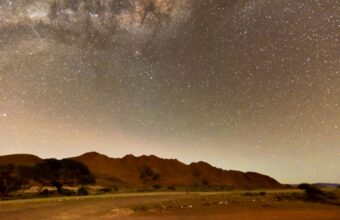
NamibRand Nature Reserve
Stargazing and walking safari in NamibRand
If you have the bucks, the NamibRand Nature Reserve is where I like to escape the masses that can crowd Sesriem at the entrance to Namib-Naukluft National Park. There are luxury lodges here, such as Kwessi Dunes or &Beyond Sossusvlei Desert Lodge, which are well-regarded if pricey. I prefer the organised overnight walking safaris: light pollution is minimal here and the skies are among the darkest and clearest on earth. Immersed in the silence of the desert darkness, I experience a humbling connection to the cosmos.
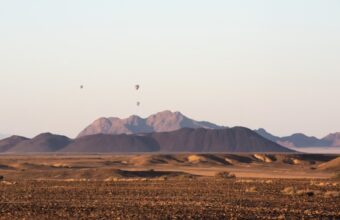
Namib-Naukluft National Park
Balloon ride over the Namib Desert
While you might be disappointed that the balloon doesn't actually cross over the Sossusvlei or Deadvlei claypans, there is freedom in being beholden to the desert winds. Dramatic views from a balloon basket offer an eerie sense of the vastness and solitude of the Namib Desert, evoking a deep appreciation for this untouched wilderness. We even spotted a brown hyena scuttling across the sands below during my flight. Be prepared for a rudely early wake-up call. It's best to stay close to the launch site at Kulala Desert Lodge, or the kitschy Le Mirage Desert Lodge and Spa.
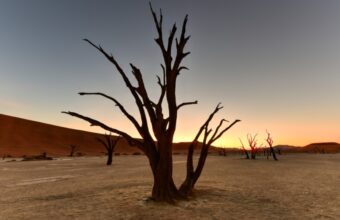
Wake early for sunrise at Deadvlei
The Sesriem junction is the starting point for trips to the Sossusvlei and Deadvlei claypans. To experience sunrise (or sunset), beat the heat and get ahead of the crowds, spend the night at one of two lodges located within the park gates (Sossus Dune Lodge and the pricier, more private Kulala Desert Lodge). Alternatively camp at the very basic Sesriem Camp for the perk of an hour-early entry to the park. It's a 60-kilometre drive to the Sossusvlei and Deadvlei sites (many visitors stop at Dune 45 instead, but I recommend you forge on). Deadvlei is then a further one-kilometre hike from the car park (not everyone is fit enough for this trek, especially in peak sunshine) and is where you can climb the spine of the Big Daddy Dune.
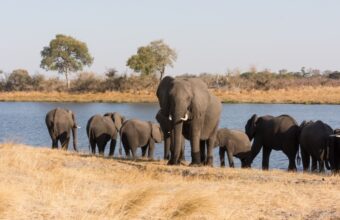
Bwabwata National Park
Watch migrating elephants
Bwabwata National Park has limited accessibility and few self-drive routes, but the wildlife is no less dramatic than other popular parks. My favourite area is Horseshoe Bend in the Mayuni Conservancy zone, with its abundant plains animals. Elephants congregate here in their hundreds on their migration route between May and September, and it's where I snapped my first magazine cover shot. Nambwa Campsite and Nambwa Lodge (a treetop stay with high walkways for elephants to wander freely below) are the nearest accommodations. The park can get busy in peak seasons, impacting the sense of wilderness. Also, consider exploring the less-visited Nkasa Rupara National Park nearby.
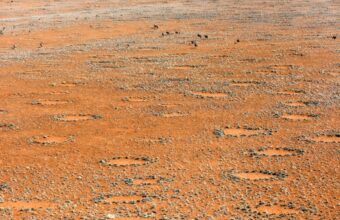
Horse ride (or ebike) past fairy circles at Wolwedans
Wolwedans is one of the most established lodge collections in the country, with enviable locations dotted across the NamibRand Nature Reserve. I loved how committed this operation is to treading lightly, and I had tremendous fun gliding along, up and down, over the dunes of the Namib Desert by horseback and bike. Whether a flat-out gallop or a sedate trek, all levels of riders are welcome to wind between the “fairy circles”, mysterious barren patches amid the desert flora that have long perplexed scientists. Theories range from plant self-organisation to toxins from euphorbia bushes. Still, my favourite story is the Himba explanation that they are the footprints of Mukuru, their supreme being.
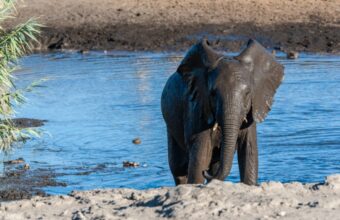
Etosha National Park
Spy on elephants at the waterhole
Etosha's waterholes provide an excellent David Attenborough-worthy opportunity to witness wild animals up close. Watch elephants slake their thirst under the scorching sun or detect the sounds of rustling leaves and animal calls as giraffes, zebra and impala tentatively gather during the evening. The Okakuejo's floodlit waterhole is a great spot to glimpse the critically endangered black rhino. I recommend you book accommodation in advance during peak season, weekends, and festive December. Alternatively, visit during the wet season when the landscape is greener, but water availability causes animals to disperse. Etosha is surrounded by other private game reserves and luxurious places to stay, including Anderssons at Ongava (I have my heart set on visiting the Ongava Discovery Centre next) and Onguma Camp Kala.
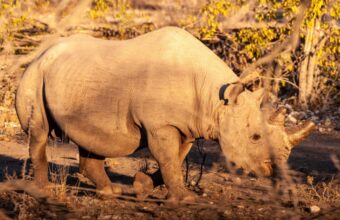
Track the critically endangered black rhino
Head out on a game drive or an immersive (though sometimes hot and long) walking safari to track the world's last remaining free-roaming population of the critically endangered black rhino. I always find Rhino tracking a heart-pounding adventure. A dance of anticipation and caution as you trek the rugged landscape. Palmwag Concession is the best area, and top sightings generally occur between April and November, but stay at least two days to up your chances of seeing the rare animals. Well established, the Desert Rhino Camp is high-end, but Damaraland Camp, Camel Top Community Campsite, Palmwag Lodge and Sesfontein Guesthouse are affordable alternatives.
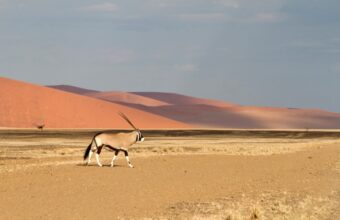
Learn about the living desert
So many people visit the iconic dunes of Sossusvlei but don't notice the phenomenal creatures that eke out an existence in this extraordinary landscape. Unlike other deserts, critical ocean mists feed the Namib sands and sustain fog-sipping beetles, nude-coated lizards and handsome snakes that bury themselves in the sand. They’re tricky to find by yourself, so get a guide to share their tips and tricks for seeking out the small stuff.
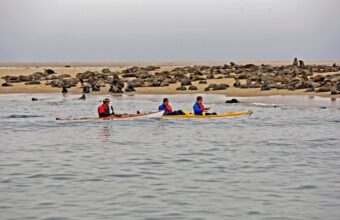
Sea kayak with seals
Enjoy a unique desert sea safari by kayaking amidst playful marine companions. Departing in the morning when the waters are calm, this three-hour tour has you paddling towards the Walvis Bay Cape fur seal colony, where it's common for them to swim close and sometimes even hop onto the ends of the kayaks! I also spotted dolphins, pelicans, flamingos, and Damara terns on the Pelican Point sandbar. Be sure to dress warmly. If kayaking isn't your thing, you can also opt for sedate boat tours.
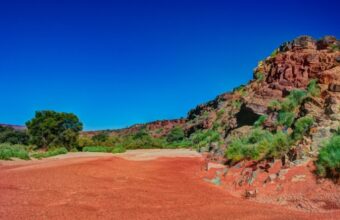
Gondwana Namib Park
Retreat to the Desert Whisper pod
Perched on the rim of a gravel-strewn hill, a 4X4 abandoned me at a remote villa in Gondwana Namib Park. This secluded stay feels like a Mad Max spaceship landed in the middle of nowhere. Designed for couples as a one-of-a-kind honeymoon hideaway, the open-plan apartment has a pool, plush reading lounge, and cocktail nook. The view – and everything besides – is yours alone, with nobody else for miles around. There are few places where you are left entirely to your own devices. Enjoy the breathtaking perspective and soak up the silence.

featured namibia safaris
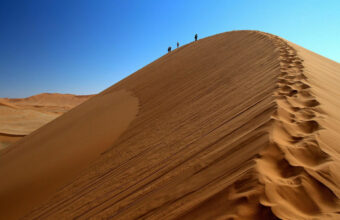
Namibia Unbound
10 day small group tour to the highlights of namibia.

Boutique Namibia Tours
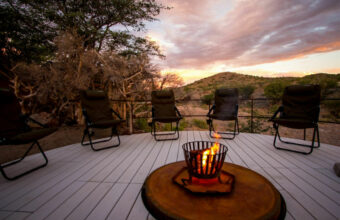
Namibia Under Canvas
10 day small group tour.
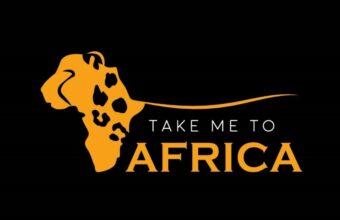
Where to go on safari in Namibia
Namibia's most popular – and some lesser-known – highlights.
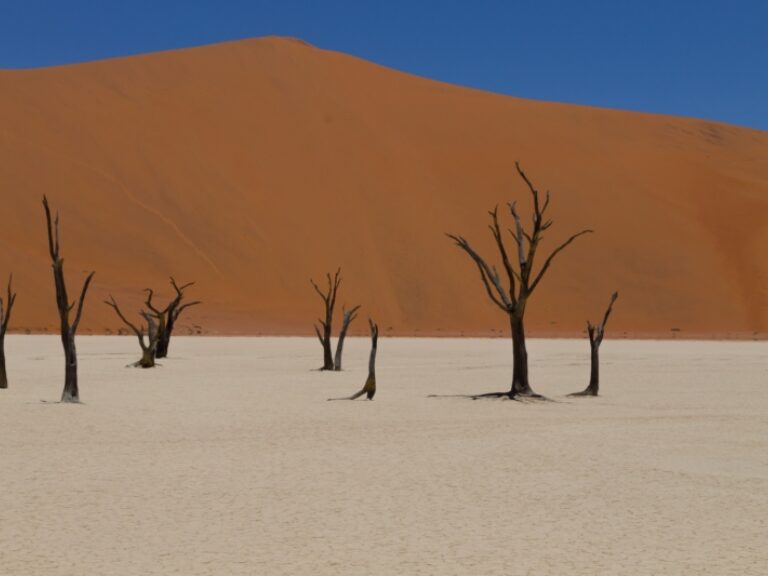
Hike landscapes straight from a surrealist painting
Probably my favourite places in all Namibia are the pale clay pans of Sossusvlei and Deadvlei. Set in the sprawling Namib-Naukluft National Park, this is one of Earth's oldest and most captivating deserts.
The odd oryx, springbok antelope and ostrich dot the scrubland but don't expect any big five sightings here, this place is more about unshowy wildlife and its visually arresting landscapes. (For game sightings I’d recommend Namibrand or Etosha instead.) Here you'll find a surreal playground of towering dunes in ombre spice-coloured shades, from paprika to turmeric to cinnamon and hauntingly beautiful fossil valleys.
As you venture deeper into the park, you can get out of the vehicle and touch the sands. Come at dawn, and you'll feel the mist from the Atlantic Ocean settling on your arm as you climb the dunes, before it dries out in the warming morning sun.
There are no adventure activities like sand boarding on offer here, it's about climbing the sand dunes (in designated areas), ambling across the pans, and stopping for a picnic to soak up the scenery.
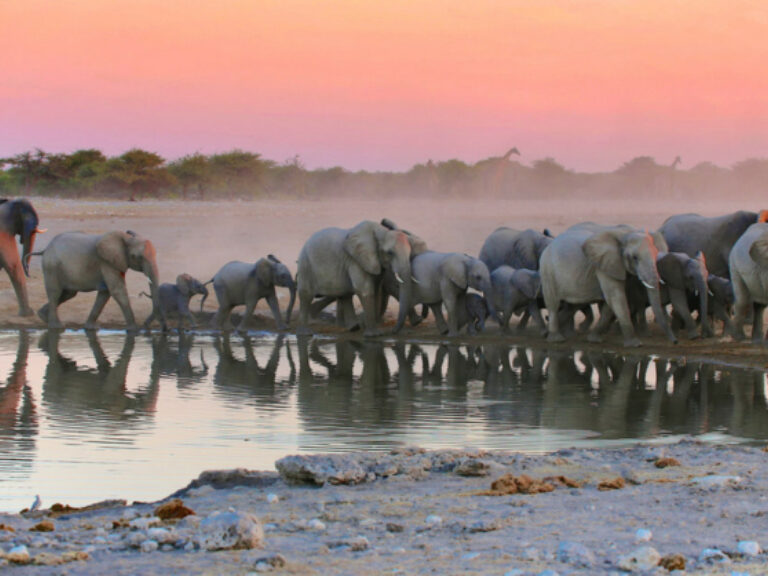
Namibia’s most famous safari park
Its name means 'the empty place' but with Namibia's highest concentration of wildlife, Etosha is anything but empty of safari sightings – the only big five animal not found here is the Cape buffalo.
Etosha National Park is well-known for its waterholes, best visited during the dry season when wildlife flocks to these oases dotted throughout the park. In Etosha I have spotted lions chasing springbok, dozens of bird species (including many pairs of elegant blue cranes), imposing white-crusted elephants, oryx herds, giraffes, and much more. But the real safari treat is to sit still. Pack a picnic and spend some time at the waterhole to appreciate the astounding diversity and density of the game.

Namibia’s safari hidden gem
Escape the mainstream safari itineraries at Bwabwata National Park. Often overlooked in favour of Namibia’s more famous safari parks, I like to think of this area as a more affordable Okavango Delta .
With lush landscapes and riverine forests, the wetlands of the Zambezi Region (formerly known as the Caprivi Strip) in northernmost Namibia offer a striking comparison to the stark coastline and desert interior. It's part of the Kavango-Zambezi Transfrontier Conservation Area, covering an area of 444,000 square kilometres. Bwabwata National Park sits at the heart of this region and is home to hippos, crocodiles, roan, sable, impala and red lechwe, and lions and leopards. The Buffalo Core Area is notable for its buffalo herds in the east. The Kwando Core Area to the west is primarily known for its elephants and sometimes African wild dogs pass through.
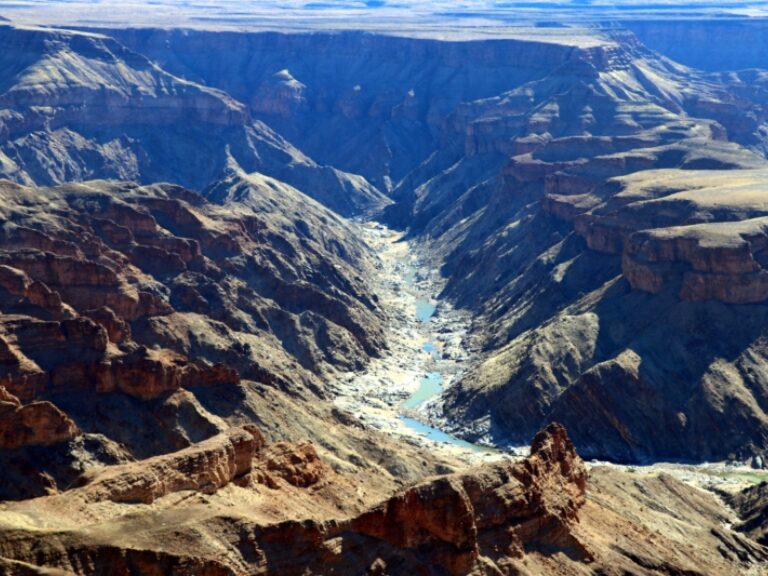
ǀAi-ǀAis/Richtersveld Transfrontier Park
Trek the iconic fish river canyon.
Namibia's Fish River Canyon is a staggering geological masterpiece in the /Ai-/Ais Richtersveld Transfrontier Park, shared by Namibia and South Africa.
The main viewpoint and information centre are worth a visit for an epic sunset if it's on your route, but to truly escape the tourists, your best bet is to embark on the epic five-day trek along the canyon floor. Sights in this area include quiver trees and cute klipspringer antelopes. It's a straightforward trek as you can’t leave the canyon walls, but you’ll be totally self-sufficient and it’s not to be underestimated – I had a friend who had to be helicoptered out due to heat exhaustion and dehydration. An organised trek accompanied with a guide is recommended, if not essential.
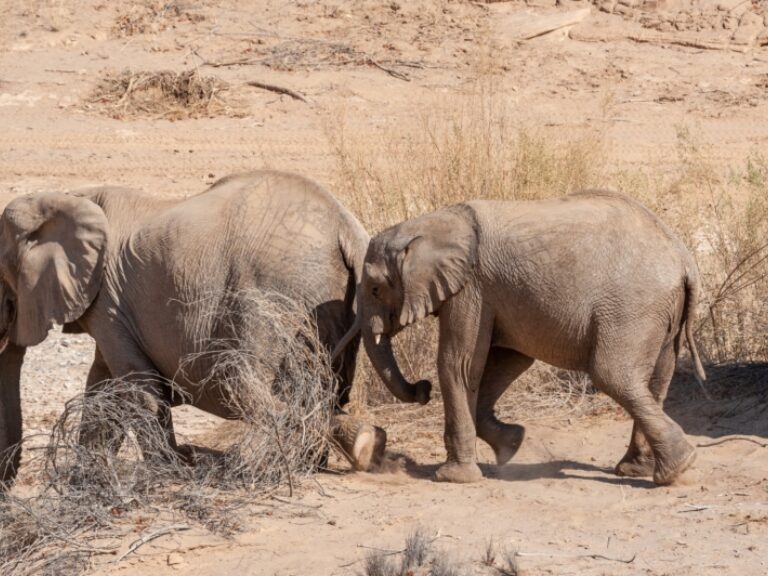
See Namibia’s rare desert dwelling elephants
You might only see a few animals here, but tracking Damaraland's desert-dwelling wildlife is a highlight in this fascinating region sandwiched between Etosha National Park and the Skeleton Coast.
Desert-adapted elephants, rhinos, and lions roam rocky terrains, dry riverbeds, and gravel plains dotted with the weird, twisted welwitschia mirabilis plants.
Although it can be challenging to see the wildlife here, I find this scarcity makes each sighting all the more memorable. Spotting one elephant in the desert is somehow more special than seeing an entire herd in a lush reserve.
Desert-dwelling elephants are considered an endangered subspecies and occur in five rivers usually devoid of water: the Ugab, Huab, Uniab, Hoanib and Hoarisib. These elephants have larger feet to walk on sand and travel in smaller herds. They only need to drink once every few days, using their long trunks to dig for water in the dry river beds.
Also here is Twyfelfontein, home to one of Africa's most significant collections of rock art, with over 2,500 engravings dating back some 6,000 years.
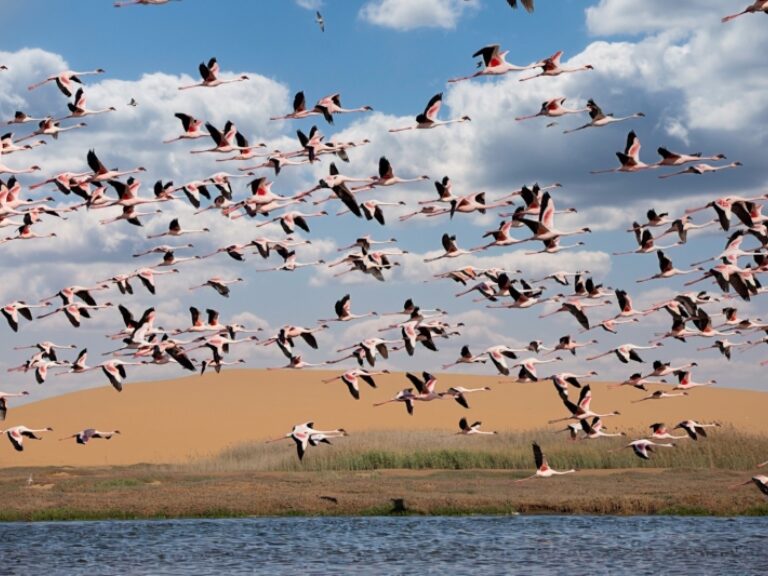
Birding on the Atlantic Coast
Although more industrial, these coastal towns harbour great wildlife opportunities coupled with creature comforts (don’t miss oysters and cold Namibian beers from the seaside restaurants in Swakopmund).
The expansive tidal lagoon south of Walvis Bay is primarily a birding attraction, hosting thousands of flamingos, pelicans and cormorants. Boat tours along the coast also provide a front-row seat to colonies of seals, and sometimes dolphins cruise the bow waves.
Inland, you can walk the coastal dunes searching for desert critters, such as the comical palmato gecko with its transparent skin, beautiful colours, and sand-disguised sidewinding snakes.

A lone oryx in the vastness of the Sossusvlei clay pans, Namibia
Namibia safaris: Need to know
Everything you wish you'd known before you booked, when to go on safari in namibia.
Namibia has diverse landscapes that shine at different times of the year. Typically, the best time for wildlife viewing is the dry season (May to October), while the wet season (November to April) transforms the desert into a blooming wonderland ideal for photographers and birdwatchers.
You can of course book an organised tour of Namibia with any number of safari operators. The standard itineraries typically include Etosha, the Sossusvlei claypans, Swakopmund and the Fish River Canyon. There are a few advantages of booking an organised tour, not least convenience and the extra reassurance of help and support while you navigate an unfamiliar country.
That said I’d encourage more independently-minded visitors to consider a self-drive trip. This way you can get well off the standardised itineraries and spend as long as you like in some of Namibia’s hidden gems mentioned in this guide. You can rent a 4X4 in Windhoek or Walvis Bay, and book your own accommodation directly. Hotels and lodges generally offer their own guided excursions and tours (for an additional fee.) But don't rush: fight the urge to cram too many sights into a short trip, or your trip will be exhausting. And be prepared for the challenge of driving. The distances between the various safari areas and national parks are huge, but the roads are often decent gravel. Plan a buffer day into your itinerary in case something goes wrong with the vehicle and ensure you have sufficient fuel. Some routes are 300 to 400 kilometres without gas stations. In my experience, most rental companies have great insight, so ask away! They will know the best routes and ask if they offer satellite phone rental or emergency assistance.
- Southern Africa
If you have the bucks, the NamibRand Nature Reserve is where I like to escape the masses that can crowd Sesriem at the entrance to Namib-Naukluft National Park. There are luxury lodges here, such as Kwessi Dunes or &Beyond Sossusvlei Desert Lodge, which are well-regarded if pricey. I prefer the organised overnight walking safaris: light pollution is minimal here and the skies are among the darkest and clearest on earth. Immersed in the silence of the desert darkness, I experience a humbling connection to the cosmos.
At a glance
Physical level.
Melanie is a travel photojournalist and guidebook author based in Johannesburg. A qualified field guide, scuba diver and budding birdwatcher, she is an expert contributor on Southern Africa and has written for Lonely Planet, Travel+Leisure, Condé Nast Traveller and Fodor's, and photographed some of the continent's beloved travel lodges.
While you might be disappointed that the balloon doesn't actually cross over the Sossusvlei or Deadvlei claypans, there is freedom in being beholden to the desert winds. Dramatic views from a balloon basket offer an eerie sense of the vastness and solitude of the Namib Desert, evoking a deep appreciation for this untouched wilderness. We even spotted a brown hyena scuttling across the sands below during my flight. Be prepared for a rudely early wake-up call. It's best to stay close to the launch site at Kulala Desert Lodge, or the kitschy Le Mirage Desert Lodge and Spa.
The Sesriem junction is the starting point for trips to the Sossusvlei and Deadvlei claypans. To experience sunrise (or sunset), beat the heat and get ahead of the crowds, spend the night at one of two lodges located within the park gates (Sossus Dune Lodge and the pricier, more private Kulala Desert Lodge). Alternatively camp at the very basic Sesriem Camp for the perk of an hour-early entry to the park. It's a 60-kilometre drive to the Sossusvlei and Deadvlei sites (many visitors stop at Dune 45 instead, but I recommend you forge on). Deadvlei is then a further one-kilometre hike from the car park (not everyone is fit enough for this trek, especially in peak sunshine) and is where you can climb the spine of the Big Daddy Dune.
Bwabwata National Park has limited accessibility and few self-drive routes, but the wildlife is no less dramatic than other popular parks.
My favourite area is Horseshoe Bend in the Mayuni Conservancy zone, with its abundant plains animals. Elephants congregate here in their hundreds on their migration route between May and September, and it's where I snapped my first magazine cover shot. Nambwa Campsite and Nambwa Lodge (a treetop stay with high walkways for elephants to wander freely below) are the nearest accommodations.
The park can get busy in peak seasons, impacting the sense of wilderness. Also, consider exploring the less-visited Nkasa Rupara National Park nearby.
Wolwedans is one of the most established lodge collections in the country, with enviable locations dotted across the NamibRand Nature Reserve. I loved how committed this operation is to treading lightly, and I had tremendous fun gliding along, up and down, over the dunes of the Namib Desert by horseback and bike.
Whether a flat-out gallop or a sedate trek, all levels of riders are welcome to wind between the “fairy circles”, mysterious barren patches amid the desert flora that have long perplexed scientists. Theories range from plant self-organisation to toxins from euphorbia bushes. Still, my favourite story is the Himba explanation that they are the footprints of Mukuru, their supreme being.
Etosha's waterholes provide an excellent David Attenborough-worthy opportunity to witness wild animals up close. Watch elephants slake their thirst under the scorching sun or detect the sounds of rustling leaves and animal calls as giraffes, zebra and impala tentatively gather during the evening.
The Okakuejo's floodlit waterhole is a great spot to glimpse the critically endangered black rhino.
I recommend you book accommodation in advance during peak season, weekends, and festive December. Alternatively, visit during the wet season when the landscape is greener, but water availability causes animals to disperse.
Etosha is surrounded by other private game reserves and luxurious places to stay, including Anderssons at Ongava (I have my heart set on visiting the Ongava Discovery Centre next) and Onguma Camp Kala.
Head out on a game drive or an immersive (though sometimes hot and long) walking safari to track the world's last remaining free-roaming population of the critically endangered black rhino.
I always find Rhino tracking a heart-pounding adventure. A dance of anticipation and caution as you trek the rugged landscape. Palmwag Concession is the best area, and top sightings generally occur between April and November, but stay at least two days to up your chances of seeing the rare animals.
Well established, the Desert Rhino Camp is high-end, but Damaraland Camp, Camel Top Community Campsite, Palmwag Lodge and Sesfontein Guesthouse are affordable alternatives.
So many people visit the iconic dunes of Sossusvlei but don't notice the phenomenal creatures that eke out an existence in this extraordinary landscape. Unlike other deserts, critical ocean mists feed the Namib sands and sustain fog-sipping beetles, nude-coated lizards and handsome snakes that bury themselves in the sand. They’re tricky to find by yourself, so get a guide to share their tips and tricks for seeking out the small stuff.
Enjoy a unique desert sea safari by kayaking amidst playful marine companions. Departing in the morning when the waters are calm, this three-hour tour has you paddling towards the Walvis Bay Cape fur seal colony, where it's common for them to swim close and sometimes even hop onto the ends of the kayaks! I also spotted dolphins, pelicans, flamingos, and Damara terns on the Pelican Point sandbar. Be sure to dress warmly. If kayaking isn't your thing, you can also opt for sedate boat tours.
About the author
Featured tours
Other guides you might like, safari in kenya, kenya's best safari reserves and camps.
Stuart Butler
South africa safari, an expert guide to south africa's best safari parks & reserves.
Anthony Ham
Wildebeest migration safaris, an essential guide to planning a migration safari in tanzania and kenya.
Hans Cosmas Ngoteya
Safari in zambia, an expert guide to zambia's best safari parks, camps & lodges.
Sarah Kingdom
Safari in tanzania, an expert guide to tanzania's best safari parks & camps, safari in botswana, an expert guide to botswana's best safari reserves, camps and experiences, where and how to see the big 5 on safari in africa, safari in africa, our travel writers' top africa safari picks, zimbabwe safaris, an expert guide to the best safari camps in zimbabwe, chimpanzee trekking, an expert guide to seeing chimpanzees in the wild.
Philip Briggs
Why horizon guides.

Impartial travel guides
Our guides are written by the leading experts in their destinations. We never take payment for positive coverage so you can count on us for impartial travel advice.

Expert itineraries
Suggested itineraries and routes to help you scratch beneath the surface, avoid the tourist traps, and plan an authentic, responsible and enjoyable journey.

Specialist advice
Get friendly, expert travel advice and custom itineraries from some of the world's best tour operators, with no spam, pressure or commitment to book.
Our guides are 100% impartial and are written by independent, professional travel journalists. We make money by charging carefully-screened travel companies to list their business on our website. Our advertisers have no influence on our editorial content and we never accept payment for positive coverage.
Read more about how we work and what we believe in here .
- Travel guides
- Work with us
Sitemap , Privacy Copyright © 2024 Horizon Guides
- Kilimanjaro Besteigung
- Mt Meru Besteigung
- Mt Kenia Besteigung
- Gorilla Trekking
- Private Safaris
- Private Touren
- Flugsafaris
- Mobile Explorer Camp
- Afrika Reiseblog
- Self-Propelled

- Veranstaltungen
- Afrika - aus den Augen unserer Guides
- Hintergrundinfos
- Reiseberichte
- Afrikanische Küche
- Zur Blog Übersicht
Veröffentlicht am 8. April 2024 von Juan Proll
Die beste Reisezeit: Namibia im Juni
Entlang der Küste, im Hochland, hinein in die Namib und in die Kalahari oder durch üppige Wälder bietet Namibia traumhafte Reisemöglichkeiten auf geführten Rundreisen oder für Selbstfahrer*innen. Und trotz der enormen Trockenheit des Wüstenstaates ist Namibia im Juni ein echtes Highlight und einer der beliebtesten Reisemonate, wie der heutige Blog zeigt.
Inhaltsverzeichnis
Unser Tipp für Juni-Reisen: Frühzeitig buchen
Im Juni beginnt in Namibia die Hochsaison und damit die beliebteste Reisezeit. Gleichzeitig herrscht Trockenzeit, die beste Zeit für Tiersichtungen im beliebten Etosha Nationalpark. Das Land und die Unterkünfte füllen sich mit Touristen. Es macht also Sinn, frühzeitig zu buchen, insbesondere wenn du bestimmte Unterkunfts-Wünsche hast. Denn die beliebtesten Lodges und Camps sind in der Regel schnell ausgebucht. Zwar bietet das Land oft qualitativ gute Alternativen, aber meist in größerer Entfernung. Deine Namibia-Reise bis zu einem Jahr im Voraus zu buchen, lohnt sich! Schicke uns hier deine Anfrage !

Wie ist das Wetter in Namibia im Juni? Heiße Tage und kühle Nächte
Mit der Trockenzeit im vollen Gange wird Namibia im Juni noch dazu spürbar kälter. Der ‚Winter‘ auf der Südhalbkugel beginnt, die kürzer gewordenen Tage wandeln sich zu längeren. In diesem Monat ist es im Allgemeinen trocken und regenfrei mit angenehmen Tagesdurchschnittstemperaturen, die in den meisten Landesteilen bei um die 21° bis 22° C liegen. Kein Grund also, sich zu beklagen. In der Nacht fallen die Temperaturen zunehmend auf Werte zwischen 6° und 8° C, in höher gelegenen Orten wie der Hauptstadt Windhoek oder in der Wüste vereinzelt bis auf 0° C. Nur selten geht es mal darunter.
Zwei unserer Lieblingstouren in Namibia im Juni:

Faszination Namibia
Besuchen Sie auf dieser deutschsprachigen Lodge Safari in einer Kleinstgruppe die Highlights Namibias, von der Namib Wüste und dem Sossusvlei im Süden bis zum berühmten Etosha Nationalpark im Norden.

Namibia Highlights
Erleben Sie Namibias ungeheure Weite und Einsamkeit. Diese 13-tägige Namibia Rundreise für Selbstfahrer führt Sie zu den größten Highlights Namibias, von der Namib Wüste bis zum Etosha Nationalpark.
Namibia Safari im Juni: Der Nordosten – Sambesi-Region
Besuchst du im Juni die Nationalparks im Sambesi-Streifen (der frühere Caprivi-Strip), geht es selbst in diesem Monat nicht ohne einen 4×4 Geländewagen. Wenn es auch nicht durchgängig feucht bis sumpfig ist, so können einige Stellen zumindest sehr tiefsandig sein. Auch die Einsamkeit vieler Abschnitte spricht dafür, hier nicht allein, sondern am besten mit Freunden oder Familie in zwei Fahrzeugen oder auf einer Gruppentour unterwegs zu sein. Alternativ kannst du deinen Mietwagen auch in deiner Unterkunft parken und dich für die Pirschfahrten in den Nationalparks einem lokalen Guide anschließen.

Wildtierbeobachtungen sind in der Trockenzeit in der Regel gut, aber in der dichten Vegetation der Sambesi Region trotzdem nicht immer leicht. Immerhin dünnt das Buschwerk im Juni aus, nehmen die Wasserstellen ab und sammeln sich die Tiere an den verbleibenden Quellen. So kannst du neben wasserliebenden Antilopen wie Lechwe, Sitatunga oder Waterbuck auch Löwen, Leoparden, Elefanten, Büffel, Nilkrokodile, Flusspferde und andere Tiere mehr sehen. Nur die migrierenden Tiere, die aus dem nördlichsten Namibia und den Nachbarländern hier auf ihrem Weg zum Okavango Delta oder dem Chobe Nationalpark durchkommen, haben die Region größtenteils bereits wieder verlassen.
Zu den Nationalparks hier gehören der Nkasa Rupara Nationalpark, Namibias größtes geschütztes Feuchtgebiet, das je nach Wassermengen an ein kleines Okavango Delta erinnert, der Mudumu Nationalpark mit seinen Herausforderungen für Off-Road-Fans, und der Bwabwata Nationalpark, wo Menschen und Wildtiere in friedlicher Koexistenz nebeneinander wohnen. Südwestlich vom Bwabwata unterscheidet sich der Khaudum Nationalpark allerdings sehr von seinen Nachbarn. Er bietet Kalahari-Impressionen vom Feinsten und garantiert ein 4×4-Geländewagen-Erlebnis im tiefen Sand. Allerdings machen es die sehr trockenen Bedingungen in Namibia im Juni nicht immer leicht, viel Wild zu sehen, zumal auch hier die migrierende Tierwelt die Region größtenteils wieder verlassen hat. Südlich des Khaudum Nationalparks leben Angehörige der San, die ganzjährig offen für Kulturinteressierte sind und ihnen Einblicke in ihr traditionelles Leben gewähren.

Namibia-Reisen im europäischen Sommer: Der Nordwesten – Etosha, Spitzkoppe, Cape Cross & Wüstenelefanten
In Namibias Nordwest-Viertel findest du den berühmten Etosha Nationalpark . Vier der Big Five sind hier mit den Löwen, Elefanten, Leoparden und Nashörnern vertreten. Tierbeobachtungen im Etosha Nationalpark werden im Juni aufgrund der fortschreitenden Trockenzeit zunehmend leichter. Dafür ergraut die Landschaft um dich herum. Auch an den beleuchteten Wasserlöchern vor den Unterbringungscamps siehst du mit der nötigen Geduld Wildtiere. Hab aber etwas Wärmendes zum überziehen dabei, wenn es irgendwann spürbar abkühlt. Westlich des Parks liegt zwischen der Landstraße C43 und der Küste das Kaokoveld, das sich bis in den hohen Nordwesten hinein zieht. Hier lebt das spannende Volk der Himbas, die ebenfalls hochinteressante Einblicke in ihre traditionsreiche Lebensweise gestatten.

Im südlichen Teil des Kaokovelds und darüber hinaus schließt sich zwischen Opuwo und dem Brandberg bis hinunter zur Küste des Skeleton Coast Nationalparks ein riesiges, frei zugängliches Wildgebiet ohne Zäune an. Hier trotzen Wüstenelefanten , wüstenangepasste Giraffen, Zebras, Nashörner, Springböcke, Leoparden und viele andere im Juni den widrigen Dürrebedingungen. Wenn es dann die Wüstenlöwen und Schakale der Region zum Fressen bis an die Küste der Namib zum Atlantischen Ozean zieht, können sie im weltweit einzigartigen Robbenparadies von Cape Cross zwar nach Beute suchen, aber nicht das Meerwasser trinken. Im Juni sind die meisten erwachsenen Robben längst zurück im Ozean. Dennoch kannst du eine gewaltige Menge von jungen Robben sehen und auf einem Boardwalk mitten hindurch spazieren.
Über die etwas angenehmeren Tagestemperaturen in Namibia im Juni kannst du dich auch bei zwei weiteren besuchenswerten Sehenswürdigkeiten in diesem riesigen Gebiet freuen. Zum einen sind da die faszinierenden Granitformationen der Spitzkoppe , einem Inselberg mit verschiedenen San-Kunst-Zeichnungen. Zum anderen beeindruckt die UNESCO-Weltkulturerbestätte Twyfelfontein mit ihrer in Sandsteinfelsen gravierten San-Kunst, dessen Komplexität im gesamten südlichen Afrika einzigartig ist.
Du willst mehr über Namibia-Reisen erfahren? Wir beraten dich gerne. Melde dich bei uns !
Namibia im Juni: Der Südwesten – Swakopmund, Lüderitz & Sossusvlei
Dieses Viertel des Landes erzählt mit den ehemaligen und immer noch schön anzusehenden Kolonialstädten Swakopmund und Lüderitz sowie der Geisterstadt Kolmanskop die Geschichten deutscher Vergangenheit. Obwohl Swakopmund häufig unter einer kühlen Wolkendecke liegt, lädt es auch im Juni mit seiner langen Promenade und netten Cafés zu einem Strandaufenthalt ein. Baden ist in dieser Zeit aber nur etwas für Unerschrockene, die kaltes Wasser ab können … Großartige Ausflüge, zum Beispiel in die Wüste, kann man von hier das ganze Jahr über unternehmen, also auch im Juni. Ähnliches gilt für den Ausgangsort deutscher Kolonialisierungsaktivitäten, der südlichen Küstenstadt Lüderitz. Nur wenige Kilometer außerhalb bilden die Ruinen der Geisterstadt Kolmanskop inmitten der Wüste ein landschaftlich und geschichtlich beeindruckendes Zeugnis des deutschen ‚Kolonialwahns‘.

Zwischen den beiden Hafenorten liegt das UNESCO-dekorierte Sandmeer vom Sossusvlei , wo riesige Dünen die Landschaft dominieren und zu den höchsten der Welt zählen. Darin versteckt liegt das Dalí-esk erscheinende Deadvlei mit seinen toten Baumskeletten. Im Juni ist der Weg dorthin durch den Tiefsand in der Regel weniger heiß und schweißtreibend.
Die kalte Jahreszeit in Namibia: Der Südosten – Fish River Canyon
Der Fish River Canyon liegt auf dem Übergang vom Südwesten in den Südosten. Es ist Afrikas größte Schlucht und jederzeit ein sehenswertes Naturphänomen. Im Juni ist es darin kühl genug, um den Canyon auch für Mehrtageswanderungen freizugeben. Zwei Stauseen halten die Wassermassen auf und den Weg frei. Erfrischende Regenschauer wären dennoch wünschenswert, bleiben im Juni aber aus. Zurück in nördliche Richtung liegen nur einige Kilometer außerhalb von Keetmanshoop der Köcherbaumwald und der Spielplatz der Riesen . Der Spielplatz der Riesen beeindruckt frühestens ab 15 Uhr nachmittags mit seinem besonders weichen Licht. Dagegen verzaubert der Köcherbaumwald vor allem zum Sonnenaufgang oder Sonnenuntergang mit sanften Lichtdurchflutungen. Wer seinen Rückweg nach Windhoek durch das rote Dünenfeld der Kalahari macht, kann im Juni schon sehr gut die großen Temperaturunterschiede zwischen Tag und Nacht erleben.

Fazit: Ist der Juni eine gute Reisezeit für Namibia?
Im Reisemonat Juni ist in Namibia Hauptsaison . Die bereits fortgeschrittene Trockenzeit dünnt die Vegetation aus und konzentriert das Wild an immer weniger Wasserstellen. Das macht das Beobachten der Tiere einfacher. Gleichzeitig sinken die Temperaturen im Durchschnitt auf tagsüber angenehme 21° bis 22° C. Auch Wanderfreunde kommen nun auf ihre Kosten. So füllt sich das Land zunehmend mit Touristen, weshalb du frühzeitig buchen solltest. Der Juni ist einer der beliebtesten Reisemonate in Namibia.
Namibia im Juni ist also immer eine Reise wert. Für Rückfragen und weitere Unterstützung bei der Planung deiner Reise stehen wir gerne bereit, egal ob auf einer geführten Tour oder Selbstfahrer*in-Reise unterwegs. Dank unseres engen Kontaktes zu unserer Tochterfirma in Namibia wissen wir über die aktuelle Lage immer gut Bescheid. Also melde dich bei uns ! Dein Traum, unsere Expertise – Dein ganz individuelles Namibia-Erlebnis.
Das könnte dich auch interessieren

Reisen war schon immer Juans große Leidenschaft: Drei Jahre in Lateinamerika, zwei Jahre in Südostasien und Ozeanien sowie „Kurzreisen“ bis zu neun Monaten in Europa und Nordafrika. 2010 entschied er sich, seinen Beruf in Deutschland als Lehrer der Erwachsenenbildung und Leiter eines Kompetenzzentrums für Migrationsfragen an den Nagel zu hängen und in Südafrika Ranger zu werden. Seit 2011 ist Juan nun im südlichen Afrika unterwegs. Zunächst machte er seine Nature-Guide-Ausbildung und arbeitete in einem ‚Big Five‘ Wildreservat, bevor er Mitte 2013 zu Elefant-Tours wechselte. Mit weiteren Ausbildungen und intensivem Selbststudium zum Cultural Guide in Südafrika und Namibia hat Juan seitdem sein Wirkungsfeld über die Tierwelt hinaus auf „Land & Leute“ in Südafrika und Namibia ausgedehnt. Juan ist Mitglied im Berufsverband „Field Guides Association of Southern Africa“. In unserem Blog schreibt er darüber hinaus über den afrikanischen Alltag in unseren Reiseländern, er informiert über Hintergründe, gibt Reisetipps und verrät kulinarische Besonderheiten.
Passende Schlagwörter
Namibia safari – The complete guide for first-time visitors
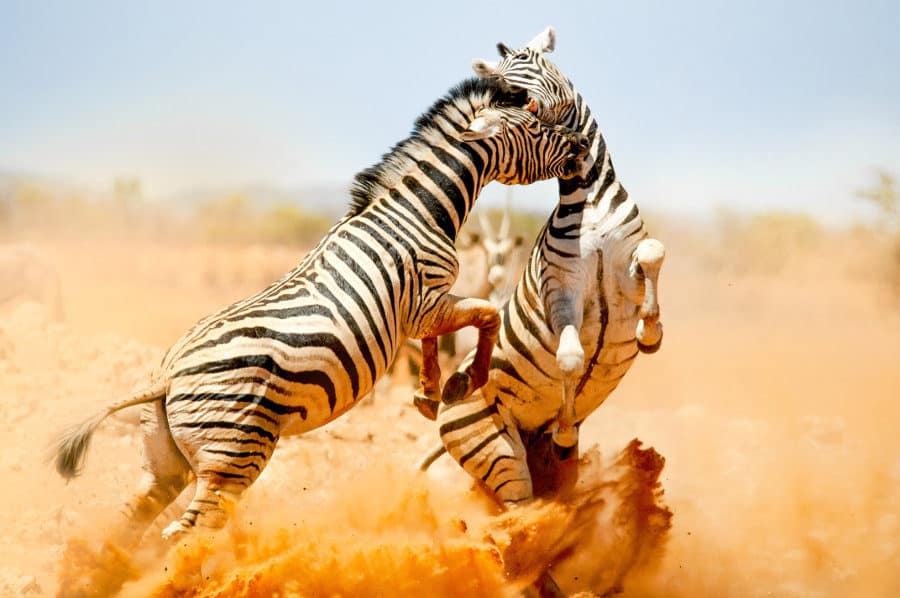
Namibia isn’t known for safari . This is Africa’s natural art gallery, a country of superlative landscapes and breathtaking silence.
Most people don’t even think a Namibia safari is possible. How can wildlife thrive in the desert? Why visit Namibia when Botswana and South Africa are next door?
Yet desert-adapted elephants make epic journeys across the sand. Rhinos gather around salt pans. Black-maned lions survey their dusty kingdoms. Gemsbok are everywhere, their majestic horns a symbol of Namibia.
A safari in Namibia can be as good as a safari anywhere else in Africa. It’s just a little different and you don’t have the same multitude of destinations.
This article guides first-time visitors through Namibia’s best safari destinations . It covers when to go, what to do, how to reduce costs, and how to make the most from the experience.
5 Compelling Reasons to Visit Namibia For Safari
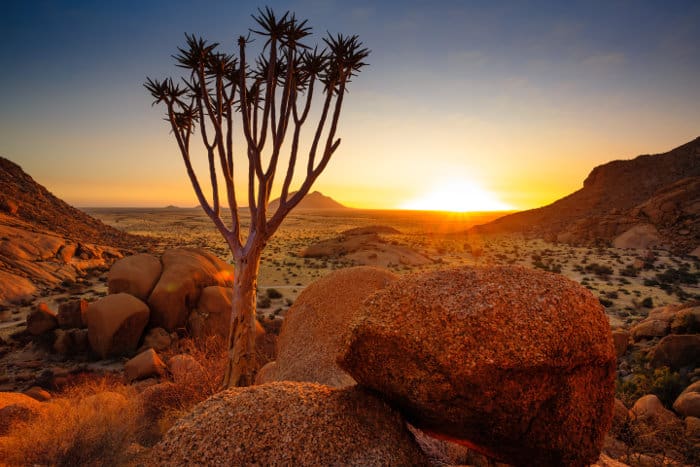
1. Africa’s natural art gallery
Namibia requires time . It’s one of the world’s most sparsely populated countries and it’s difficult getting around. There’s virtually nothing other than wilderness. Even a town that’s signposted for 500 kilometres passes by in the blink of an eye.
Most of the land is inhospitable . Western Namibia is covered by the world’s greatest sand dunes, a barrier too inpenetrable for even the rampaging colonialists.
Eastern Namibia is dominated by the Kalahari Desert , barren plains that bake beneath the sun. Scattered through these deserts are some of Africa’s most surreal sights.
The Fish River Canyon , stark and evocative as it cuts a path through Africa’s crust. It’s the world’s second largest canyon and you can read our guide here .
Then the Namib Desert , where Sossusvlei and Deadvlei are just the famous attractions in a landscape of kaleidoscopic dunes. Read our complete Namib Desert guide here .
Damaraland is all strange rocks and massive mountains, an ethereal assortment of shapes and silence.
The desert has even taken over towns. Luderitz and Kolmanskop are a poignant reminder of nature’s power, where old wooden houses are now buried in sand.
These highlights make for an inspiring adventure. In Namibia there is more than safari and that is one of the big highlights. The vacation is more diverse and it’s also a lot cheaper when you don’t need to pay park fees every single day.
2. Animals are easy to find
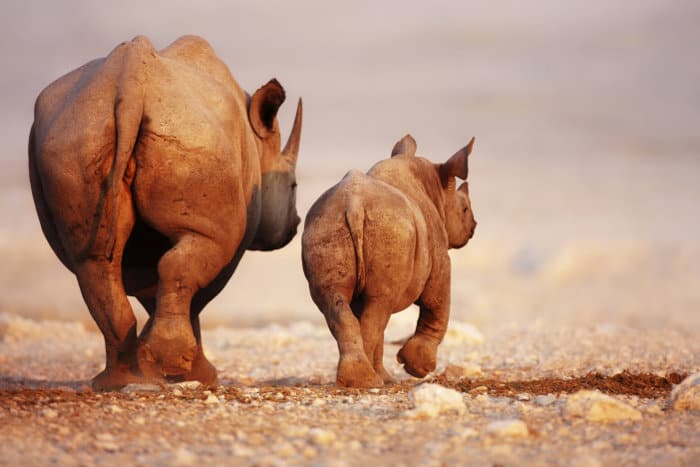
Although it sounds counter-intuitive, such an inhospitable environment makes the safari incredibly easy .
Life in the desert revolves around water . Animals must cluster close to where water remains. So every Namibia safari focuses on waterholes, pans or rivers. Find the water and you find the animals.
Vegetation is sparse . There are very few places for wildlife to hide. Again, this makes wildlife encounters easy. Just gaze across the desert and you can spot herds from miles away.
3. Living with giants
You must be tough to survive here . So step forward desert-adapted elephants, white rhinos, Angolan giraffe and some of Africa’s most elegant antelope species .
In terms of actual numbers there are less large mammals in Namibia than Botswana , South Africa , Kenya or Tanzania . However, as these animals gather in similar places it’s possible to experience a superb wildlife diversity in one place.
Most importantly, Namibia is where you get close . It’s where you feel the battle for survival and experience life on the edge. It’s one thing to see an elephant in a lush forest. It’s quite another to see the emotion on an elephant that has travelled five days to reach water.
Evocative scenes play out. Enchanting gestures communicate how these animals feel. There’s joy and energy. And then there is the brutal reality of life .
Perhaps a carcass being picked at by African vultures . Maybe a wounded animal stumbling away from a battle to mate; or lions tossing bones from a zebra carcass.
4. Africa’s cheapest safari
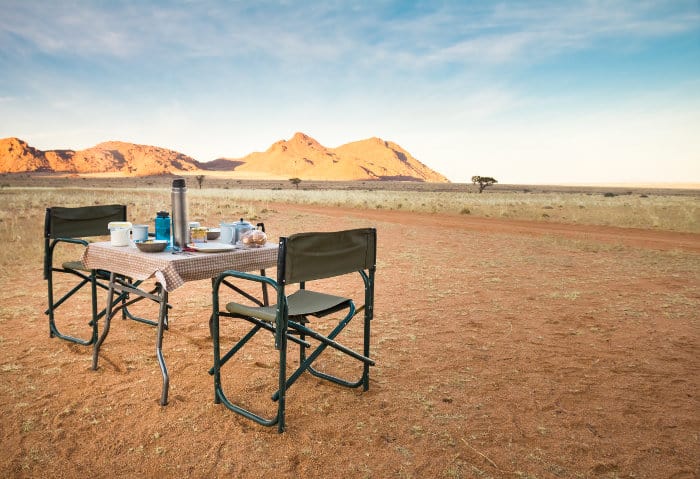
Probably the biggest reason for choosing a Namibia safari is the cost . Here you get the most intense encounters for the best price.
Park fees are lower than other Southern African countries and significantly less than in East Africa.
The camps and lodges are usually modest , without the thrills and luxuries of some in South Africa. Most of them are at the lower end of the price scale, which is very different from Botswana where camps could be USD 1000 per person a night.
Namibia’s public campsites are excellent . They are simple and well maintained, located in areas that can be rich in wildlife. Anyone who is self sufficient will find these camps accessible and cheap.
While Namibia is an enormous wilderness country the safari destinations are relatively easy to reach . A four-wheel drive vehicle is required.
But it’s not like in Botswana where flights are necessary to reach parts of the Okavango Delta , or in East Africa where it’s almost impossible to visit without a local tour.
Namibia is so vast that you don’t need to escape the crowds . You can have a private concession-style safari experience, full of exclusive natural encounters, without needing to pay a premium.
5. The best country for a self drive safari
Excellent camps , easy to find wildlife , and accessible destinations . That adds up to a great self drive destination. You do the safari and this is cheaper than a tour.
The classic way to explore Namibia is to rent a four-wheel drive vehicle that is equipped with a popup roof tent, a camp kitchen, and everything that’s needed for multiple days in the wild.
Visit the national parks , spend the days on safari, then set up at one of the campsites. It’s raw and rugged , an adventure in elephant country with no guides to protect you.
Self drive safaris are not advisable in East Africa – rules and regulations make them expensive and dangerous. One Africa Freak contributor encountered two backpackers in a Toyota hatchback stuck in the Serengeti mud, leaning out of the window taking photos of lions.
South Africa is good but doesn’t have the same wilderness factor , not when the Kruger now has a paved road through the middle of it.
Much of Botswana’s best safari destinations are inaccessible, either because the roads are washed away or the area has been gazetted as a private concession.
Then there is Namibia: freedom , beauty , safari and a connection with your wild side.
Guide to Namibia Safari Destinations
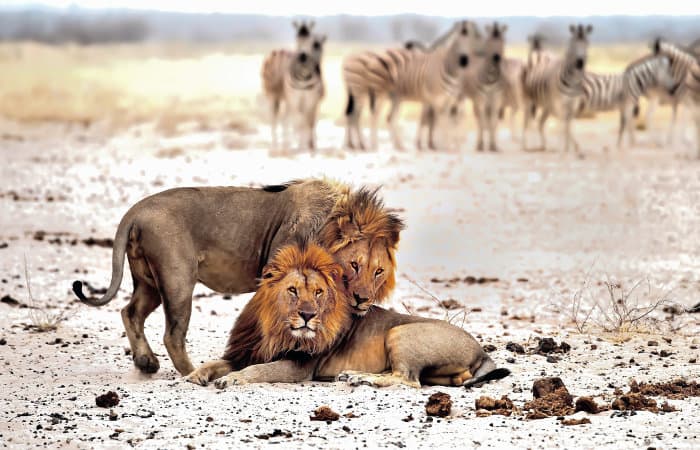
Etosha is one of Africa’s ultimate safari destinations. The rest in Namibia is good and exciting. Visit Namibia and Etosha has to be at the top of the list. If you can, add on the Caprivi Strip for an experience in contrasts.
Etosha National Park
Etosha has an eternal paradox . Like all of Namibia there is an incredible sense of wilderness and exploring a distant piece of old Africa. Yet Etosha is also very accessible and the game viewing is so simple.
There’s comfort and simplicity here, even when gazing across the shimmering Etosha salt pan. Within Etosha there’s the only water for hundreds of miles. That attracts a great succession of migratory mammals during the dry reason.
Often there’s a mystical collection of animals at a waterhole, a kind of animal party featuring hippos, gemsbok , impala, elephant, zebra and giraffe. Then the lions come and transform the dynamic.
The Etosha savannah is scorched yellow and red. Vegetation shrivels and a lot of the park appears lifeless. At the park’s heart is the Etosha Pan , a mammoth salt bed that the park is named after (Etosha literally means great white place ).

Antelope splash about the pan after the rains. Elephants and buffalo dig for the nourishing salt. Gaze across the pan and rhinos emerge from the mirage, the image like something from a work of fiction.
After the pan shrivels and dries, life revolves around the park’s different waterholes . Most camps overlook one of these waterholes so a lot of the safari can be spent sat on a balcony, drinking a beer as wildlife also takes a drink.
The Etosha camp accommodation is very cheap in comparison to South Africa and Botswana, usually less than USD 150 per room for a very comfortable tented camp in a prime location (it may be USD 1000 in South Africa).
Public campsites aren’t next to the waterholes but are among migratory channels so you will see animals nearby. And every night the Etosha animals create their own noisy lullaby.
Animals to see and planning an Etosha visit
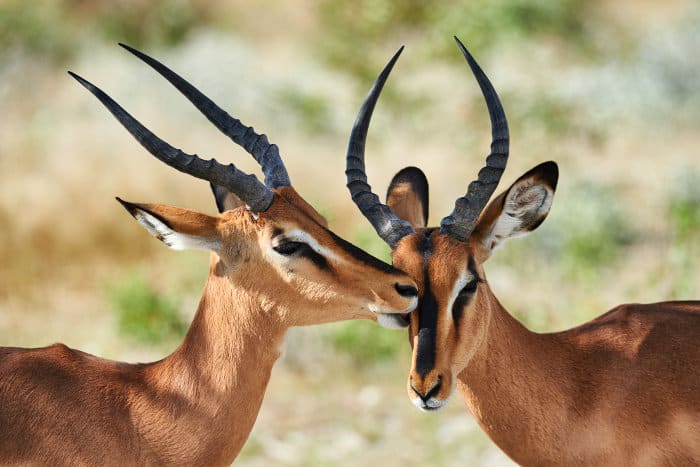
Etosha is home to four of the big five . It’s one of the best places in Africa to see white rhinos and their abundance is quite remarkable here.
Elusive species like black-faced impala are common. Tense predatory scenes are witnessed around the waterholes.
There’s just about everything you could ask for in a safari destination and the ease of the game viewing is elevated by Etosha’s openness . Spotting wildlife is straightforward, even without a guide.
Etosha is located in northern Namibia , roughly a four-hour drive from capital city Windhoek and seven hours from the Caprivi Strip.
Allow at least three full days . The park is big and there is more than enough wildlife for three days. Ideally consider four nights, allowing for two nights in two different sides of the park.
Ongava Game Reserve
A private concession in southern Etosha, Ongava is a luxurious and expensive destination. It’s typically included on high-end safari itineraries that use light aircraft to hop around the country.
The key highlight is the walking safaris , in particular walking safaris with white rhinos. Nighttime game drives and photography hides add to the intimacy.
Wildlife is similar to Etosha and there are only a dozen guests at a time , so it does feel very personal. Still, it’s debatable whether Ongava is worth the price when Etosha next door is so good.
Okonjima Nature Reserve
Halfway between Windhoek and Etosha, Okonjima can be a good Namibia safari introduction . The park is small and fenced but does provide good wildlife encounters, particularly with the cats.
Okonjima is home to the Africat Foundation that helps to rescue and rehabilitate Africa’s carnivores. These cats are in addition to free roaming wild predators. You will need to stay at the lodge in the reserve and one night is sufficient.
Caprivi Strip
Namibia’s fertile panhandle is a surreal contrast to the country’s desert wilderness. Forests and grasslands flourish as four of Africa’s great rivers take root: the Okavango, Zambezi, Chobe and Kwando .
These rivers attract migratory herds throughout the dry season, from various antelope to many thousands of elephant. Many animals stop by the Caprivi as part of their journey to the Okavango Delta or Chobe.
Animals and villages must coexist in the Caprivi. This makes sense: in a desert country almost everything wants to be near a river . There is no single national park but a series of small national parks interspersed with villages and a paved highway heading towards Victoria Falls.
Some of these have been established by local communities and the Caprivi Strip is a celebration of locally organised conservation .
Here there’s an acknowledgement that local people have been integral to conservation since the dawn of time. They’ve found a modern solution that satisfies the needs of wildlife, local people and tourists.
Bwabwata is the largest of the parks, followed by Mudumu and Nkasa Rupara . There’s also Caprivi Game Park , Mashi Conservancy , Wuparo Conservancy and Salambala Conservancy .
Although they don’t share borders, these parks do help create a single wilderness . They have successfully ensured the preservation of one of Africa’s most important wildlife corridors. Here you will see elephants and many other animals crossing the highway.
Each has either a public campsite or a camp and the prices are very reasonable .
Animals to see and planning a Caprivi visit

There is a little of everything but mostly you encounter elephants and different antelope . Giraffe poke their heads up above the trees, buffalo march around and zebra are conspicuous.
Don’t expect many big cat encounters . Not many live here and the lush vegetation makes them difficult to find.
Local San guides may be able to show you a wild dog den, so visitors with patience can be rewarded with sightings of one of Africa’s most endangered species; read the full wild dog story here .
It’s relatively easy to cover any of the parks in a single morning or afternoon drive. To spend more than two nights in any of these parks doesn’t make sense.
The Caprivi is in the far north of Namibia and it’s literally a 400 kilometre strip that juts above Botswana. Follow the strip to the end and you reach Victoria Falls .
We’d recommend spreading the Caprivi journey over three days . With that you can spend a night in two parks or conservancies before leaving Namibia to visit Victoria Falls or Chobe in Botswana.
But if you are blessed with time then extend the journey. These peaceful parks provide a beautiful connection with your wild side . No other people, a handful of grazing animals, and a fertile wilderness.
When to Go on a Namibia Safari

Namibia has clearly defined seasons and these have an enormous impact on the safari experience.
June to August – dry season, mild temperatures, good game viewing
- Mild days and cold nights ; bring warm layers and expect to spend each evening around a campfire.
- Great dry season wildlife viewing with lots of animals around waterholes.
- Dusty skies which aren’t ideal for photography.
- Peak season can result in crowds, especially in parts of Etosha.
September to November – dry season, hot, excellent game viewing
- Hotter days and warmer nights; be prepared to sweat.
- Outstanding dry season game viewing ; there is hardly any water left so wildlife is highly concentrated.
- Less visitors compared to June to August.
- The rains usually start in November and usually come as a relief.
December to January – wet season, very hot, best avoided
- Very hot days in the desert.
- Occasional storms but it doesn’t rain that much in the desert.
- A surprising number of visitors as it is school holiday time in Southern Africa.
- Animals have dispersed so game viewing is more difficult .
February to May – wet season, warm and beautiful
- Namibia is incredibly attractive after the rains have come.
- You may experience storms but mostly these months have blue skies and warm temperatures .
- Wildlife looks healthy and you can see lots of babies.
- However, it’s harder to see animals as they are dispersed.
Planning a Namibia Safari

Namibia safaris often require intensive planning as you must decide how to get around. Overland tours are the most popular mode of travel. You are in a small group and usually spend one to two weeks traveling through Namibia.
For self drive safaris think very carefully about where to pick up and return the vehicle. There’s a superb loop from Windhoek: Windhoek, Damaraland, Etosha, Caprivi Strip, Victoria Falls, then returning via Botswana.
It’s very tempting to extend the journey by starting in Cape Town or Johannesburg but this does add a lot of miles and fuel cost to an already long journey. However, coming from South Africa allows for a route incorporating Fish River Canyon and Sossusvlei.
Another option is to take public transport to Windhoek and then continue the journey from there. Windhoek based tour operators can take you on a three or four-day trip to Etosha for a reasonable price.
The more expensive option is a fly-in safari . Beautiful views extend from the window as you fly to Namibia’s distant destinations. These are aerial safaris and maximize the time you have, ideal if this is a multi-country and you only have two weeks in total.
Map of Namibia’s Main Parks
There’s at least a dozen national parks in Namibia. Here’s the country’s major protected areas and where to find them on a map.
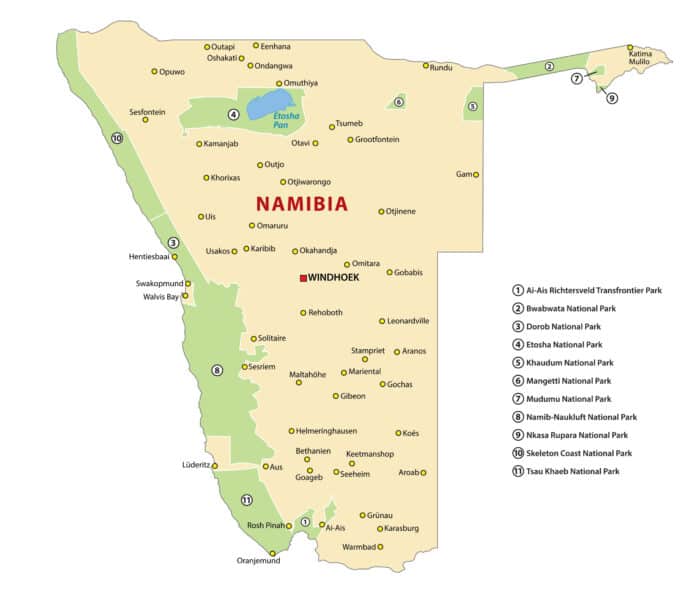
Good Luck in Namibia

We love Namibia . This is where you really connect with your wild side.
At first it seems like an endless empty wilderness. Spend time and look closer, because this is where safari secrets hide .
About The Author
Editorial Team
Related posts.

Cape Cross Seal Reserve: a smelly encounter
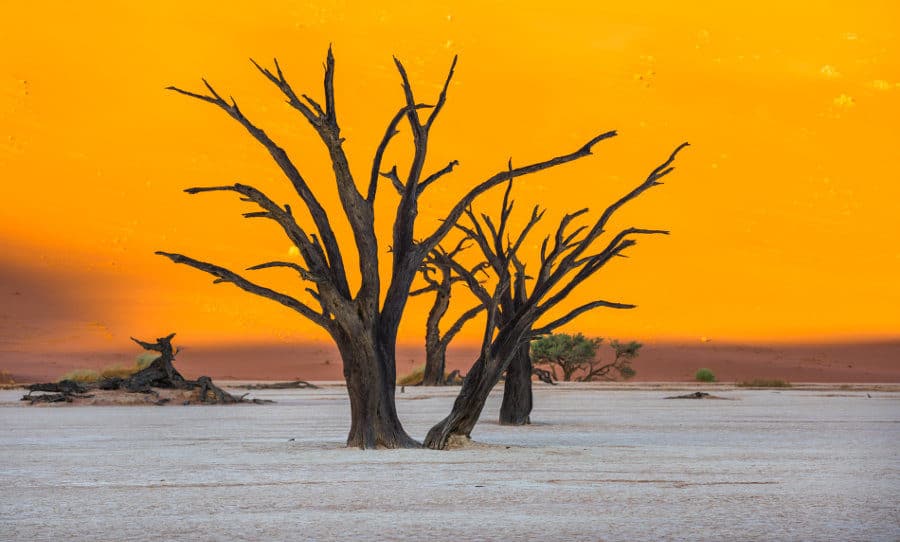
Deadvlei is far more impressive than Sossusvlei – Here’s why


Etosha National Park – The ultimate guide
2 thoughts on “namibia safari – the complete guide for first-time visitors”.
Is it easy to arrive in the capital of Namibia and get a 5, 6 day tour/safari in a local enterprise, that will be cheaper then the ones we find on the internet and we contacted previously when abroad? I mean, I would like to know if I arrive in Namibia will it be easy to find a safari organized by locals, that are cheaper then the ones I find on the internet?
Sure, it is definitely possible to organize your trip once you land in Namibia. There are various travel operators, especially in Windhoek.
That being said, I wouldn’t say it is necessarily “easy”.
It still requires time to organize things properly. You need to find a reliable operator, you might not have as many options… plus pricing will depend on the travel period (more expensive in the high season; in July-October).
NB: Namibia is the perfect destination for self drive safaris , so this could be a nice option to consider if you prefer more flexibility and freedom.
Hopefully this helps.
Happy planning,
Leave a Comment Cancel Reply
Your email address will not be published. Required fields are marked *

Namibian Highlights Accommodated Safari
Per person sharing.

Safari Description
This 7 day and 6 night accommodated safari is a tailor made opportunity to visit the best of Namibia in a perfect time frame.
Experience a moving insight into wildlife conservation and rehabilitation at the N/a’an ku se Wildlife Sanctuary before seeking amazing wildlife encounters in Etosha National Park. We are looking for predators and prey alike, lion and leopard, elephant and giraffe, black rhino and eland are all in the mix of possible sightings.
The mineral pan ‘’The Great White Space’’ from which Etosha takes its name is 22,000 square km of desolate, dazzling expanse, so big it can be seen from space.
Beautiful Damaraland gives us a unique ‘’Big Sky’’ experience, where the towering pink granite koppies seem to touch the very sky on our horizon. Stunning in every season this region of mountains and grassland, trees and riverbeds, desert elephant and desert rhino, puts real meaning into the words ‘’breath taking’’.
We meet some of the locals as we travel through Damaraland, Himba, Herero & Damara people, often in traditional dress, welcome us to their makeshift roadside stalls where they sell traditional hand crafts to the passing traffic. Onwards, westward, passing under the shadow of Namibia’s highest mountain, The Brandberg, we make our way down to the Atlantic Ocean.
Reaching the wild and rugged Skeleton Coast, we follow the ocean road into the unusual and quirky town of Swakopmund. Referred to by some as the adrenaline capital of Namibia, there are certainly some hair raising experiences on offer, but Swakopmund is also a place where you can relax and recharge.
Head for adventure on a magical trip to one of the most beautiful places on Planet Earth, the centre of the Namib – the oldest desert in the world. From the coast we cross the vast gravel plains that stretch inland for over 100km. We traverse high mountain passes and cross The Tropic of Capricorn on our way down to the dune fields.
A pre-dawn start to catch the soft light of sunrise as we head for Dead Vlei with its stark collection of skeleton trees and on to Sossusvlei, waters end for an ancient river. We watch out for wildlife, oryx and springbok are often seen in this sandy land but if we look and have sharp eyes, the dunes are also home to a full menagerie of reptiles, beetles, insects, rodents and birds. All these creatures are uniquely desert adapted survive in this waterless wonderland using super-power evolutionary adaptations. The Namib Desert is internationally recognised as a top biodiversity hot spot in a desert habitat.
Climbing a towering sand dune, 300 m from top-to-toe, is an experience unique to Namibia, Big Daddy, Big Mamma and Dune 45 are all waiting to be conquered if you are feeling intrepid and want to experience the view from such a lofty perch.
ONLINE BOOKING HERE!
- Etosha Village
- Desert Camp

Full Itinerary
Day 1: Windhoek Airport – Chameleon Backpackers, Windhoek City Centre – 50 km You will be collected from Windhoek International airport and transferred to Chameleon Backpackers Lodge close to the centre of Windhoek City. After checking in and having some time to relax, for clients who have arrived in Windhoek before 10:00 midday, there is an interesting and exciting excursion planned for the afternoon.
We will drive out to the internationally known N/a’an ku se Wildlife Sanctuary. Located about 50 km to the east of Windhoek. N/a’an ku se is a sanctuary dedicated to the rehabilitation of sick, injured and orphaned animals. The ultimate focus is to reintroduce these sometimes rare and endangered species back into their natural habitat so that they can live life wild and free. Sadly though, in many cases this is not possible. Some of the animals that come to N/a’an ku se would not, ever again, be able to fend for themselves in their native yet cruel natural environment. Instead they take ‘’early retirement’’ and find themselves a permanent home at N/a’an ku se. We will be introduced to several species, perhaps baboon, caracal, lion & cheetah. Wild dog and leopard are also living at N/a’an ku se together with a multitude of smaller mammals and we can watch some of the N/a’an ku se ‘’locals’’ have their supper.
Returning to Windhoek in the late afternoon. Dinner tonight is for your own account but your guide will be able to make bookings and recommendations for you from the many excellent restaurants available in Namibia’s capital city.
Day 2: Windhoek – Camp inside Etosha National Park – 500 km You will be collected from your accommodation within the Windhoek city limits at 07:00 and transferred to Chameleon Safaris Head Office for a short pre-departure meeting.
Heading north from Windhoek, we stop briefly at the small town of Otjiwarongo to gather some last-minute supplies before continuing on to Etosha and we enjoy a light lunch pack whilst “on the move”. We enter Etosha National Park and game drive our way to our overnight accommodation inside the National park.
Etosha is huge, just over 22,000 square km and is home to 114 species of mammal, 350 species of bird, 110 species of reptile, uncountable numbers of insect and, somewhat bizarrely, one species of fish. There are good chances of spotting many of these different creatures as we tour through the park, stopping at the various waterholes along our way. All visitors must be in camp by sunset and we aim to arrive at our lodge just before sunset and with time to settle into our rooms, with en-suite bathroom and tea/coffee facilities.
The ‘game show’ in Etosha doesn’t stop when the sun goes down. All the Etosha camps have floodlit waterholes for extra game viewing opportunities. The waterhole it is located within walking distance from our accommodation. A visit, or two, is highly recommended this evening as we can expect many species to visit during the night and this waterhole is known to be very popular with elephant and the critically endangered black rhino.
Day 3: Etosha National Park –Taleni -Etosha Village near Anderson gate – 70 km We have the whole day to explore Etosha and we want to make the most of it. The park gates open at sunrise and we aim to be on our way just as the sun breaches the horizon. Early morning is usually a productive time for game viewing and first thing in the morning is a good time to catch big cats returning from the hunt.
We return to the lodge for breakfast and to load our vehicle before heading out into the park once again in search of big game. Etosha is desert landscape and water is the most scarce natural resource. There are however numerous waterholes here, both natural and man-made, and our game driving technique is to take in as many as of these possible. Here we hope that the game will come to us as the thirsty animals attend for a much needed drink. On our way today we will stop to have a closer look at the Etosha Pan. The name Etosha translates as ‘great white space’ but this name does not do justice to the immensity of the pan. Over 4,700 square km of dazzling white mineral pan, so big that it can be seen from space. We exit Etosha at the Anderson gate close to sunset and it is just a short drive to or accommodation in a comfortable spacious twin share room with modern en-suite bathroom facilities. An ideal space to sit back, relax and enjoy the beauty that surrounds you. A fantastic dinner is prepared by our guide this evening.
Day 4: Etosha – Swakopmund, – 510 km After breakfast we aim to be on the road by 07:30 today. We are heading for the Skeleton Coast and we are taking the scenic route. We first head south on the main road, passing the small town of Outjo, then onwards towards the west and picking up the gravel road as we travel through an area known as Damaraland.
Damaraland is famed for its scenery, mountains, open grasslands, tall koppies, (small hills), of round pink granite boulders, wide open spaces and big sky. We also have a chance to meet some of the locals as there are several places along our road today where we can find informal shops selling locally made, hand crafted souvenirs. Represented here we usually find ladies from the Himba, Herero and Damara tribes and most often they are wearing their traditional dress. Here we can interact with some of the colourful local characters who live in this harsh environment. Making a small purchase here is a good way to inject some cash directly into the local economy.
We continue on through the beautiful landscape, making a stop for a light picnic lunch, under the shadow of Namibia’s highest mountain, the Brandberg. Rising up from the desert floor, this giant monolith is 2,573 m above sea level and is formed of pink tinged granite. We continue our journey west and soon arrive at the coast and the chilly Atlantic Ocean. The whole coastline of Namibia is known as the Skeleton Coast and it is easy to see why this barren seaboard is so named with its forbidding mountains and barren beaches. The wind, the waves and the huge fog banks all conspire to push ships onto the beach. The countless mariners that, in olden times, found themselves shipwrecked here faced the stark prospect of no fresh water, no food, no rescue and a slow death by exposure. Their Shipmates who went down with their ship were thought to be the lucky ones.
Heading south on the coast road our next stop is a more recent shipwreck. 15 km south of the small town of Henties Bay a fishing trawler, The Zeila, was beached in 2008. She was an old vessel that had been sold for scrap and was under tow at the time. The cable snapped and, as so many vessels before her, she was caught in the swell and currents and ended up on the beach. She lays quite close to the shore and is well positioned for photos.
We complete the final leg of our journey into Swakopmund, we check into our accommodation, the centrally located A La Mer hotel and the town is easily explored on foot from our central location. Swakopmund was founded by Captain Kurt von François of the imperial colonial army of the German empire in 1892. (He also founded Windhoek in 1890). It is an interesting town to say the least, bounded to the north, the east and the south by the mighty sand dunes of the Namib Desert and to the west by the Atlantic Ocean. There are still many examples of colonial German architecture to be seen and the German language is still widely used.
Swakopmund boasts some truly excellent restaurants and again your guide will be able to help you with recommendations and bookings.
Day 5: Swakopmund – Accommodation, near Sesriem – 350 km We have the option to have a more leisurely start this morning as we are only leaving Swakopmund in the middle morning. Your guide will let you know the exact time of departure.
If you choose not to have a lie in then Swakopmund offers many opportunities to keep us busy during our morning here. The town centre is small and easily explored on foot but there are also many extra, optional activities available. For those with a love of adrenaline quad biking and sand boarding is also very popular if you fancy careering down the slip face of a sand dune at 60 km per hour.
Our guide will discuss all the options with you in advance and will be able to facilitate any bookings that we would like to make.
Departing Swakopmund 11h30 we head east into the desert. We first cross the Namib gravel plains, large areas of flat and seemingly barren terrain broken up by huge mountain inselbergs.
We have two mountain passes to traverse this afternoon, first is the mighty Kuiseb Pass and we follow the road from the top of the mountains, dropping steeply down into the canyon carved over eons by the Kuiseb River on its way to debouch into the ocean at the port town of Walvis Bay. We climb up from the banks of the river and over the pass, travelling through the mountain peaks and on to the second, smaller canyon of the Gaub River, a tributary of the Kuiseb. We emerge from the mountains onto a flat road and almost immediately we cross the Tropic of Capricorn at 23.5 south degrees. There is a signpost at this auspicious spot and we stop along the road for photos. Onwards again to our destination for today, Desert Camp, located very close to the National Park entrance at Sesriem which is the gateway to the dunes at Sossusvlei.
There is a pool and bar available and dinner is prepared by our guide over an open fire.
Day 6: Sossusvlei – 120 km Getting into the dune area as early as possible this morning is our aim and that means a pre-dawn start and a very early breakfast. As we are staying outside of the national park we will enter the dune area as soon as the gate opens at sunrise. The best time to photograph the dunes is around sunrise and sunset. This is when you can see towering sand dunes illuminated a glowing orange, apricot red on one side and swathed in shadow on the other. The depth of field is amazing at this time of day.
From Sesriem we cover the 60 km into the dunes quickly and arrive at the 2×4 car park where all 2 wheel drive vehicles have to stop. From here we enter the ancient Tsauchab River-bed for the last 5km leg to Sossusvlei itself. The Tsauchab River is ephemeral, it only flows seasonally, when there is enough rain, and for the most part the riverbed is dry. Eons ago, during these rare floods the Tsauchab sometimes received enough water to flow all the way to the Atlantic Ocean. However, as the millennia passed and the dune fields began to form, (around five million years ago), wind -blown sand invaded the riverbeds. The rivers became more and more constricted by sand until eventually the occasional floods could not break through the sand barriers that had been erected by the wind. The valley we drove along this morning to get here is kept free of sand by the Tsauchab but Sossusvlei is now permanently waters end.
Sossusvlei does still sometimes flood, (perhaps once in a decade). After good rains in the Naukluft Mountains where the river rises Sossusvlei can become inundated, and the lake that this creates can last for many months, but no longer can the river find its original path to the Atlantic.
There is a 4×4 shuttle service that will transport us through the sandy terrain of the riverbed. We will visit Dead Vlei, an ancient pan completely surrounded by dunes, that is strikingly populated with dead, skeletal camelthorn trees. These trees have been a feature on this landscape for over 1000 years. Sossusvlei is almost surrounded by dunes, just one narrow path kept open by the Tsauchab River. We have time to explore the area on foot and to climb one of the highest dunes in the world, some towering 300 m above us, the views are breath taking and justly famous.
We drive back the way we came, (there is only one road), stopping at the iconic Dune 45, (so named as it is 45 km from Sesriem. There is time to climb Dune 45 if you still have energy, or perhaps just a sit in the shade at the base of the dune will suffice.
Driving back to Sesriem we take a short excursion to see the Sesriem Canyon. Only four km from Sesriem, this canyon has been carved out of the landscape by the Tsauchab River. Around two million years ago there was an ice age in Europe. This caused glaciers to form and resulted in a worldwide drop in sea level. The knock on effect of this at Sesriem Canyon was that it increased the length and waterflow of the Tsauchab River. This greater force of water allowed the Tsauchab to begin cutting through the terrain resulting in the canyon we can see today. We can easily walk into the riverbed, it is usually much cooler in the canyon and we can follow the river for some way along its journey to Sossusvlei.
We head back to Desert Camp in the late afternoon.
Day 7: Namib Desert – Windhoek – 320 km Our last day today but excitement is still on the menu. We head back to Solitaire where our guide will get us a sample of the apple pie that has made this homestead famous. There is some lovely mountain scenery on our drive back to Windhoek. The road climbs up onto and over Namibia’s central plateau and we return to Windhoek via the small community at BűellsPort and the small town of Rehoboth. We arrive mid-afternoon and will be dropped at Chameleon Backpackers or the accommodation of your choice within Windhoek city limits.
For those that choose to fly today, NO FLIGHTS DEPARTING PRIOR TO 19H00 in case there are unexpected delays returning from safari. Outbound airport transfer is included, should it be for today or a later date.
Namibian Highlights Route Map
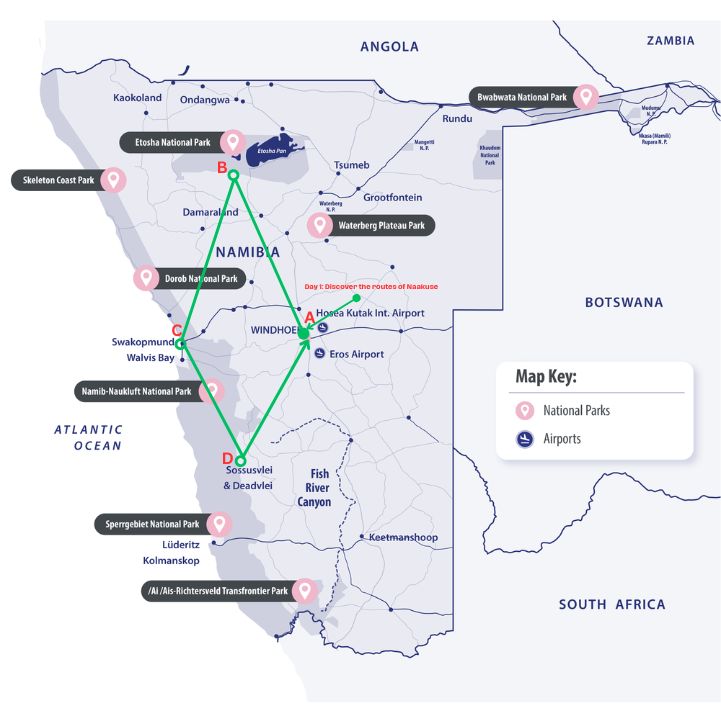
Bookings are made on a twin share basis, single supplement is available for solo travellers that prefer their own room.
Beste Reisezeit Namibia 2024 inkl. Klimatabelle
Klima in namibia.
Namibia liegt im südlichen Afrika und weist ein subtropisch kontinentales Klima auf. Merkmale dieses Klimas sind eine lange Trocken- und eine kurze Regenzeit. Von Ende Dezember bis April herrscht Regenzeit . Die Trockenzeit findet von Mai bis Dezember statt. Grundsätzlich gilt für das Klima in Namibia : Es ist heiß und trocken. Allerdings gibt es große Unterschiede in den verschiedenen Regionen des Landes. Klimatische Unterschiede gibt es an der Atlantikküste, in den Wüstenregionen sowie am Caprivi Streifen und im zentralen Hochland. Das zentrale Hochland nimmt die größte Fläche von Namibia ein. Hier befindet sich auch die Hauptstadt Windhoek (auch Windhuk ). Das Hochland fällt in das Gebiet des Sommerregens. Das heißt: Zwischen November und April fällt häufiger starker Regen. Anderes gilt für den äußersten Süden. Er fällt in das Gebiet des Winterregens.
Hier regnet es, wenn überhaupt, nur in den Monaten Juni und Juli. An der Westküste mit der Namib Wüste sieht es anders aus. Niederschlag fällt selten, es weht ein kräftiger, aber warmer Wind und es gibt in den Wintermonaten große Temperaturunterschiede zwischen Tag und Nacht. Die kältesten Monate sind Juli und August. Am Tag liegen die Temperaturen bei circa 25 Grad Celsius. In der Nacht fallen sie nicht selten bis auf den Gefrierpunkt ab. Die heißesten Monate liegen in der Regenzeit und damit im namibischen Sommer. Dezember und Januar weisen in der Regel Temperaturen weit über 30 Grad Celsius auf. Wieder andere Wetterverhältnisse herrschen an der Atlantikküste. Hier nimmt der kalte Benguelastrom Einfluss auf das Klima. Im Sommer ist es angenehm kühl, die Wintermonate sind vergleichsweise frisch. Die Temperaturen des Atlantiks klettern selten auf über 15 Grad Celsius. Für die Küste gilt: Das Wetter ist hier das ganze Jahr angenehm und trocken. Das Tropenklima am Caprivi Streifen verursacht eine hohe Luftfeuchtigkeit sowie häufige Niederschläge während der Regenzeit. Klimatisch besonders auffällig ist das Binnenhochland. Aufgrund der Höhenlage kann es hier in den Nächten zu Frost kommen. Sogar Schneefälle gab es schon. Das ist aber die Ausnahme.
Klimatabelle Namibia (Windhoek)
- Die beste Reisezeit für Namibia
- Die beste Reisezeit für Tierbeobachtungen und Safaris
- Videos aus Namibia
- Mein Fazit zur besten Reisezeit für Namibia
Weitere Informationen zu Namibia
Die besten reisezeiten für weitere reiseziele, beste reisezeit für namibia.
Namibia gilt insgesamt als regenarmes Land, auch wenn es eine Regenzeit gibt. Regenzeit in Namibia heißt, dass es kurz und heftig regnet. Keinesfalls regnet es tagelang durch. Aus diesem Grund ist Namibia ein ganzjähriges Reiseziel. Dennoch haben sich einige Monate als die beliebtesten für einen Urlaub herausgestellt. Als die beste Reisezeit für Namibia gelten die Monaten zwischen Ende Mai und Ende September . Wie ihr an der obigen Klimatabelle erkennt, sind das zum einen die regenärmsten Monate. Zum anderen sind die Temperaturen angenehm und nicht zu heiß, um das Land zu erkunden. Die durchschnittlichen Temperaturen liegen in den namibischen Wintermonate bei 20 Grad Celsius . Während der besten Reisezeit profitiert ihr von den meisten Sonnenstunden pro Monat. Zwar kühlt sich die Luft in den Nächten extrem ab, aber das kann nach viel Sonne angenehm sein. Beachtet aber, dass ihr euch für diese Reisezeit frühzeitig um eine Unterkunft kümmert. Die Schüler in Südafrika haben Ferien in dieser Zeit und reisen mit ihren Familien nach Namibia. Ferienwohnungen, Lodges und Hotels können schnell ausgebucht sein. Als Alternative könnt ihr auf die Monate Oktober und November für einen Namibia Urlaub ausweichen. Dann müsst ihr mit höheren Temperaturen, die extrem heiß sein können, rechnen. Dennoch eignen sie sich als optimale Reisezeit , weil die Sonne viele Stunden am Tag scheint und es wenige Regentage in diesen Monaten gibt.
Die beste Reisezeit für Namibia in der Monatsübersicht:
- Mai: 23°C, 10h Sonne, 1 Regentag, 37% Luftfeuchtigkeit
- Juni: 20°C, 10h Sonne, 0 Regentage, 32% Luftfeuchtigkeit
- Juli: 21°C, 10h Sonne, 0 Regentage, 27% Luftfeuchtigkeit
- August: 23°C, 10h Sonne, 0 Regentage, 19% Luftfeuchtigkeit
- September: 27°C, 7h Sonne, 0 Regentage, 17% Luftfeuchtigkeit
Alternative Monate:
- Oktober: 28°C, 10h Sonne, 2 Regentage, 22% Luftfeuchtigkeit
- November: 30°C, 10h Sonne, 4 Regentage, 30% Luftfeuchtigkeit
Seid euch bewusst, dass während der besten Reisezeit für Namibia viele Touristen aus aller Welt und Südafrikaner in dem Land unterwegs sind. Die typischen Touristenhochburgen können überfüllt sein und die Preise für Reisen ziehen an. Wollt ihr den vielen Touristenmengen aus dem Weg gehen, könnt ihr euren Urlaub alternativ in die Regenzeit und somit in den namibischen Sommer von Dezember bis April legen. Zwar ist die Regenwahrscheinlichkeit höher, aber die Monate haben andere Vorzüge. Aufgrund der höheren Niederschläge wächst und gedeiht die Vegetation und die Preise sind erschwinglicher als während der Hochsaison.

Regenzeit in Namibia in der Monatsübersicht:
- Dezember: 31°C, 10h Sonne, 5 Regentage, 34% Luftfeuchtigkeit
- Januar: 30°C, 9h Sonne, 8 Regentage, 42% Luftfeuchtigkeit
- Februar: 29°C, 9h Sonne, 9 Regentage, 56% Luftfeuchtigkeit
- März: 27°C, 8h Sonne, 8 Regentage, 51% Luftfeuchtigkeit
- April: 26°C, 9h Sonne, 4 Regentage, 44% Luftfeuchtigkeit
Beste Reisezeit für Tierbeobachtungen und Safaris in Namibia
Wer eine Reise nach Afrika plant, hofft darauf, wilde Tiere während einer Safari beobachten zu können. Grundsätzlich könnt ihr die Elefanten, Löwen, Giraffen und viele andere Tiere in den Naturreservaten und Wildparks das gesamte Jahr über sehen. Dennoch gibt es einige Monate, in denen die Chance höher ist. Als beste Reisezeit für Tierbeobachtungen in Namibia eignen sich die Monate August und September . Sie liegen in der oben genannten besten Reisezeit für Namibia und bilden das Ende des namibischen Winters. Zu dieser Zeit ist das Wetter trocken und warm. Die Vegetation ist nicht stark ausgeprägt und bietet den Tieren keine Tarnung und keine Versteckmöglichkeiten. Des Weiteren gibt es wegen des geringen Niederschlags nur wenige Wasserlöcher.
Perfekte Safaribedingungen im September und Oktober:
- wenig Niederschlag und keine dichte Vegetation: nur wenige Verstecke für die Tiere
- wenige Wasserlöcher: viele Tiere versammeln sich an den wenigen Stellen zum Trinken

Dort versammeln sie sich, um zu trinken. Erfahrene Ranger kennen diese Wasserstellen und führen euch auf einer Safari zu ihnen. Hier stehen eure Chancen gut, die verschiedensten Tiere beim Trinken zu beobachten. Plant eure Safaris, beispielsweise im Nationalpark Etosha , frühzeitig. In der Hochsaison wollen alle Namibia Urlauber eine Safari machen und die Touren können schnell ausgebucht sein.
Die Monate Dezember und Januar sind für Tierbeobachtungen in den Schutzgebieten weniger geeignet. Zu dieser Zeit regnet es viel in Namibia. Folglich stehen den Tieren viele Wasserstellen zur Verfügung, an denen sie ihren Durst löschen können. Sie verteilen sich mehr in den Gebieten. Des Weiteren ist die Vegetation üppig und bietet den Tieren Schutz. Dennoch stehen die Chancen gut, die Tiere auf grünen Wiesen beim Grasen zu sehen.
Videomaterial aus Namibia
Unser fazit zur besten reisezeit für namibia.
Bevor ihr eure Namibia Reise plant, seid euch bewusst: Das afrikanische Land im Süden des Kontintents ist kein Ziel für einen klassischen Badeurlaub! Der Atlantik ist das ganze Jahr über extrem kühl und nur was für Hartgesottene. Vielmehr geht es darum, Land, Leute und Tiere kennenzulernen. Als beste Reisezeit für Namibia eignet sich die Trockenzeit im namibischen Winter . Er herrscht Ende April , Mai , Juni , Juli, August bis Ende September . Aufgrund der angenehmen Temperaturen und der geringen Anzahl an Regentagen könnt ihr euch auf perfekte Wetterverhältnisse freuen. Ihr solltet auch warme Kleidung einpacken, da sich die Temperaturen in den Nächte stark abkühlen. Wollt ihr die wilden Tiere im Etosha-Natinalpark oder einem anderen Schutzgebiet beobachten, stehen die Chancen während der genannten Reisezeit optimal. Für eine Namibia Reise in diesen Monaten solltet ihr euch frühzeitig mit der Planung beschäftigen. Viele nutzen das exzellente Wetter für einen Urlaub. Günstigere Preise und weniger Touristen erwarten euch während der Regenzeit in den namibischen Sommermonaten. Zwar stehen die Chancen nicht ideal, um die Tiere in den Nationalparks zu sehen und die Regenwahrscheinlichkeit ist höher, aber das Wetter ist dennoch perfekt für einen Urlaub.
Akutes Fernweh?
Hier findet ihr alle Namibia Angebote
Nationalparks in Namibia
Diese Naturschönheiten müsst ihr unbedingt gesehen haben

Beste Reisezeit Südafrika 2024
Hier zeige ich euch, wann die optimalen bedingungen für eine reise nach südafrika sowie für eine safari sind..

Beste Reisezeit Kenia 2024
Anhand von klimatabellen zeigen wir euch wann die beste reisezeit für einen urlaub im hochland und an der küste kenias ist..

Beste Reisezeit Tansania 2024
Erfahrt hier, wann die beste tansania reisezeit für einen strandurlaub, für safaris und für trekking-touren ist..
Liebe Alle, Ich habe erst spät angefangen zu reisen, und als die Zeit reif war bereiste ich die Serengeti, Tansania und zum Ausklang Sansibar. Seither schlägt mein Herz für Afrika. Ich war auch in Thailand und Costa Rica , es war toll, doch es ist nicht Afrika. In Sambia habe ich u.a. die Viktoria Fälle besucht, auf Mauritius habe ich relaxt und gefeiert. Als nächstes will ich nach Namibia. Was für ein wunderschönes Land. Der Bericht hat mich noch mehr für dieses Land begeistert. Ich bin in Costa Rica Auto gefahren und in Griechenland. Links fahren ist nichts für meinen Kopf. Ich fürchte, er wäre störrisch. Das lasse ich. Ich plane diese Reise selbst und danke für wertvolle Tipps. Fernwehende Grüße Petra

Hallo Petra, es freut mich, wenn meine Tipps dir weiterhelfen konnten. Ich wünsche dir eine wunderbare Reise!
Liebe Grüße dein Urlaubsguru
Finde die Seite super gut! Viele schnelle Informationen über Klima und beste Reisezeit! Sogar mit Hinweisen auf die Tiersafris! Einfach genial!
Hey Angela,
wow – danke für dein tolles Lob! In diesen Seiten steckt viel Arbeit und Mühe drin – aber für euch mach ich das gerne! :)
Liebe Grüße der Urlaubsguru
PS: Ich finde dich auch super gut! :)
Was sagst du dazu? Antwort verwerfen
Meinen Namen, E-Mail und Website in diesem Browser speichern, bis ich wieder kommentiere.
OUR TOP PICKS FOR YOU IN 2024 – LOVED BY FAIR VOYAGE TRAVELERS

choose your destination
Destinations – top picks 2024.
Travel With A Soul
Browse All Countries
- South Africa
- Philippines
- New Zealand
- Craft My Trip

cofirmation successful
Thank you! You can now log in:

Need Password?
Enter your email and we will send you a link to create a new pasword.
set new password
Your password must be at least 8 characters long and include at least: 1 letter, 1 number, 1 special character
new password set!
Thank you for setting a new password to help us keep your personal details safe.
You can now log in to your account with your new password:
Privacy policy optin-in needed
We need your renewed agreement to our updated Privacy Policy . Please confirm your email and we will send you an opt-in link:
check your email
An email with the confirmation link is on its way to your inbox. Please allow up to three minutes for the email to arrive and click on the link to log in to your account.
Didn't receive it?
An email with a new password link is on its way to your inbox. Please allow up to three minutes for the email to arrive and click on the link to set your new password.
6 Day Namibia Sand & Wildlife Safari
Fair travel.
- Destination
About This Trip
Day-by-day itinerary.
- Briefing on the tour
- Halali Camp
- Departure from Windhoek
- Windhoek → Otjiwarongo
- Game drive through Etosha National Park
- Etosha National Park

- Settle down at your accommodation
- Halali Resort ( external link )

- Early morning game drive

- Lunch & relaxation at your accommodation
- Game drive towards Okaukuejo
- Halali Camp → Taleni Etosha Village
- Taleni Etosha Village ( external link )

- Scenic drive to Damaraland
- Taleni Etosha Village → Damaraland

- Drive down to the Skeleton Coast
- → Skeleton Coast

- Time at your disposal
- Hotel Pension a la Mer ( external link )

- Early morning at your disposal
- Drive through the Namib Desert via the Kuiseb Pass & Solitaire
- → Namib Desert

- Arrival at your accommodation & short sunset walk
- Desert Camp
- Desert Camp ( external link )

- 4x4 shuttle into the Sossusvlei
- Desert Camp → Sossusvlei
- Dead Vlei exploration
- → Dead Vlei

- Climb the Dune 45 or just wander around the base
- → Dune 45 Viewpoint
- Explore Sesriem Canyon

- Desert Camp (Same as Day 4)
- Wild cheetahs tracking at Solitaire Guest Farm
- Transfer back to your accommodation
- → Desert Camp
- Transfer to the airport (on request & at own expense)
Select Your Itinerary
Step 1: select destination, step 2: select route, step 3: select variation, delete itinerary step.
Are you sure?
Activity internal name/code [i]
Activity action title (for display) [i], categorize [i], need more options select "other" and submit a request for new categories. we will add them for you:.

OR duration in hours:
Or clock time:, location(s) (optional).
Use your keyboard UP/DOWN and ENTER keys to select (mouse click may not be working):
Select Start Location
This location already exists!
Select End Location
Destination [i], select existing destination, or add new destination, other highlights (optional), to display more info e.g about wildlife or culture, to highlight special inclusions, need more highlights, add them below and click submit. we will add them for you., photos, video & description (optional).
Description
Pricing & custom quotes.
All our itineraries and quotations are fully customizable to suit your requirements. We are happy to prepare a free custom offer and check availabilities for you.
Please send us your travel wishes via our trip inquiry form here: [ GET CUSTOM QUOTE ]. This will be the fastest way to speak to [y]our advisor, check availabilities and get a custom quote for this trip.
We aim to respond to your inquiry within 24 hours and are looking forward to helping you plan your trip!
For technical questions or other wishes, email [email protected] .
RESPONSIBLE TRAVEL

ACCOMMODA TION

DRINKS & MEALS
TRANSFERS & PORTERAGE
FEES & OTHER
All our trips are fully customizable according to your wishes and requirements. Unless requested and specifically stated otherwise, the following items are normally excluded from our standard quotations for this trip:
- Tipping for your guides, drivers, hotel staff, porters, or other service providers
- International and domestic flights
- Travel and medical insurance
- Medication and other personal medical items
- Food and beverages when not on tour and other than specifically stated
- Alcoholic beverages, soft drinks, snacks, and other food and drink not specifically mentioned in inclusions
- All personal purchases and expenses, such as for souvenirs, local SIM cards, etc.
- Rental gear, such as sleeping bags, apparel, gadgets, etc.
- Additional accommodation in case of itinerary variation (e.g. due to sickness)
Absolutely! We always do our best to meet your change requirements. Changes can be made easily until you've booked and paid for a trip. Thereafter, please note that changes will be subject to our Change Policy and Cancellation and Refund Policy .
For changes that require adjustment payments before traveling, we will need to charge an administrative Change Fee of US$100 to help us cover our administrative costs. Therefore, please review your Itinerary and Price Inclusions carefully and tell us any changes you already know you might need before making your booking and payments.
Yes, there is. Please push the button 'Inquire Now' to get more informations about this upgrade, as it can vary with the months.
Once you are fully satisfied with our custom offer and we've confirmed availabilities, you can pay safely by card or bank transfer.
We normally require a deposit of 30% and full payment within 60 days of the start of your trip to confirm your booking (see our Terms & Conditions ). Exceptions apply depending on the nature and time of your booking, in which case we will advice you accordingly prior to your payment.
Preparing Your Trip
It’s very important to stay hydrated when on safari in Namibia. Tap water is either purified or comes directly from boreholes and is therefore safe to drink. We supply drinking water from the tap, but bottled mineral water is readily available at shops and rest camps should you prefer it. On the rare occasion that tap water is unsafe to drink, your guide will always advise the group before you arrive in the area.
Namibia is a low-risk malarial destination but we recommend that you seek professional medical advice to enable you to make decisions on personal malaria protection. Generally Northern Namibia, including Etosha National Park is considered to be higher Malaria risk than the Southern Parts of Namibia. Malaria risk is also higher during the rainy months from December till May. You should use an effective insect repellent on clothing and any exposed skin. Diethyltoluamide (DEET) is safe and the most effective insect repellent and can be sprayed on to clothes. Local Names in Namibia include Peaceful Sleep and Bug Off.
If you sleep outdoors or in an unscreened room, you should use mosquito nets impregnated with an insecticide (such as pyrethroid). The net should be long enough to fall to the floor all round your bed and be tucked under the mattress. If practical, you should try to cover up bare areas with long-sleeved, loose-fitting clothing, long trousers and socks – if you are outside after sunset – to reduce the risk of mosquitoes biting. And some local advice would be to drink a Gin and Tonic at Sunset :)
Some international carriers fly into Johannesburg from where there are connecting flights into Windhoek. Airlines that fly direct into Windhoek are Air Namibia; Qatar and KLM .
In the interest of your physical and financial safety, it is essential and mandatory for all bookings made via Fair Voyage that you and anyone included in your booking be covered by insurance before setting out on holiday.
Your travel insurance must cover:
- If you are undertaking a hazardous activity or travel to less accessible areas, your insurance must also cover this particular activity and emergency evacuations for your particular destination(s).
- It is advisable and mandatory for all bookings made via Fair Voyage that you take out travel cancellation insurance as soon as your booking is confirmed or you make any payments for your trip (including flights or other payments that you may not be making to us) to cover your nonrefundable costs in case of cancellations or changes to your trip.
- IMPORTANT: Verify that your insurance policy also covers known risks related to the COVID-19 pandemic.
Always read your insurance terms and conditions carefully, to ensure that your particular event will be covered. If in doubt, verify coverage for the particularities of your trip and possible events with your insurance company.
Insurance included with credit cards is normally not sufficient for trips booked with Fair Voyage, due to limits on the maximum on insured amount, exception of potentially hazardous activities, exclusion of known risks related to the COVID-19 pandemic, and other customary limitations.
For your safety, all travelers booked with Fair Voyage must provide a copy of your insurance policy and emergency contact details before starting your trip, and you must carry your insurance details with you at all times during your trip.
By booking a Tour with Fair Voyage, you warrant that you have or will immediately take out adequate insurance coverage. Fair Voyage cannot accept any responsibility for financial loss or costs incurred by you that are outside of our control.

When going on safari, it's best to pack light using soft-sided travel bags that you can carry easily. Hard-case suitcase and trolleys may not fit easily into safari vehicles and may get damaged on dirt/gravel pathways in the African bush. You can always wash clothes if you are going on a longer trip.
Bring sturdy clothes and equipment that can withstand a rough journey on bumpy roads. Avoid white and very light colors, as the dust from the African bush is likely to make your clothes look gray. Natural colors such as brown and khaki are ideal.
The sun can be very intense, so make sure to bring appropriate sun protection. At sunset, however, temperatures usually drop significantly, so you'll also need a warm change of clothes.
Specifically, we recommend you to bring the following items. Please adjust the number of individual items of clothing to the duration of your safari and be sure to add any items of a personal nature that you might need.
- Duffel bag or big backpack as main piece of luggage
- Small backpack for the day
- Light rain jacket
- Warm pullover (mornings and nights can be cool)
- 2 sweatshirts or light pullovers
- 2 long trousers; comfortable
- 2 short-sleeved outdoor shirts or T-shirts
- Underwear and socks
- Solid sneakers or light hiking boots
- Comfortable flip-flop or sports sandals
Sun Protection:
- Sun screen/sun block
- Hat or cap with protective screen
- Camera and accessories (batteries, memory cards)
- Phone/tablet; paper notebook and pen
Toiletries & Medication:
- Prescription glasses and medication
- First-aid kit (medicine for insect bites, diarrhea, etc.)
- Other items of personal nature
- Insect repellent
- Malaria prophylaxis
Documents & Other:
- Cash (USD), credit card
- Passport (valid for at least 6 months)
- Flight tickets
- Vaccination card (required for Kenya and other countries where yellow fever vaccination is mandatory)
Please keep valuables with you during your travels and do not place them in your checked luggage. Upon arrival, you may also store them in a safe with the front desk of your hotel.
It’s best to secure all bags that you do not carry with you with a padlock in order to prevent theft. This includes your checked luggage during your flights, any bags you leave at your hotel, as well as any bags that you leave with your driver, guide, or porters. We regret that we are unable to accept any liability for any items lost or stolen.
We recommend you to carry with you enough masks and hand sanitisers to protect yourself and others in your party from Covid-19. However, since recommendations often change, we strongly advise you to check the WHO Covid-19 travel advice page for more information.
As a certified B Corporation , Fair Voyage curates travel experiences and local suppliers according to industry-leading social and environmental sourcing criteria, and aims to make its sourcing criteria fully transparent for each trip.
We have curated this particular itinerary and our local partners on the basis of:
Please contact us for more information or a tailored itinerary with experiences and accommodations specifically curated according to the impact you want to have.
Destination Information

Country Information
Located in southwestern Africa, Namibia boasts a well-developed infrastructure, some of the best tourist facilities in Africa, and an impressive list of breathtaking natural wonders. Visitors can explore the capital of Windhoek and discover the lovely coastal town of Swakopmund boasting remnants of the country’s German influence, reflected in the architecture, culture, cuisine and the annual Oktoberfest celebrations. To properly appreciate this extraordinary country, you will have to venture out of the cities to explore the remarkable natural landscapes Namibia has to offer. These include: the impressive Fish River Canyon; the vast Etosha National Park teeming with abundant wildlife, such as lions, desert-adapted elephants and the Hartmann's Mountain Zebra; the hauntingly beautiful Kalahari Desert; and of course the Namib Desert stretching for over 2000 km along the magnificent Atlantic Coast. Namibia is an ideal destination for travellers seeking an unforgettable African experience in a uniquely beautiful untamed wilderness.
The climate is typically semi-desert with hot days and cool nights. Midsummer temperatures may rise to over 40 degrees Celsius. Winter days are warm, but dawn temperatures may drop to freezing. Along the coast it is cool with low rainfall and fog prevails from late afternoon until mid-morning.
The rainy season lasts from October to April. The rest of the year is dry and cloudless. Namibia averages 300 days of sunshine a year.
Every season in Namibia has something special to offer and makes Namibia one of the few year round destinations in the world.
Summer is generally from October to May and during this time you can expect warm and sunny days. Average summer temperatures ranges from 15 degrees in the mornings and evenings and during the day around 35Degrees Celcuis. This time is also what we would consider our rainy season. However rain comes in short periods and sometimes with days / months in between the next rainfall. We in Namibia love our rain, and we love this time of the year. After a few good thundershowers, the normally dry and yellow landscape changes into lush green and is a beautiful time of the year to visit Namibia.
Autumn – we have a very short autumn in Namibia and the transition between Summer and Winter is normally not as visible as in Europe. June would be considered our Autumn month, as the temperatures then changes to the early 20 Degree Celcuis during the day. Some colder days can be expected.
Winter – June to August – During the winter we have lots of sunshine, and morning / evening temperatures can fall well below 10degree Celcuis. The days generally do warm up to around 15 – 22 Degree Celcuis, making our winter quite pleasant. However, the nights can get cold for short spells so bring beanies, long johns and a set of warm clothes if you are here between June and end August.
Spring – September is what we consider Spring. This is when the cold is over and although sometimes there is a cold day here or there, it’s quite a pleasant month for travelling, as the temperatures rarely go above 30degrees Celcuis.
The amount and type of animals you are likely to see will greatly depend on the region you visit. Etosha National Park is home to 4 of the Big 5 which include the Lion, Leopard, Rhino and Elephant. Buffalo is the only one of the Big 5 that is not present in the Etosha National Park, but can be seen in the Caprivi and Okavango areas of Namibia. Etosha is further home to 144 Mammal species and these include Zebra, Springbok, Oryx, Kudu, Eland, Impalas, White and Black Rhino, Giraffes, Damara Dik Dik, Steenbok, Brown Hyenas, Cheetah, Leopard and Jackals to name just a few. Birdlife in Etosha is also very prolific with a wide variety of endemic and migratory birds. The rest of Namibia you are likely to spot some Oryx, Ostriches, Kudus, some baboons as well as warthogs. And in the Caprivi and Okavango Regions you will be able to spot some crocodiles and hippos as well. Along the coast of Namibia spot some heavy-side dolphins and the cape fur seals as well as a rich marine birdlife.
Namibia offers a wide variety of local and international dishes and you can be assured that your taste-buds will be well looked after on a Wild Dog safari! While travelling with us on our scheduled tours, typical dishes include tasty stews, spaghetti bolognaise, steak, the traditional ‘braai’ (bbq), fresh salads, sandwiches and hotdogs. Vegetarians will also be catered for with dishes such as Lentil and Couscous Salad, Inca-style stuffed squash, Basmati and wild rice with chickpeas, Vegetable Kebabs with sweet chilli sauce and more … You’ll be able to visit some of our country’s fantastic restaurants before and/or after joining a tour, and some of our trips include an evening meal in Swakopmund, where you will find a great variety of delicious, local seafood such as lobster, cob and Walvis Bay oysters. Elsewhere, most restaurants offer a good variety on their a la carte menus, ranging from everyday favourites such as hamburgers and pizza, to some of the best steaks in the world. A popular choice for game steak is oryx, kudu or springbok, and all are highly recommended, especially when washed down with a local beer or some of the fantastic wine that’s imported from South Africa!
Public transport in Namibia is geared towards the needs of the local populace, and is confined to main roads between major population centres. Although cheap and reliable, it is of little use to the traveller as most of Namibia’s tourist attractions lie off the beaten track.
It is easy to travel around Namibia by car, and a 2WD vehicle is perfectly adaquate for most journeys. However, long distances, poor mobile phone coverage outside of main towns and infrequent petrol stations that only accept cash mean that planning ahead is vital.
There are major airlines that fly into Windhoek and Swakopmund. Other destinations are reachable by car or charter flight.
Namibians drive on the left and all signposts are in English. Seat belts must be worn at all times and talking in a mobile phone while driving is prohibited. The general speed limit is 120km/h on tarred roads outside of towns and 100km/h on gravel roads. In built up areas, the speed limit is 60km/h.
The currency used in Namibia is The Namibian Dollar (NAD or N$). It is linked permanently (with a ratio of 1:1) to the South African Rand (ZAR), and South African Rand notes and coins are also legal tender in Namibia. Its not always easy to obtain N$ before you arrive here but you should be able to get South African Rand easily. Exchange rates vary so please check for up to date information on the current rate. To give you an idea of the affordability of the things you might want or need in Namibia, items typically cost as follows… in no particular order, we promise! - Local beer: Namibia produces some fantastic beer and a bottle will cost you about NAD 15 – NAD 20.00 per beer (340ml) - Wine: Namibia imports quite a good selection of wines from South Africa and a very drinkable bottle (750ml) will cost around NAD 60 – NAD 150.00 - Soft Drinks: A 500ml bottle of mineral water or branded, fizzy drink (Coca Cola, Pepsi, Fanta) is about NAD 10.00 per drink - Restaurants: Prices will range according to the type of restaurant you visit, but most starters (entrees) range from about NAD 30 – NAD 70.00. Main courses will be around NAD 90 – NAD 150.00 per dish and desserts will be in the region of NAD 30 – NAD 70.00 - Sunscreen: Namibian sun can be quite harsh at times, so we recommend a good sunscreen, which will cost about NAD 150 -NAD 200.00. It’s a small price to pay for eternal beauty! - Gas/Petrol: Of course, prices fluctuate but as of 2016, fuel will cost around NAD 12.50 per litre
Terms & Conditions
Fair Voyage is a travel agency registered in Switzerland under the full name of Fair Voyage AG, with offices at Wonderland, Maneggplatz 48, 8041 Zurich ( see our business registration at https://zefix.ch ). Fair Voyage is operating the website FairVoyage.com and related channels (our Fair Voyage System ). Any references on this site or in this document in correspondence to "Fair Voyage", "FairVoyage.com", "us", "we", "our" or "ours" refer to Fair Voyage AG .
Quick Links to Frequently Asked Questions
- Cancellations and Refunds (including non-refundable amounts)
- Changes to Bookings (including Change Fee)
- International Flight Bookings (including fees, changes, and cancellations)
- Payment Schedule (including Deposit amount and Balance due date)
- Tailored Itineraries and Quotations (free service for verified travelers)
- Travel Insurance Policy (including mandatory coverage)
- Travel Vouchers (including issuance, validity and limitations)
Travel Agency Services
Fair Voyage provides comprehensive travel agency services (our Services ) specialized on the planning and booking of multi-day trips in select destinations around the world ( Tours , each a Tour ). As an agency, Fair Voyage works with third party suppliers, service providers and subcontractors to provide our Services.
Depending on the nature of each Tour and destination, we may subcontract and outsource all or parts of our local tour operating services to third party local suppliers ( Operators , each an Operator ), and we may operate Tours locally in our own name, co-branded, or in the name of our local Operator partner.
In any case, for any Tour bookings and payments made via Fair Voyage, which means that contracts are made directly between you and us, Fair Voyage is responsible to you for honouring any confirmed bookings and making available any Tours reserved through us.
Should you purchase any additional services that you book and pay for outside of the Fair Voyage System, including any local Tour upgrades or add-ons or equipment rentals that you pay for directly to a local Operator or other party, any such contracts are deemed to be made directly between you and such Operator or other party.
In addition to our general terms and conditions ( Terms and Conditions ), each Tour or Operator may have their own additional requirements or terms and conditions applicable to a Tour ( Tour T&C ), available in the booking section of the Tour or on reservation or booking request.
By using any information or Services provided by Fair Voyage, including the FairVoyage.com or affiliated websites, you agree to be legally bound to the following Terms and Conditions, which shall take effect immediately. If you do not agree to be legally bound by all the following Terms & Conditions, please do not use our information or website or Services. In all cases, the person making the booking shall be deemed to have accepted these Terms and Conditions on behalf of all the other person(s) included in their booking.
By reserving a Tour or making a payment to Fair Voyage, you further accept the applicable Tour T&C.
If you are an Operator, you also agree to our Terms of Business .
Inquiries, Bookings and Payments
Fair Voyage specializes in tailored private itineraries and travel arrangements. When you find Tours on FairVoyage.com or our other promotional channels, they serve as sample itineraries to help you and us get started with your travel planning; and may or may not be available at the time of your inquiry or booking request. Any booking will always be subject to availability and payment, according to the process detailed below.
If you wish to receive a tailor-made itinerary or inquire about a specific Tour ( Inquiry ), please follow the steps via the "Craft My Trip" or "Inquire Now" button on our website or such other steps as we may provide to you via our messaging system, email, social media, or other channels. We aim to respond to you within 48 hours, but—depending on the nature of your Inquiry and other circumstances outside of our control—we may sometimes need up to five days to connect you with your best travel advisor.
As we use our custom-built messaging and automated email systems to connect you with your travel advisor and deliver important communications related to your Inquiry, please add [email protected] and [email protected] to your address book to help us get these emails into your inbox.
Tailored Itineraries and Quotations
We are happy to offer our first quotations and itinerary tailoring services free of charge to verified travelers with a genuine interest in booking a trip with Fair Voyage.
Should you only require a tailored itinerary, or wish to book an advisory call with one of our local experts, feel free to state your wishes as part of your Inquiry. Tailored service packages are available on an itinerary or hourly rates basis.
Should you be undecided about your travel plans, or otherwise need multiple quotations or itineraries, please see our Agent and Ambassador Services .
Non-Binding Reservations
Once you are satisfied with your tailor-made itinerary, have decided the Tour you would like to book together with your travel advisor, or when you see the option to "Reserve", you may request us to confirm your Tour price and availability. This constitutes a non-binding reservation, and no payment details are required ( Reservation Request ).
Please note, however, that the time period and feasibility of temporarily securing accommodations and other reservations, if possible at all, depends on each Tour, and can only be guaranteed after payment.
Binding Reservations or Bookings
If you wish to proceed with a binding reservation or booking, please inform your travel advisor who will finalize your trip details for you in your personal trip account and inform you once ready for payment. If you are satisfied with all details, you may then proceed with your binding reservation ( Booking ) by making a secure online payment from within your tailored trip account (or by making a payment using an alternative payment method provided by us to you), according to our Payment Schedule:
Payment Schedule
All Tours booked with Fair Voyage are subject to the payment schedule as set out below ( Payment Schedule ):
- If your Booking is more than 60 days from the start of your Tour (local time): We require a deposit of usually 30% of the Tour price or such other amount as stated specifically for your Tour ( Deposit ) to confirm your Booking and make binding reservations, and
- If you do not cancel your Booking up to 60 days prior to the start of your Tour (local time): The remaining Tour price balance (total Tour price less Deposit amount paid) is payable 60 days prior to the start of your Tour; or
- If your Booking is within 60 days of the start of your Tour: the full Tour price is required to confirm your Booking.
Please note that Fair Voyage cannot control any fees that may be charged to you by your bank related to our collection or your transfer of payments, and we disclaim all liability in this regard.
Upon receipt of each of the Deposit and remaining Tour price payment, or full Tour price payment, we email you a payment confirmation ( Payment Confirmation ).
Confirmed Bookings
Upon receipt of your Deposit or full Tour price payment, your travel advisor will make every attempt to finally secure all reservations for you, and we will confirm your final reservations and booking by email as soon as possible ( Booking Confirmation ). Depending on your Tour, this may only take a few minutes, or sometimes up to five days.
In the rare case that we may not finally secure all reservations for you within five days, and you do not find a suitable alternative together with your travel advisor, we will issue you a full refund of your payment.
Your Booking is not confirmed until we have emailed you the Booking Confirmation and applicable first Payment Confirmation. Your booking further remains subject to your compliance with other applicable terms and conditions.
Your Personal Details
Once you have made your payment and we have confirmed your booking, you will receive an email with a link to complete all your personal details and preferences, as well as those of anyone included in your Booking, in your personal trip account. You may also invite others included in your Booking to join your personal trip account, so that they can directly complete their personal details and preferences. To help your travel advisor arrange a smooth and safe experience for you, please add your details at your earliest convenience, and make sure that all details of everyone traveling with you are completed well ahead of your Tour start date.
Payments on Arrival For certain add-on services or purchases related to your Tour, you may have the option to pay on arrival . This may include equipment rentals, accommodation upgrades, purchases of food and beverages, or any other Tour upgrades or purchases required or desirable by you to participate in your Tour ( Add-On Services , each an Add-On Service ). For any such payments, please note that it is your responsibility to ensure that you bring a locally acceptable means of payment to secure your Add-On Service(s). Especially in developing countries and remote regions, please note that cash machines or credit card machines may not always be available, and—even if available—may not work due to machine outages or poor network connectivity. Furthermore, local banks may charge significant fees for cash withdrawal or card payments. We therefore strongly advise that you bring sufficient cash in a locally acceptable currency for all your intended payments locally.
Liability for other individuals in your booking
If your booking includes other individuals, you assume all liability also for those individuals. It is your responsibility to ensure that they have read these Terms and Conditions.
Unless specifically stated otherwise, rates on this site are in US dollars, which is usually also the currency for your payment.
Please note that all dates and times indicated on FairVoyage.com refer to the timezone of the Tour location, unless specified otherwise.
- International Flight Bookings
Most Fair Voyage Clients prefer to book international flights directly, or via their preferred concierge or booking agent, for cost or convenience reasons. Therefore, we currently offer international flight booking services on request only.
For international flight bookings, an upfront non-refundable administrative fee of US$250 ( Flight Booking Fee ) applies for each reservation and booking. The Flight Booking Fee is applied per person if traveling solo, or per couple, family or small group of up to four persons traveling together on the same international flights.
On request and agreement with your travel advisor, we issue a priced flight reservation according to your indicated preferred flight connection and booking class. You must check your flight reservation details carefully, as tickets are issued in your name which must match your passport, might be non-refundable, and your airline conditions as well as any special ticket conditions such as baggage restrictions or fees for making changes after ticket issuance, as well as our Change Fee, apply once tickets are issued.
Flight prices and availabilities may exceptionally change between reservation and booking due to changes made by the airline or our booking administrator, which are outside of our control. For any significant changes, we will request you to reconfirm your reservation prior to proceeding with ticket issuance. Flight bookings are only confirmed upon ticket issuance.
Carbon Offset for International Flight Bookings
We help you offset the carbon emissions of your international flights when booked with Fair Voyage. To do so, we use Compensaid . You can learn more about the reason why we have chosen Compensaid, including our research and implementation approach, as part of our Climate Action .
For all international flights booked with Fair Voyage, compensating emissions at least in the long run (10 years) is mandatory. To do so, we invest in the portfolio of international projects for global impact as curated by Compensaid for offset via their website, or local projects curated by Fair Voyage specifically for (y)our destination(s) ( Default Offset ).
Beyond compensating in the long run, we recommend all travelers to compensate emissions with immediate impact (0 years) by purchasing Sustainable Aviation Fuel (SAF) ( SAF Offset ).
We transparently show you the CO2 emissions and offset price for both options, at your choice which option you wish to pay for. The offset price will be invoiced to you as part of your total flight price and is non-refundable.
For flights not booked with Fair Voyage, we also offer you the service to help you calculate and offset your emissions on request when traveling with Fair Voyage. A non-refundable administrative fee of US$100 ( Offset Fee ) applies for each set of calculations per trip booking.
International Flight Booking Transaction Fees
For all international flight booking invoices and payments, including amounts for offsets and fees, an additional 2.0% transaction fee applies for payments made by credit card or Voucher.
Changes to International Flights
Changes to booked flights are subject to the conditions of your flight tickets and airline. If you wish to make changes to international flights once booked, we are most happy to help you do so and process changes to your tickets and flight connections, subject to our Change Fee and Service Times. Alternatively, you can also contact the airline directly using the contact details stated on your ticket or provided with your booking.
When you make changes directly and these impact your arrival or departure details, please also remember to inform your travel advisor and update your Traveler Details in your Trip Dashboard so we can make smooth local travel arrangements for you.
Emergency Hotline Provided by Your Airline
For urgent changes and emergencies regarding your international flights whilst traveling, unless otherwise agreed with your travel advisor or local guide, please contact your airline directly. The Fair Voyage 24/7 Trip Assistance number will direct you to our local operations team in your destination for any emergencies related to your local trip, and may not always be able to assist you with changes to your international flights; your travel advisor and our central service team may only be able to respond within our standard Service Times . Therefore, contacting your airline directly will be the best way for you to get immediate assistance.
International Flight Cancellations and Refunds
In the unlikely event that a flight becomes unavailable or significant changes occur between reservation and ticket issuance, and we cannot find a suitable alternative flight for you, you are usually entitled to a full refund of the flight price that you have already paid to us, less our Flight Booking Fee and Offset Fee which remain non-refundable to help us cover our administrative costs.
Should you wish to cancel your flight after ticket issuance, any refunds are subject to the terms of your airline and ticket. We will issue you any refund that we are able to obtain for you from the airline, less our Flight Booking Fee, Offset Fee, Change Fee and any amounts paid for Default or SAF Offset.
Please also note our Policy on Refund Discrepancies due to Transaction Fees or Exchange Rates .
Impact of Flight Changes or Cancellations on Tour Bookings
Fair Voyage shall not be held liable for any voluntary or involuntary flight cancellations or changes or inability otherwise to take a booked flight. This also means that Fair Voyage shall not be responsible for any non-refundable amounts or additional charges resulting therefrom. When involuntary cancellations of or changes to your flights mean that you are no longer able to take part in your local Tour booked with us, we will do our best to help you make re-booking arrangements and transfer your trip to a later date, subject to our Change Fee and possible cost increases.
Add-On Service to Local Tour Bookings
Fair Voyage is specialized on local Tour Services in your destination. As such, we only offer international flight bookings as add-on service to local Tour Bookings, which shall constitute the majority of your total booked trip value.
Travel Vouchers
We are happy to issue and customize Fair Voyage travel vouchers exclusively for our clients and network. Learn more and order here .
The final voucher ( Voucher ) will be valid once issued, subject to our terms as stated herewith.
If you have received a Voucher, for your security and convenience, please register your Voucher ID and contact details with us by submitting our Craft My Trip form. Once registered, we will keep track of your Voucher ID(s) for you, accessible with your registered email.
Redeeming a Travel Voucher
Unless otherwise stated for a specific Voucher, all Vouchers can be redeemed for any trip bookable with Fair Voyage at the time of booking, including—in addition to the local Tour—any price components for international flights, service charges, VAT, donations, or other amounts invoiced by Fair Voyage, subject to the following terms and limitations:
- All Vouchers are subject to our latest general Terms and Conditions as published on our website. Any additional terms specific to the Voucher apply as and if stated on the Voucher, including any limitations or exceptions to the terms stated herewith.
- Extension : Requests for extension on exceptional basis must be submitted by email to [email protected] within the Validity Period. Any extension is subject to the Voucher owner or beneficiary having submitted an inquiry for a specific trip, and subject to written agreement by and in the sole discretion of Fair Voyage. Fair Voyage will consider each request on case by case basis, and may or may not grant an extension on exceptional basis. In each case of request and agreement to an extension, the Validity Period will be extended for maximum 1 additional year. If the Voucher owner or beneficiary still cannot travel or find a suitable trip to book within the extension period, a new request must be submitted within the previously extended Validity Period.
- Refunds : Refunds can be issued only on request by the initial purchaser, within the Validity Period. To obtain a refund, please send your request to [email protected] . A service charge of the bigger of US$250 or 10% of the Voucher value applies and will be deducted from any refunds. Please also note our Policy on Refund Discrepancies due to Transaction Fees or Exchange Rates .
- Expiry: If, within the Validity Period, a Voucher has not been redeemed and no extension agreed or refund requested, the Voucher value will be forfeited at the end of the Validity Period. Fair Voyage may, at its sole discretion, invest or donate the forfeited Voucher value for a positive impact cause of its choice.
- Vouchers may not be applied retrospectively.
- Any value of each unique Voucher ID can only be redeemed once. Vouchers with the same ID are deemed copies of each other, such as when you receive a Voucher electronically and in print, or Vouchers reissued when declared lost.
- For your security, you must provide your unique Voucher ID on booking. If you have registered your Voucher with your personal contact details, we will keep track of your Voucher ID(s) for you. Vouchers that have been lost, stolen or destroyed before registering your contact details can be reissued to the initial purchaser.
- Vouchers issued for a specific individual named on the Voucher are non-transferable. When you receive a Voucher issued in your name, you can spend it on yourself, or on your friends and family.
- On redemption, when paying for a trip or other Service by Voucher, the same Terms and Conditions valid at the time of Booking apply to the booked services as if booked and paid for in cash, including our Change Fee and Cancellations and Refunds Policy ; except:
- Any refund associated with your Booking will be a refund back to the same original Voucher credit used for the Booking. Where payment was made in cash and Voucher(s), and the refund is less than the original payment, the refund will first be applied up the the original Voucher credit used and only any remaining portion will be refunded in cash.
- Each Voucher can be redeemed only once for one (1) trip, for one or multiple travelers traveling together on the same trip. Multiple Vouchers can be used for the same booking. Any portion of the Voucher value not fully used at the time of Booking can be kept open as credit available for add-ons and changes until 40 days prior to the start of your Tour. For Vouchers with a value in excess of US$2,500, if the remaining unused value is greater than 10% of its total value, you may also request us until 30 days after the end of your Tour to keep the remaining balance open as credit available for a future Booking. Any remaining unused portion of the Voucher value will be forfeited 30 days after the end of your Tour.
- Vouchers cannot be used for expenses typically incurred and paid for locally, such as food or spa treatments; unless pre-booked with your Travel Advisor at the time of Booking or until 40 days prior to the start of your Tour.
- The value of the local Tour paid for with the Voucher has to be at least the bigger of US$5,000 or 50% of the Voucher value. Only Voucher values in excess of US$5,000, and in no case more than 50% of the total value, can be redeemed for other travel services booked or paid for as part of the same trip, such as any International Flight Bookings , except:
- If you cannot fully redeem a Voucher value for your trip, or in its entirety within its Validity Period, you may also ask us until 30 days after the end of your Tour, or until the end of the Validity Period in case of no Bookings, to invest the unused value into Sustainable Aviation Fuel purchases or make a donation to a Fair Voyage curated climate friendly or local impact project on your behalf. A service charge of the bigger of US$250 or 10% of the Voucher value applies and will be deducted from any such investments or donations, to help us cover our administrative costs.
Quotation Currencies and Currency Conversion
- To keep our costs as low as possible for you, our Tours are usually quoted in the same currency as used for local bookings in the country of your destination. All payments must be made in the currency stated in our quotations.
- For any payments in a currency different from the originally quoted currency, such as payments by Voucher denominated in a different currency, or for any international flight bookings which we normally source quoted in Swiss francs, conversions will be made at the prior calendar month's average exchange rate as published on the Swiss Federal Council website plus a 2% currency conversion fee.
- All fees are stated in our Terms and Conditions in US dollars for simplicity reasons. For Bookings in other currencies, the same amounts will be applied without conversion if the difference on conversion would be less than 20%. For example, as of May 2022, the Change Fee of US$100 will be applied as CHF 100 for Bookings quoted in Swiss francs.
Changes to Your Booking
If you would like to make changes to your confirmed booking, such as add additional services or items to your Tour, we will do our best to meet your requirements, subject to availability and feasibility. To allow us enough time to do so, please inform us at least 14 days prior to your Tour start of any desired changes. An administrative fee of US$100 ( Change Fee ) will be charged to process each change. For cancellations of your entire or parts of your Tour, please refer to our Cancellations and Refunds Policy . If you would like to cancel only individual services or items that were priced separately and have a total value of no more than US$100 (such as transfers, equipment rentals, or accommodation upgrades), we regret that we cannot refund such amounts as the Change Fee would exceed the value of the refund.
Changes to Your Itinerary
Your Tour itinerary was written to provide helpful information to you about your destination and activities, and to be representative of most Tours which follow the same itinerary or itinerary steps. Variations are possible at the discretion of your local guide and Operator to deliver the best possible experience to you within the constraints of your personal, group-specific, and external circumstances.
If you need to change your itinerary during your Tour (for example as might be required due to sickness, accident or personal emergencies), please note that you will need to pay us or your local Operator directly and immediately any additional costs incurred, such as for transfers, meals, or accommodation. No refunds can be made for those parts of your Tour that you will no longer be able to participate in.
Late Arrivals and Luggage Delays
When making your travel arrangements, please consider that flights or other transportation to your Tour start location might get delayed. Furthermore, it happens that luggage gets lost or displaced. Any such late arrivals may cause major problems for organized Tours. While we and your local Operator will make best efforts to help in such situations, you will need to pay us or your local Operator directly and immediately any additional costs incurred, such as for transportation or hiring of equipment.
When it is not possible to change your itinerary to accommodate late arrivals, you may not be able to participate in the Tour, and your Tour price will be forfeited. We therefore strongly recommend that you plan to arrive two to three days prior to the start of your Tour, and that you wear or carry in your hand luggage all essential items required for your Tour.
Cancellations and Refunds Policy
Unless stated differently for a Tour, the following terms and conditions apply to cancellations and/or refunds of your entire Tour or parts thereof:
- All cancellations have to be submitted in written form, by sending an email to [email protected] , stating: a) your first and last name, b) Tour start date, and c) reason for cancellation (collectively, the Cancellation Email ).
- (a): If your Cancellation Email reaches us more than 60 days prior to the start date, only your Deposit* will be forfeited.
- (b): If your Cancellation Email reaches us 60-31 days prior to the start date, 50% of the total Tour price* will be forfeited. We will refund the refundable balance to your credit card or nominated bank account within a reasonable time period (please allow us at least 10 working days).
- (c): If you cancel within 30 days of the start date, 100% of the total Tour price* will be forfeited.
*The Deposit and total Tour price refer to the amounts of the entire Tour or the part thereof that is subject to your cancellation. For example: IF you cancel a part of a Tour, whereby the entire Tour is priced at USD 10,000, you cancel a part of the Tour priced at USD 1,000, and you proceed with the remaining part of the Tour priced at USD 9,000, THEN the forfeited Deposit for the cancelled part of your Tour under point (a) amounts to USD 300 (30% of USD 1,000), 50% of the total Tour price that will be forfeited under point (b) amounts to USD 500, and the forfeited total Tour price under point (c) amounts to USD 1,000.
The Change Fee applies and will be deducted from any refunds.
In the unlikely event that we or one of our Operator partners cancels a Tour, you are in most cases entitled to a full refund of your Tour price that you have already paid, or we may offer you to apply those funds to another Tour. In the unlikely event of any disputes between you and your travel advisor or Operator that you cannot resolve directly, please also contact us at [email protected] .
For cancellations as a result of COVID-19, please refer to our Travel Insurance Policy terms and COVID-19 exceptions and clarifications .
For any international fight bookings and cancellations thereof, please refer to our International Flight Bookings terms.
Policy on Refund Discrepancies due to Transaction Fees or Exchange Rates
Please note that payment transaction fees such as credit card fees, bank fees and currency conversion fees, as well as fluctuations in currency exchange rates, may mean any amount refunded is different from the amount originally paid, particularly in instances where a currency exchange is involved. Fair Voyage has no control over any such fees or exchange rates and is unable to accept responsibility for any such discrepancies in refunded amounts.
- Travel Insurance Policy
COVID-19 Exceptions and Clarifications
If you cannot travel as a result of new legally imposed quarantines, travel restrictions or flight cancellations resulting from COVID-19, and there was no travel insurance available for residents of your country and/or destination that you could have taken out to cover such risks, you will usually have the option to transfer your trip to a later date free of charge (subject to possible cost increase), or get a travel credit for another trip booked with us in future, or a full refund should we no longer be able to operate the trip for you.
These conditions vary depending on all local suppliers involved in operating your trip and are still subject to change. If you would like to proceed with a booking, please contact us and we will advise you the specific conditions applicable for this trip at your time of booking.
If you cannot travel as a result of you or someone traveling with you being tested positive for COVID-19, or due to legally required self-quarantine because you have been in contact with someone who tested positive, such events must be covered by your travel insurance. Our standard Cancellations and Refunds Policy and Travel Insurance Policy apply.
Operating Hours and Service Times
Fair Voyage strives to provide the best travel advice and service for conscious travelers from around the world when traveling to one for our destinations.
Whilst our central team is based in Zurich, Switzerland, our travel advisors and local experts are an internationally leading team of destination and experience experts based globally and in our destinations around the world. Therefore, we do not operate according to fixed office hours, but have designed our client service in a way that we can give you direct access to your best expert travel advisor for your trip, no matter where they are based.
We aim to respond to new inquiries and client messages within 48 hours, and are happy to provide travel advice for clients by phone or face-to-face meeting on appointment basis (our Service Times) . Whilst traveling, all clients have access to a 24/7 emergency phone number for immediate local trip assistance.
At the moment, we do not provide immediate assistance for general inquiries. Please leave us a voice message or email [email protected] , and we will get back to you as soon as possible.
Agents and Ambassador Service Fees
We are happy to partner with agents and ambassadors, and provide you with unlimited quotations and tailored itineraries for your clients and network. To help us cover our administrative costs, we charge a service fee of $100 per quotation ( Quotation Fee ) for your pre-defined itinerary, or $250 per itinerary and quotation ( Itinerary Fee ) for tailored itineraries and custom quotes provided by us according to your travel wishes; inclusive of changes and adjustments that you ask us to make to ensure that our Services fully meet your requirements.
Both the Quotation Fee and Itinerary Fee are fully creditable for up to three years against all future trip bookings made by you, your clients or your referrals; notwithstanding whether the booking is made for the trip initially quoted or another trip; whereby multiple pre-paid fees can be credited against a single booking for up to 10% of each trip price. At your choice, instead of crediting the fee against a trip price, you may also request us to refund the fee to your account upon a trip booking made by your clients or referrals.
Accuracy of Information
On FairVoyage.com and our other channels, we aim to publish accurate, up-to-date information regarding our travel services, destinations and Tours. This information is bound to change frequently and will not always be updated as quickly as we would like. We therefore cannot guarantee the accuracy of this information. You should make your own independent inquiries and use your own judgment to assess the accuracy of any information accessed through FairVoyage.com.
Fair Voyage accepts no responsibility for errors, inaccuracies or omissions of any information on our website(s). This also means that we accept no responsibility for any complaints as to any part of your Tour not being as described on FairVoyage.com. However, we will make every effort to correct quickly any errors brought to our attention.
Limitation of Liability
The responsibility of Fair Voyage AG as well as its employees, agents and representatives is strictly limited.
While we and our Operator partners will do our best to deliver a satisfactory Tour experience, ensure your personal safety as well as the safety of your belongings, as well as take necessary precautions in case of emergencies, unfortunate incidents are always a possibility and often beyond our control. We, including your local Operator and their staff, shall not be held liable to you for:
- any accident, injury, or illness that may occur to you;
- any loss, delay or damage to your luggage, equipment or personal belongings; any services booked by you with other service providers (such as insurance companies, rescue services, flights, etc.);
- any services provided by other service providers which are beyond our control, including but not limited to: accommodation service providers, transportation service providers; authorities in charge of managing national parks, conservancies or other separately managed destinations (for example: rescue services and transportation; provision of campsites or other accommodation facilities, picnic sites, toilet facilities; services of park rangers or other personnel employed by such authorities, etc.);
- any claims for compensation arising due to loss or damage caused by you to other persons, other person’s property, or property of an Operator during the Tour; any breach of obligations resulting from causes beyond their reasonable control including fire, natural disaster, civil strife, industrial dispute, strikes of employees, adverse weather conditions, traffic and any other events of force majeure that are outside of their control.
We do not warrant or represent that any Tour is suitable or fit for your purpose. You should not undertake any Tour unless you are medically able and properly trained.
Many of our Tours involve travel to isolated regions; strenuous and potentially hazardous activities (including, but not limited to, any activities in high altitudes, climbing and mountaineering, bicycle riding, or scuba diving); potentially hazardous traffic and means of transportation (including, but not limited to, roads with higher risk of accidents due to irresponsible traffic participants, or small charter planes) and potential exposure to wildlife. Therefore, these Tours may involve a significant amount of personal risk, including by way of example, personal accident, injury, disease, death, loss or damage of property, inconvenience, and discomfort. There may be no or limited access to emergency medical treatment or timely evacuation.
Furthermore, you know that many Tours require special equipment to protect your health and safety. Local Operators may or may not rent such equipment, which may or may not be suitable. You certify that you are familiar with the specific types of equipment and their requirements to undertake the Tour, and will make your own arrangements to have the necessary suitable equipment available during your Tour.
By booking a Tour with Fair Voyage, you agree, warrant and covenant that:
- You assume all risks associated with your Tour as well as the effect of weather, traffic, and force majeure;
- You will not hold Fair Voyage and its employees, agents, representatives, or Operator partners liable for any accident, injury, illness, death, costs, property damage, theft or personal loss; and
- You release and discharge Fair Voyage, its representatives, agents, employees, and Operator partners from any and all claims suffered by you as a result of your participation in or traveling to or from any Tour.
Insofar as Fair Voyage is unable by law or by statute to exclude its liability, then you agree that our liability to you is limited to Fair Voyage providing the Tour (or a similar Tour) again to you.
Tour T&C
Please note that it is your responsibility to also read the Tour T&C and all the requirements applicable to your Tour carefully before making your booking and any payments. Should you not be able to locate the Tour T&C on the Tour page or have received them by email, please contact us. If you are not able to participate in a Tour because you do not meet the requirements (including, but not limited to, lack of: travel documents or visa, medical suitability, adequate proof of insurance, certificates or licenses, willingness to sign a liability waiver form), we regret that we cannot refund the Deposit or other full or partial Tour price payment made to us.
Unless explicitly stated otherwise in the Tour T&C, or if no further Tour T&C are explicitly confirmed to apply to your Tour, please note that the following applies to all Tours and Operators:
Accommodation
Accommodation is subject to availability at your time of booking and for your entire group. If not available, we may change your accommodation different from the one included in your itinerary or Booking Confirmation.
Price Increases
All price quotations are based on the current rates of park fees, VAT and other government taxes. Should any of these be increased or a new tax introduced (which is outside of our control or the control of any Operator), we regret that such increases will be added on to your final Tour price even if the trip has already been paid for. The final Tour price may thus be higher than the price confirmed in your Booking Confirmation, and you will need to pay the difference in order to participate in your Tour. Therefore, we strongly advise that you confirm with your insurance provider that your travel insurance will cover and protect you against such an unfortunate event.
Identity, Authority and Privacy
When you make an inquiry or register an account, you must use your real name and contact details. The use of pseudonyms is not permitted on Fair Voyage. If you register a company or other legal entity, you warrant and assure us that you have proper authorization to act in the name of the company or legal entity, respectively.
Fair Voyage will not accept bookings from persons less than 18 years of age. By making a booking request, you warrant and assure Fair Voyage that you are at least 18 years of age.
During the booking process, you will be required to provide personal information through our system, which we will share with our local Operator partners to enable them to provide the services requested by you. Depending on the nature of your Tour, you may also be required to provide a photo ID or passport to help us secure permits or make other booking arrangements for you. In exceptional cases, we may also request your photo ID to comply with anti-fraud or other compliance checks occasionally performed by our financial service providers. We do our utmost to protect your personal information. Please refer to our Privacy Policy for further details.
During your Tour, you must carry your photo ID or passport with you at all times, unless otherwise advised by your travel advisor or guide. You may need to show your photo ID locally at the start of your Tour to ensure that your identity matches your booking identity as well as throughout your Tour when checking in to accommodations, at entrance gates, for certain activities, in case of police check or otherwise. Your identity details must match the information that you have provided to us during your booking and in your personal trip account on FairVoyage.com. The same applies to any other individuals included in your booking.
No Entitlement
There is no entitlement to use FairVoyage.com. We withhold the right to delete accounts or information provided by you, including, but not limited to, if we deem you to have violated these Terms and Conditions, and to cease providing services to you at any point in time.
Severability
If any provision of these Terms and Conditions is so broad as to be unenforceable, such provision will be interpreted to be only so broad as is enforceable. The invalidity or unenforceability of any provision hereof will in no way affect the validity or enforceability of any other provision.
Contract Parties & Successors
These Terms and Conditions will inure to the benefit of and be binding upon the parties and their respective heirs, legal and personal representatives, executors, estate trustees, successors and assigns.
Legal Jurisdiction
These Terms and Conditions shall be governed by and construed in accordance with the laws of Switzerland. The parties submit to the exclusive jurisdiction of the courts of the canton of Zurich, Switzerland.
Fair Voyage reserves the right to update or alter these Terms and Conditions at any time. Any amendment will be included here with immediate effect. You agree to be legally bound by the most up-to-date version available here or, for Bookings, the version available at your time of Booking.
If you have questions in regards to these Terms and Conditions, please contact us at [email protected] .
Last updated: 20 May 2022
Inquire Now
Already have an account.
Set new password
Don't have an account? Create one.
Or continue as guest, adding item to wishlist requires an account.
Thank you. We will review and get back to you as soon as possible.
Submit Tour For Review To List On Fair Voyage
You still have free review credits. Each time you (re-)submit a Tour for review, you use 1 credit. Learn more .
Before submitting, please check that your Tour meets our listing requirements. If we need to reject your Tour because it doesn't yet meet our requirements, you will need to re-submit.
Thank you for your payment. A confirmation email is on its way to your inbox.
Payment failed. Please try again or contact us if the problem persists.
Pay Tour Price of :
Please note that any amounts paid are subject to our Terms & Conditions , including our Cancellations & Refunds and Change Policy . If you would like to make changes to your Tour after your first payment, we will need to charge an administrative Change Fee of US$100 to help us process each change. To protect your investment if you can no longer participate in this Tour, you must ensure to be covered by adequate travel cancellation insurance immediately after making your payment. Please confirm:
Give Your Trip A Descriptive Title
Internal reference code (optional), add photos & video (recommended).
STEP 4: Re-Name Your New Itinerary (Optional)
Select your package, available upgrades & services.
- Domestic flight for Lynn booking – $380 pp
- Domestic flight for Lynn bookingg
- Ambassador Saving
- Additional hotel night and day room (single), incl airport transfer
- Non-commissionable upgrades $445
- Kilimanjaro Single Supplement
- Walk-in sleeping tent & cot, double
- Walk-in sleeping tent & cot, single
- Additional stay at Kili Wonders, single
- Additional hotel stay Kili Wonders, double
- Rwanda/Uganda gorilla tracking for Paige Dobkin
- Flight KTM-Paro-KTM $480
- Nile cruise upgrade to M/S Sonesta Sun Goddess
- 1 night at Airport Planet Lodge, including dinner (for 1 pax)
- Local flight for Linda booking
- Per group upgrade
- Accommodation upgrade traveler ABC Jun 2023
- Flight for traveler XYZ 2022-08-30
- Olduvai Gorge
- Balloon (discounted)
- Flight Kogatende – Kilimanjaro
- Extra night in Kili Wonders twin/double room
- Additional night at XYZ
- Minus Upgrade Amount refunded locally
- Minus Administrative Change Fee
- Minus Upgrade Safari Cancellation Fee
- Minus upgrade USD 94
- Add’l Night at KWH
- Safari Single Supplement (mandatory)
- Domestic Flight (mandatory)
- Trek Single Supplement (mandatory)
- SIngle Supplement for Tiger Circuit with Yoga and Ayurveda
- Transfer from Arusha to Kilimanjaro airport (per car, 6-15 pax, luggage space on roof)
- Single tent upgrade (per person, 8 days climb)
- SIngle Supplement for South India Tour
- Domestic flight Hanoi – Hue
- Domestic flight Danang – Saigon
- SIngle Supplement for Kerala Tour
- Visa Services
- Flight Hanoi – Saigon
- Optional Royal Dinner in Malaika, incl transport
- Optional Cooking Class with Dewa and Jero Ubud, Optional Cooking Class with Dewa and Jero, incl transport and lunch (min 2 pax)
- Single Room Supplement (for 4*)
- Single Room Supplement (for 3*)
- Compulsory New Yea Eve’s dinner at The Phoenix Yogyakarta
- King’s Pavilion, Kandy – Christmas Eve Supplement (24th Dec night)
- King’s Pavilion, Kandy – New Year Eve Supplement (31st Dec night)
- The Residence by Uga, Colombo – Christmas Eve Supplement (24th Dec night)
- The Residence by Uga, Colombo – New Year Eve Supplement (31st Dec night)
- Sleeping bag rental (Marmot Wind River -14.4F or -25.8C low rating)
- German speaking mountain guide – 9 days
- Summit porter – 9 days
- Triple dome tent with 2 foldable travel beds – 9 days
- Additional night at Pink Flamingo, 2 pax, BB
- Flight Nha Trang – Danang
- Siem Reap – Luang Prabang flight
- Luang Prabang – Hanoi flight
- Flight Siem Reap – Sihanoukville
- Hanoi – Siem Reap (Low cost carrier)
- Domestic flight from Vientiane to Pakse
- Domestic flight from Luang Prabang to Vientiane
- Domestic flight Saigon – Siem Reap
- Balloon over Bagan
- Domestic flight from Heho to Yangon
- Siem Reap – Saigon flight
- Luang Prabang – Siem Reap flight
- Hue – Saigon flight (Low cost carrier)
- Hanoi – Danang flight (Low cost carrier)
- Danang – Saigon flight (low cost carrier)
- Hue – Hanoi flight (Low cost carrier)
- Saigon – Danang flight (Low-cost Carrier)
- Single traveller supplement
- Single Supplement
- Single room supplement for two nights
- Single room supplement (sustainable corporate experience)
- Supplement Single Room
- Single traveller upgrade House of Waine
- Additional Bed 13D
- Additional Bed 18D tour
- Additional Bed
- Single traveller supplement (3 Days MT Meru)
- Single traveller supplement (3 day Safari)
- Reduction Child
- Reduction Tripple Room
- Single Room Supplement
- Upgrade to single room for pre/post climb accommodation (Mt Meru)
- Private toilet tent
- Single Person Supplement (690 EUR)
- Single Person Supplement (optional; 280 EUR)
- Single Room Supplement (270 EUR)
- Hot Air Balloon experience (mandatory)
- Solo traveller upgrade (mandatory) 2020
- Single room supplement CT to Windhoek 2020
- Single Room Supplement (optional; 2020 departures)
- Serengeti Hot Air Balloon Safari
- Hot Air Balloon Excursion
- Single Supplement Ruby Valley
- Single Supplement Pike Peak
- Single Supplement Kathmandu Rim
- Single Supplement Annapurna
- Single Traveler Supplement EBC
- Extra night in Ilboru Safari Lodge (mandatory)
- Shark Cage Diving
- Whale watching boat trip (in season, July – November)
- Mossel Bay Sand boarding the longest dune-ride in South Africa
- 10,000 foot tandem sky-dive
- 2-hour open vehicle game drive with Addo field guide
- Zip-line Adventure
- 216 M Bloukrans bungee jump
- Administrative Change Fee
- Extra night for extra guest
- Hot air baloon ride
- Walk-in size sleeping tent & cot (mandatory) per person
- Mountain shower & wash tent (mandatory)
- Everest Mountain Flight
- Extra night in Kili Wonders twin room (mandatory)
- Van transfer
- Taxi transfer
- Solo traveller upgrade premium for one night (mandatory)
- Single supplement 5* (mandatory) per group of 3
- Single room supplement luxury
- Solo traveler upgrade (mandatory)
- Single room supplement
- Arusha pick up
- Moshi Pick up
- Kilimanjaro Airport Transfer
- Extra night at leopard hotel (mandatory)
- Kilimanjaro Wonders extra night (mandotory)
- Upgrade to single tent and lodge 4 nights
- Carbon offset
- Private toilet tent (mandatory)
- 1-day Arusha NP Safari
- Portable altitude chamber
- Custom evacuation stretcher
- Upgrade to single tent & hotel room (mandatory for solo travellers) – Kilimanjaro
- Single traveler supplement
- Late departure after 10:00
- Christmas & new year supplement
- Sole use of the open sided 4×4 safari vehicle during game drive
- Additional pulse oximeter
- Additional oxygen cylinder
- Private toilet x8 days
- Transfer from/to Kilimanjaro airport (per way, 1-5 pax)
- Transfer from Kilimanjaro airport to Moshi (per car, 6-15 pax)
- Upgrade from double to single room at Chanya Lodge (3 nights)
- Single tent upgrade (per person, 7 days climb)
- Single tent upgrade (per person, 9 days climb)
- Bigger tent (Mountain Hardwear Trango 4)
- Sleeping cot
- Mountain shower & wash tent
- Upgrade to single tent (3 nights safari & 7 nights Kilimanjaro)
- Single room upgrade for pre/post climb accommodation at Chanya Lodge
- Upgrade to single lodge & tent (during 6-day safari; optional)
- Single Room Supplement (optional; 2019 departures)
- Additional night at Kilimanjaro Wonders Hotel (double, B&B; already included in itinerary)
- Single room supplement for 2 nights (Sossuvlei add-on)
- Single room supplement for 2 nights (Damaraland add-on)
- Single supplement for 6 nights
- Private transfer from Mto Wa Mbu to Arusha/Moshi/Airport
- Additional night (per person sharing, HB)
- Flight JRO to Zanzibar (indicative)
- Transfer from/to Kilimanjaro airport (per transfer per way)
- Four-course dinner at Rivertrees (per person)
- Additional night at Kilimanjaro Wonders Hotel (double, B&B)
- Walk-in size sleeping tent & cot
- Upgrade to single tent
- Additional night at Airport Planet Lodge (double, HB)
- Additional night at Chanya Lodge (per single room, HB)
- Additional night at Chanya Lodge (double/twin room, HB)
- Additional night (per person sharing, B&B)
- Upgrade to Full Board (per person per night)
- Upgrade to Half Board (per person per night)
- Airport transfer
- Additional night at Four Points by Sheraton in Arusha (2 pax sharing)
- Single room upgrade for 7 nights
- Transfer from Arusha to Kilimanjaro airport (per car, 6-15 pax)
- Transfer from Arusha to Kilimanjaro airport (per car, 1-5 pax)
- Single room (6 nights, Economy; optional)
- Single room (6 nights, Premium Economy; optional)
- Single room (4 nights, Premium Economy; optional)
- Single room supplement (6 nights; optional)
- Single room supplement (4 nights; optional)
- Single room & tent upgrade
- Flight Serengeti – Zanzibar
- Kilimanjaro airport transfer, per vehicle (up to 7 pax)
- Emergency oxygen
- Private toilet tent (1-4 pax)
- Hot mountain shower & tent
- Upgrade to a walk-in size sleeping tent (used as single)
- Upgrade to a walk-in size sleeping tent (used as double)
- Upgrade to single room for pre/post climb accommodation
- Single room (4 nights, Economy; optional)
- Upgrade your pre/post climb accommodation to Kilimanjaro Wonders Hotel, Moshi
- Transfer from Kilimanjaro airport to Arusha
- Transfer to Kilimanjaro airport from Arusha
- Additional night accommodation at Rivertrees Country Inn, Double Room, Half-Board (per room)
- Single room upgrade for 2 nights pre/post climb accommodation at Bristol Cottages
- Rent a sleeping bag for your climb
- Transfer from Arusha to Kilimanjaro airport
- Pre-climb accommodation at Tumaini Cottage in Arusha (Single Room, Bed & Breakfast)
- Pre-climb accommodation at Tumaini Cottage in Arusha (Double Room, Bed & Breakfast)
- Post-climb accommodation at Tumaini Cottage in Arusha (Single Room, Bed & Breakfast)
- Post-climb accommodation at Tumaini Cottage in Arusha (Double Room, Bed & Breakfast)
- Transfer from Moshi to Kilimanjaro airport (per car, 1-5 pax)
- Transfer from Kilimanjaro airport to Moshi (per car, 1-5 pax)
- Private toilet
- Upgrade to a single tent
- Rent a sleeping bag
- Shower at Airport Planet Lodge (20 minutes for 1 pax)
- Shower at Airport Planet Lodge (30 minutes for 2 pax)
Create New Upgrade
Internal name (for you to identify easily), external label (for display on tour page), description (optional).
INFO: Upgrades are optional services or inclusions that you may offer for certain Tours in addition to your default Package. Select how to calculate the final price: Per Group— Add to the total price for the entire group. Per Person— Add to the price for each person in the group. Per Unit— Traveller defines how many units they require. Mandatory —Traveller cannot unselect the Upgrade.
Edit Pricing & Dates Available
Price per person, edit summary, introduction for tour page, snippet for search results, accommodation name, add info applicable to all room categories, summary description for all activities (optional), all room categories added, do you manage this accommodation, inclusions to be highlighted on tour pages (up to 3), all inclusions (optional: for accommodation page), select accommodation: [i], internal reference (optional, to distinguish repeat questions with customized answers), where would you like to show this faq, select for which tours to show this faq:, only for tours with these ( ) destinations:, only for tours with these ( ) activities:, only for tours with these ( ) itineraries:, only for these tour ( ) types:, all tours with these ( ) packages:, all these specific ( ) tours*:, *only required if none of the above match for the specific tours., select under which section to show this faq:, inclusions & exclusions:, responsible travel:, deciding suitability:, bookings & payments:, preparing your trip:, destination information:, country information:, select your faqs for this tour only.
- Ambassador Calculation Example: Group Trip
- Ambassador Calculation Example: Family Trip
- How do my friends and network get the savings thanks to my referral as Ambassador?
- How does the Fair Voyage Ambassador program create a win-win-win solution?
- What are marketing challenges for purpose-driven organizations to scale their impact?
- How can I help create more sustainable role models for scaling impact?
- How to make it easy for my network to travel more sustainably as Fair Voyage Ambassador?
- Does the Ambassador program apply when others join me on my trip?
- Can I also refer myself and use the discount for my own booking?
- Can my friend benefit from multiple discounts?
- How to create positive impact by raising awareness as Fair Voyage Ambassador?
- How much time do I have to use my rewards?
- How can I donate my Ambassador reward credits for a good cause?
- How can I get my Ambassador rewards paid out to my account?
- How can I use my Ambassador rewards for my next trip?
- How can I use my Ambassador reward credits?
- Is the Fair Voyage Ambassador program only for family and friends, or also for my professional network?
- Where can I find reviews of travelers who climbed Kilimanjaro with Fair Voyage?
- Latest Tanzania Government Travel Advisory Regarding COVID-19 (12 January 2023)
- Fair Voyage Client Call or Meeting Bookings via Calendly – Setup Guide For Advisors
- Terms for Purchasers of Travel Voucher
- Preferred Food Portion Size
- How to Add Non-Commissionable Price Components or Upgrades
- How to Get Itineraries & Quotes for Multiple Trips
- Does Fair Voyage Offer Discounts?
- How to set up your calendar call booking link as Fair Voyage travel advisor
- Three main requirements for obtaining B Corp certification
- Fair Voyage B Corp Certification and Impact Assessment
- What is the B Impact Assessment (BIA)?
- What is B Lab?
- What is another condition with symptoms similar to altitude sickness when climbing Kilimanjaro?
- How does the SMS verification work?
- Are Vouchers Covered by Travel Funds Deposit Insurance?
- How to Redeem Your Fair Voyage Travel Voucher
- How to Register Your Fair Voyage Travel Voucher
- How to Get a Customized Fair Voyage Travel Voucher
- Fair Voyage Operating Hours and Service Times
- Terms for Redeeming a Travel Voucher
- Our periodic footprint calculation and offset approach
- Carbon calculator calculation output
- Why Provide My Passport Copy?
- Flight Ticket or Other
- Why Provide My Passport Number?
- Other payment methods
- Fair Voyage bank account details for Tour price payments
- Non-commissionable price components
- How do Travelers make payments?
- Travel Insurance Questions & Recommendations
- Business Terms & Conditions (for Advisors and Operators)
- Booking Terms & Conditions (for Travelers)
- In what currency do Travelers pay?
- Other Contact
- Ambassador Ideas Contact
- Technical Support Contact
- My Personal Preferences as Fair Voyager
- how i can prove my service?
- How to get started as Tour Operator (Old System with Tour page mandatory for bookings)
- How to resolve a website glitch due to caching?
- Where can I listen to podcast interviews with Fair Voyage Founder Alex Pastollnigg
- Fair Voyage Logo and Branding Assets for Itineraries
- How does Cape Cadogan contribute to communities
- Our carbon offset implementation schedule
- Driving (local transport) impact assumptions
- How we train for sustainability, peace and humanity
- How we hold ourselves accountable to our values as part of our performance reviews
- Our outcome values: Sustainability, Peace, Humanity
- How we at Fair Voyage defined our core values
- Why mention a referral name in my inquiry?
- What currency is the budget input in the inquiry form?
- Help! I have another question
- What do I do with my travel insurance details?
- Is credit card travel insurance sufficient for my trip?
- What risks should my travel insurance cover?
- Do I need to take out travel insurance?
- Why we are sceptical of volunteering during your vacation overseas
- How Fair Voyage Ensures Full Alignment of Interests With Sustainability
- Why conscious travel is a necessity for sustainability
- Tanzania COVID-19 Operating Procedures
- What are the Fair Voyage safety standards for Kilimanjaro climbs?
- Top 5 articles to plan your Kilimanjaro climb
- Our Founder Alexandra Pastollnigg Speaking at the GSTC Global Conference 2019, Azores
- Guest Lecture at GSTC Sustainable Tourism Certificate Training, May 2020
- How does Fair Voyage relate to the GSTC?
- How do I pay for my trip safely?
- Safe Travels Stamp
- Our Climate Action Plan
- Our Climate Emergency Declaration
- Travel updates for Fair Voyage travelers
- FAQ when info is still to come
- Do I also earn rewards when my referrals book more trips in future?
- Who qualifies as referral for lifelong rewards?
- When do I earn a reward?
- Fair Voyage Ambassador Benefits Schedule
- How do I receive my cash payment?
- Privacy Policy
- 24/7 Trip Assistance
- Is there any additional supplement for the Christmas & New Years Gala Dinner?
- What are the tipping guidelines?
- Is this Tour confirmed to take place?
- What is the camping & sleeping equipment like?
- How to reduce your image file size?
- Tipping guidelines for Safari Tours
- Liability Waiver Form
- Specific tipping recommendation for this climb
- Is it possible to add a single supplement to this Tour?
- Room nights for CO2 calculation
- Accommodation criteria
- Accommodation impact assumptions
- Carbon footprint offset price calculation
- Carbon footprint calculation
- Sustainable Aviation Fuel
- English language guide
- Relevant category tagged in the activity
- Tour start and end location – why are they important?
- What is an activity? (previously called step)
- What does “CO2/GHG relevant” mean in the context of Activities locations?
- Does “guaranteed listing” imply that you are introducing a listing fee?
- Why and how to add tour gallery photos?
- Why and how to add time information to Activities?
- Why and how to add Room Categories to Accommodations?
- How and why to tag Destinations to Itineraries?
- How and why to categorize my Activities in Itineraries?
- What are Activity action titles for and how to write them?
- Fair Voyage title & headline capitalization guide for Tour Operators
- What is the Activity internal reference code/name?
- How does Fair Voyage minimize my climate footprint?
- Adding seasonal prices to a Tour
- Why is the new Fair Voyage Signature strategy good for me as local tour operator?
- What makes the visit to the Omo Valley Tribes ethical?
- How ethical is the visit to the Omo Valley Tribes?
- Traveling during Covid-19: What should I take with me?
- Adding different accommodation types
- What is the best city to visit in Vietnam?
- Which are the best pilgrimage tours in Vietnam?
- When is the rainy season in Vietnam?
- Do you provide visa services?
- What should I pack for a trip to Peru?
- What is the Peru currency?
- This tour doesn’t include the following:
- Is elephant riding included during the visit to the Green Hill Valley Elephant Camp?
- What about the health risks and safety in Myanmar?
- What is the currency in Myanmar?
- How much of a tip should I leave?
- Is visiting the longneck communities responsible and ethical?
- How can I add and update my bank account details?
- Why should I pay you for creating destination content, especially if you’re then also using it to promote other companies?
- Will the content you create for me also be used by other operators?
- Why is the all-inclusive service so cheap compared to the sum of BASIC and PRO WRITING?
- Under what circumstances is my listing guaranteed?
- Do you also have a service for custom quotes?
- Is there a time limit by when I need to use my services?
- Can I cancel the services and get a refund?
- What if I’m not satisfied with your services?
- When do I need to make the payment?
- I need it urgently. Do you have an express option?
- How fast can you deliver these services?
- How can I increase my review limit to list more trips on Fair Voyage?
- Why is there a limit on the free reviews to list trips on Fair Voyage?
- Why should I pay the same for a quick custom quote as for completely new itineraries?
- How long can each of the itineraries be?
- Do I need to sign a Service Level Agreement (SLA)?
- Who are these services for?
- Where can I see a sample of the PDF that I’ll get?
- How does Fair Voyage rank local experts in listing?
- What happens when I delist a trip from the Fair Voyage website?
- What message should I send to clients with their personalized trip link?
- What are the sustainability initiatives for this tour?
- Is there a price reduction for children?
- What makes my stay in a Conservancy special?
- What is the currency in Botswana? How about the banking?
- What is the currency in Zimbabwe? How about the banking?
- What are the plug standards in Zimbabwe?
- What are the plug standards in Botswana?
- How is the climate in Zimbabwe?
- How is the climate in Botswana?
- What do you recommend me as clothing for Botswana?
- What do you recommend me as clothing for Zimbabwe?
- What can I expect to eat or drink in Botswana?
- What can I expect to eat or drink in Zimbabwe?
- How is the public transport and getting around in Zimbabwe?
- How is the public transport and getting around in Botswana?
- How can I change my travel advisor name?
- What animals can I expect to see?
- What exactly are the Porini Camps doing to qualify as responsible?
- What makes my stay in a conservancy special?
- What are conservancies and why are they important?
- Is there power to charge my electronic appliances in the safari camps?
- Is there WiFi in my Safari camps? And in the resort?
- What type of baggage/luggage should I take?
- How much should I tip?
- When is the best time to go to Kenya?
- What is a safari shower / “bucket” shower?
- What exactly are the Sands at Chale Island doing to qualify as responsible?
- What is the camping & sleeping equipment like?
- How can I add a feature video to my trip page?
- When and how to tip?
- How many crew members will I have?
- What happens if I cannot travel due to COVID-19?
- What should I pack for this trip?
- How We Support Local Communities & Empower Women
- How We Protect And Preserve Nature
- How You Can Support Local Communities
- How many people climb Kilimanjaro every year?
- Can this also be a guided tour?
- Is there a possibility for a single supplement for single travelers?
- What bag can I bring for my to the porter to carry?
- Clothing & dress recommendation for Tanzania
- What shall I do with my valuables and bags that I do not carry?
- Do I need travel insurance?
- Electricity and plugs in Tanzania
- Is tipping expected in Tanzania?
- Mobile and internet network coverage in Tanzania
- What language is spoken in Tanzania?
- What money do I need?
- What are the tea houses like?
- How much is the visa fee in Nepal?
- What should I pack?
- Is a safari in Nepal spectacular?
- Is it safe?
- Can I buy camera memory cards?
- Will I need malaria tablets?
- How much luggage can I bring?
- Avoiding plastic bottles for drinking water
- What do I need to bring?
- What is the required Deposit to confirm and book this Tour?
- What camping equipment is not included?
- What if I am a single traveller? Do I have to pay a single supplement?
- Flights to Namibia
- What is the currency in Namibia?
- When is the best time to visit Namibia?
- What is the climate of Namibia?
- Do I need malaria tablets in Namibia?
- Can I drink tap water in Namibia?
- Do I need a visa to enter Namibia?
- What animals will I see in Namibia?
- What food will I eat in Namibia?
- What will my tent be like?
- What vehicle will I travel in on safari?
- Should I tip my guide?
- Is there anywhere to do laundry?
- What is limited participation camping?
- What electrical adaptors do I need for Namibia?
- Travel, transport and getting around in Namibia
- Is there a child reduction? What about if I am a single traveller?
- Electricity and plug standards in eSwatini
- Clothing and dress recommendations in eSwatini
- Climate and weather in eSwatini
- Food, drink & cuisine advice in eSwatini
- Banking and currency in eSwatini
- Travel, transport & getting around in eSwatini
- Electricity & plug standards in South Africa
- Clothing & dress recommendations in South Africa
- Climate & weather in South Africa
- Food, drink & cuisine advice in South Africa
- Travel, transport & getting around in South Africa
- Banking & currency in South Africa
- What’s the local currency?
- How can I create a Trip PDF with my own logo and information?
- Is there any child discount?
- Is tipping a substantial cost?
- Is tipping mandatory?
- What happens to my booked trip if I can no longer travel due to COVID-19?
- What is medical treatment like in Vietnam?
- What is the weather like?
- How do I get around in Vietnam?
- Is it safe to pack light and buy items on arrival?
- Do I need a visa?
- What does it mean to be a responsible tourist?
- Can I make changes to this tour?
- What do I need to note before making my payment on Fair Voyage?
- Is there a price reduction per person if we share a triple room?
- Are flights included in the package?
- What is the best way to travel across Vietnam?
- What does the Travelife Certification mean?
- What language is spoken?
- Can we bring gifts for the locals?
- What type of hotels can we find in Madagascar?
- Can we use our camera everywhere?
- What can we eat and drink in Madagascar?
- Does my phone work in Madagascar?
- What plugs are used in Madagascar?
- What clothes are recommended for our trip?
- Can we pay with credit cards?
- Can we bring our luggage in the domestic flights?
- What type of insurance do I need?
- What about vaccinations and Malaria?
- What documents do I need to visit Madgascar?
- What’s fair about this journey?
- My password reset link isn’t working. I tried several time.
- How much is the deposit?
- SDG 16 Example: Jolinaiko Eco Tours
- How can display Other Information in my Tour brochure?
- How can I change Inclusions & Exclusions for my Tour brochure?
- SDG 17 Example: Global Sustainable Tourism Council
- SDG 15 Example: Gamewatchers Safaris & Porini Camps
- SDG 14 Example: The Sands at Nomad
- SDG 13 Example: Aventuras Tierra Verde
- SDG 12 Example: MAD Travel
- SDG 11 Example: Exo Travel
- SDG 10: Mara Naboisho Conservancy
- SDG 9 Example: Tiger Mountain Nepal
- SDG 8 Example: Asilia Africa
- SDG 7 Example: Nature Discovery
- SDG 6 Example: Severin Sea Lodge
- SDG 5 Example: Community Homestay
- SDG 17: Strengthen and revitalise global partnerships for sustainable development
- SDG 16: Promote peaceful and inclusive societies, provide access to justice for all and build inclusive institutions
- SDG 15: Protect, restore and promote sustainable use of terrestrial ecosystems and halt biodiversity loss
- SDG 14: Conserve and sustainably use the oceans, seas and marine resources
- SDG 13: Take urgent action to combat climate change and its impacts
- SDG 12: Ensure sustainable consumption and production patterns
- SDG 11: Make cities and human settlements inclusive, safe, resilient and sustainable
- SDG 10: Reduce inequality within and among countries
- SDG 9: Resilient infrastructure, inclusive and sustainable industrialisation and innovation
- SDG 8: Inclusive and sustainable economic growth, employment and decent work for all
- SDG 7: Ensure access to affordable, reliable, sustainable and modern energy for all
- SDG 6: Ensure availability and sustainable management of water and sanitation for all
- SDG 5: Achieve gender equality and empower all women and girls
- SDG 4 Example : East African Voyage
- SDG 4: Ensure inclusive and equitable quality education and promote lifelong learning for all
- SDG 3 Example: Tanzania Journeys
- SDG 3: Ensure healthy lives and promote well-being for all at all ages
- SDG 2 Example: Shah Tours
- SDG 2: End hunger, achieve food security and nutrition, promote sustainable agriculture
- What is not included in the costs?
- What are the cancellation costs?
- What is included in the costs?
- Why we ask tour operators whether you’d like a Travelife account when I apply to promote your Tours on Fair Voyage
- Can you offer a discount for children?
- Are mosquito nets provided?
- What food can I expect on safari?
- SDG 1 Example: Kilimanjaro Porters Assistance Project (KPAP)
- SDG 1: End poverty in all its forms everywhere
- How do I create a custom quote?
- Is this an active tour?
- Is there an age limit?
- Do I need to bring a sleeping bag, pillow and towel?
- How safe is it?
- How do I create a package?
- Where do I show an inclusion that’s only applicable for one itinerary step?
- Is It safe?
- Should I create a custom, private or open group tour?
- How do I create accommodation?
- What are upgrades and when do you use them?
- What happens when I click to confirm the invoice?
- How do I add FAQ to a tour?
- What are FAQ?
- How do I add my tour operator rating to a tour?
- How do I add accommodation to a tour?
- How do I add upgrades to a tour?
- How do you create upgrades?
- How do I add a package to a tour?
- What is a package?
- How do I build a new tour itinerary?
- How do I select an itinerary for a tour?
- What are the different components of a tour?
- No insurance yet when filling in your Traveler Details?
- Can I also use my content on Fair Voyage elsewhere?
- What can I do with my Fair Voyage account?
- As tour operator, what are the benefits of using Fair Voyage?
- How does the Change Fee work?
- How can overseas travel be sustainable at all?
- Why do you enforce a global standard in your sourcing criteria, rather than partnering with local schemes?
- Isn’t your system greenwashing, because no audit will ever be perfect?
- How can you avoid corruption of auditors?
- What does Fair Voyage Curated mean?
- What is Responsible Tourism Tanzania (RTTZ)?
- What is Rainforest Alliance?
- What is Tourcert?
- How much does it cost as Operator to meet the Fair Voyage sustainability criteria?
- Why Fair Voyage partners with and recommends Travelife for Tour Operators
- What is your Sustainability Verification Process?
- What are your sustainability sourcing criteria?
- Why does Fair Voyage require independent sustainability audits for suppliers?
- Why does Fair Voyage only accept sustainability certifications that are accredited by the Global Sustainable Tourism Council (GSTC)?
- What is a fair Commission percentage?
- Should I provide Net or Rack prices?
- What do you mean by license?
- How to submit my tour operator partner application?
- My password doesn’t work, or I don’t know my password
- I received an email with login details, but I cannot log in.
- I tried to create an account, but didn’t get an email with login details.
- How do I create itinerary steps?
- What are itinerary steps and why are they important?
- What is the ‘snippet for search results’ and why is it important?
- Search flights via Skyscanner
- Why should I check my passport expiry date?
- About Lark Journeys
- How can I delete a Service after Traveller has made a payment?
- What happens when I delete a Service from an Inquiry?
- What else can I do on a Safari?
- Is it okay to trek alone?
- What the Price does not include?
- What is included in my trip?
- What will a day on the trek be like?
- Has my holiday an impact on the community?
- Is a trip to Tanzania safe?
- What vaccinations are required?
- What happens when I invite another traveller to join my trip?
- What travel insurance do you recommend?
- Arrival/Departure Details
- How much water should I drink when trekking in high altitudes?
- Clothing & equipment available for rent locally
- What do the 4×4 safari vehicles look like?
- Do I need to stay alert at airport from porter scam?
- Do I need travel insurance covered while trekking/traveling in Nepal?
- Will I be covered for emergency helicopter evacuation on Kilimanjaro?
- Is helicopter emergency evacuation available on Kilimanjaro?
- How many porters will I have when climbing Kilimanjaro?
- What kind of vaccination is required prior to trip?
- What packing list do I need to prepare for this trek?
- How much weight do I have to carry or how much will my porter carry?
- Can children trek in this region or are there any age restrictions?
- How fit do I need to be for this trek?
- What is the best time to trek Everest Base Camp?
- What happens when I submit a Tour for review?
- Why did Fair Voyage sign the Blood Lions ‘Born to Live Wild’ pledge?
- How much weight can I bring for my safari?
- How far in advance shall I book?
- Typical food menu for Kilimanjaro climbs
- Are there extra charges for checking in my surfboard on my domestic flight?
- Can I go mountain biking in Kenya?
- What is the Great Migration or Wildebeest Migration?
- What is the climate in Kenya?
- What can I do besides safari in Kenya?
- What are the most important National Parks in Kenya?
- What is the geography of Kenya like?
- When is the best time to go surfing in Namibia?
- When is the best time to go surfing in Madagascar?
- What else is not included in this trip quote?
- How much should I pack?
- What is the food like?
- How to get a custom quote for your tour search?
- What shall I pack for my safari?
- Why do Kilimanjaro safety incidents not get reported?
- How difficult are the activities?
- What documents do I need?
- Do I need malaria tablets?
- How does the fatality rate on Kilimanjaro compare to other mountains?
- How to make a payment (for Fair Voyage Travelers)?
- What do I need to know about Tanzania’s plastic bag ban?
- How can I check if my preferred company is truly a KPAP partner?
- 4 myths about KPAP that are NOT true
- Which porter welfare organizations exist and how do they differ?
- What are porter welfare organizations and what do they do?
- Why Fair Voyage – short summary with photos and caption overlay
- How to select a location from the Google Maps dropdown?
- Tipping guidelines for Kilimanjaro Climbs
- What to remember about the 3 golden rules of altitude acclimatization while climbing
- Map of Umbwe Route
- Map of Rongai Route
- Map of Northern Circuit
- Map of Grand Traverse
- Map of Marangu
- Map of the Machame Route
- Do you recommend the 5-day Umbwe Route?
- How popular is the Umbwe Route?
- What is the altitude profile of the Umbwe route?
- Is the Umbwe Route dangerous?
- What are the disadvantages of the Umbwe Route on Mount Kilimanjaro?
- What are the advantages of the Umbwe Route on Mount Kilimanjaro?
- How difficult is it to climb Mount Kilimanjaro on the Umbwe Route?
- How long does it take to climb Kilimanjaro on the Umbwe Route?
- How popular is the Mount Kilimanjaro Grand Traverse route?
- Do you recommend the 10-day Northern Circuit with Crater Camp?
- How popular is the Rongai route?
- Do you recommend the 9-day Northern Circuit?
- Do you recommend the 8-day Northern Circuit?
- How popular is the Mount Kilimanjaro Northern Circuit?
- How difficult is it to climb Kilimanjaro via the Northern Circuit?
- Is the Northern Circuit dangerous?
- What is the altitude profile of the Northern Circuit?
- What are the disadvantages of the Northern Circuit?
- What are the advantages of the Northern Circuit?
- Would you recommend the Kilimanjaro Northern Circuit?
- When do you recommend the 9-day Grand Traverse?
- Do you recommend the 8-day Grand Traverse route?
- Do you recommend the 7-day Grand Traverse?
- How difficult is it to climb Kilimanjaro via the Grand Traverse?
- What are the advantages of the Grand Traverse?
- How long does it take to climb Kilimanjaro on the Grand Traverse?
- Would you recommend the Kilimanjaro Grand Traverse route?
- Is the Grand Traverse dangerous?
- What is the altitude profile of the Grand Traverse?
- What are the disadvantages of the Grand Traverse?
- Do you recommend combining Grand Traverse with Crater Camp?
- What is the altitude profile of the Rongai Route?
- What are the disadvantages of the Rongai Route?
- Is the Rongai Route dangerous?
- How difficult is it to climb Kilimanjaro via the Rongai route?
- Do you recommend the 7-day Rongai Route?
- What are the advantages of the Rongai Route, Kilimanjaro?
- Would you recommend the Rongai Route?
- What is the altitude profile of the Marangu route?
- How difficult is it to climb Kilimanjaro via the Machame route?
- How much does it cost to climb Kilimanjaro on the Machame route?
- Is the Marangu Route dangerous?
- What are the advantages of the Lemosho Route on Mount Kilimanjaro?
- How difficult is it to climb Mount Kilimanjaro on the Lemosho Route?
- What are the disadvantages of the Lemosho Route on Mount Kilimanjaro?
- What is the altitude profile of the Lemosho route?
- Would you recommend the Lemosho Route on Mount Kilimanjaro?
- Is the Mount Kilimanjaro Lemosho Route dangerous?
- What are the disadvantages of the Marangu Route on Mount Kilimanjaro?
- Would you recommend the 6-day Marangu Route on Mount Kilimanjaro?
- What are the advantages of the Marangu Route on Mount Kilimanjaro?
- What are my route options to climb Kilimanjaro?
- How difficult is it to climb Mount Kilimanjaro on the Marangu Route?
- How long does it take to climb Kilimanjaro on the Rongai Route?
- Is Dengue Fever dangerous?
- What tropical illnesses are a risk in Tanzania?
- Why do you recommend a different insect repellent for skin and clothes?
- What is the most effective insect repellent should I use for clothing and gear?
- What is the most effective insect repellent to apply on my skin?
- Why should I bring a cloth tissue when climbing Mount Kilimanjaro?
- Are there also pee bottles for women on Kilimanjaro?
- Why should I bring a thick cream like Vaseline when climbing Mount Kilimanjaro?
- Why should I bring sunscreen when climbing Mount Kilimanjaro?
- Why should I bring earplugs when climbing Mount Kilimanjaro?
- Do you recommend to bring a pee bottle for Mount Kilimanjaro?
- What is the Global Sustainable Tourism Council (GSTC)?
- Why do climbers bring pee bottles for Mount Kilimanjaro?
- What is a pee bottle?
- Can I get alcoholic beverages on Mount Kilimanjaro?
- Can I get soft drinks on Mount Kilimanjaro?
- Do I need to purify water before drinking on Mount Kilimanjaro?
- How does my tour operator treat water to make it safe?
- Can I get bottled water on Kilimanjaro?
- Is there mobile network coverage on Mount Kilimanjaro?
- Is it better to stay at Crater Camp before or after summiting Mount Kilimanjaro?
- How do I avoid contracting malaria when travelling to Tanzania?
- Should I bring a solar charger for Mount Kilimanjaro?
- What is a solar charger?
- Would you recommend a stay at the Crater Camp?
- How can I organize a climb with a stay at Crater Camp?
- Which is the best route to combine with Crater Camp?
- How can I mitigate those risks at Crater Camp?
- What are the risks of staying at Crater Camp?
- Why would I want to stay at Crater Camp?
- What is Crater Camp on Mount Kilimanjaro?
- What is a mess tent?
- What is the safest hiking route on Mount Kilimanjaro?
- Which is the most popular route on Mount Kilimanjaro?
- Which is the easiest route on Kilimanjaro?
- Which is the best hiking route on Mount Kilimanjaro?
- What is the difference between Northern Circuit and the Grand Traverse?
- Which is the most difficult hiking route on Mount Kilimanjaro?
- Why does inadequate preparation and equipment for Kilimanjaro endanger lives?
- Is there a minimum wage for Kilimanjaro porters?
- Why are porters at risk of exploitation?
- Which is the shortest route to climb Kilimanjaro?
- Which is the most dangerous hiking route on Mt Kilimanjaro?
- What are the Marangu Huts on Mount Kilimanjaro like?
- Why does Fair Voyage partner with KPAP to monitor Kilimanjaro climbs?
- Can any tour operator become a KPAP Partner?
- What is the KPAP/IMEC Partner for Responsible Travel Program?
- What is the International Mountain Explorers Connection (IMEC)?
- What is the Kilimanjaro Porters Assistance Project (KPAP)?
- Do all tour operators exclude tips from their offers?
- Do I have to tip when climbing Kilimanjaro?
- How much do you have to carry when climbing Kilimanjaro?
- Is it important that my tour operator uses pulse oximeters on Kilimanjaro?
- How reliable are pulse oximeters to prevent severe AMS?
- What is a pulse oximeter?
- Is descent always possible when climbing Kilimanjaro?
- Is it important that my tour operator brings a hyperbaric chamber for my climb?
- What is the best treatment for altitude sickness?
- How effective are hyperbaric chambers to treat altitude sickness?
- Which is the most authentic hiking route on Mt Kilimanjaro?
- What are hyperbaric chambers (PAC or Gamow bag)?
- What is an altitude training system?
- How can I pre-acclimatize for Mount Kilimanjaro?
- How can I pre-acclimatize for high altitudes?
- Can I rent gear from my tour operator?
- How long does it take to organize all my gear?
- Should I bring a portable charger for Kilimanjaro?
- What is a battery pack or portable charger?
- How long in advance should I book my Kilimanjaro climb?
- What Kilimanjaro climb options are available?
- Can I book private accommodation on Mount Kilimanjaro?
- How many people do I need to share my tent with on Kilimanjaro?
- Will I stay dry in my tent when it rains on Kilimanjaro?
- How will I wash my hair when climbing Kilimanjaro?
- How will I wash when climbing Kilimanjaro?
- Is the Lemosho Route more authentic than the Machame Route?
- How long does it take for me to organize my Kilimanjaro climb?
- What do I have to organize myself to climb Kilimanjaro?
- Is it important that my tour operator brings a custom stretcher for my climb?
- What is a stretcher?
- Do I need a yellow fever vaccination certificate when travelling to Tanzania?
- What is the Western Breach?
- Why it is important for you to pay a fair price to climb Kilimanjaro?
- How does Fair Voyage insure my payments?
- What is the city of Arusha like?
- What is the city of Moshi like?
- What do the Accommodation star ratings mean?
- What are the differences in Accommodation categories?
- What is the Grand Traverse like?
- Do you recommend the Western Breach route?
- What is the Umbwe route like?
- What is the Shira route like?
- What is the Marangu route like?
- How to add a Package to a tour
- What is the best course of action when experiencing symptoms of severe altitude sickness?
- What should I do if I’m concerned about another climber becoming ill from AMS?
- What motivates Kilimanjaro guides?
- What is the best course of action when experiencing symptoms of moderate altitude sickness?
- What are the symptoms of severe altitude sickness?
- What are the symptoms of moderate altitude sickness?
- How do I manage my flights for this Tour?
- What can I see in Amboseli National Park?
- Can I rent a sleeping bag and mattress for the Kilimanjaro climb?
- What does it mean when a tour operator is a Travelife Partner?
- What does it mean when a tour operator is Travelife Certified?
- What does it mean when an accommodation is Travelife Gold certified?
- In which countries does Travelife operate?
- How does a tour operator or agency become Travelife Certified?
- What is Travelife?
- In which countries does Fair Trade Tourism operate?
- What does it mean when my trip is a Fair Trade Holiday?
- What does it mean when a tour operator is Fair Trade Tourism approved?
- What responsible travel certifications does Fair Trade Tourism offer?
- What is Fair Trade Tourism?
- What does it mean when an accommodation is Ecotourism Kenya Gold certified?
- What does it mean when an accommodation is Ecotourism Kenya Silver certified?
- What does it mean when an accommodation is Ecotourism Kenya Bronze certified?
- What responsible travel certifications does Ecotourism Kenya offer?
- What is Ecotourism Kenya?
- Why is Fair Voyage able to offer tours cheaper than other agencies?
- How to get started as Travel Advisor
- How much is the Tanzania Visa, and how do I pay it?
- What’s the best way to get my Tanzania visa?
- Do I need a visa to travel to Tanzania?
- How long does my passport need to be valid for when travelling to Tanzania?
- How to open a new safari group, invite others to join and get a discount?
- How does the price for the 4-day Premium Safari Tour change depending on group size?
- Map of Lemosho Route
- Is it worthwhile to have a walk-in tent and cot for my Kilimanjaro climb?
- Is it worthwhile to have a portable mountain shower for my Kilimanjaro climb?
- What accommodation do you recommend in Arusha?
- What accommodation do you recommend in Moshi?
- What vaccinations do I need when travelling to Tanzania?
- What is a Tour package?
- What are Tour Upgrades?
- Why add an Inclusion category to a Tour Upgrade?
- What activities are available locally?
- What travel insurance do you recommend for Kilimanjaro climbs?
- Do I need to take out travel insurance to climb Kilimanjaro?
- What steps do I need to take to prepare for my Kilimanjaro climb?
- Which is the most challenging Kilimanjaro route for ultimate adventurers?
- How soon can I depart after my Kilimanjaro climb?
- How many days before the start of my climb should I arrive?
- How many days do I need for my entire trip to climb Kilimanjaro?
- Why should conscious travellers use international travel agencies at all?
- Who will be providing my tour operating services?
- Is Fair Voyage an agency or a platform?
- Should I take the Lemosho Route or Northern Circuit?
- What is the difference between the Lemosho Route and Northern Circuit?
- What are the key differences between the routes on Mount Kilimanjaro?
- What is the Lava Tower?
- How to add a summary and submit/update a Tour?
- How to add a Package or Upgrade to a Tour?
- How to add an itinerary to a Tour?
- What are the 5 steps to create a tour
- Why Fair Voyage – short summary with photos
- When joining a Kilimanjaro group climb, can I customize it to make it cheaper?
- When joining a Kilimanjaro group climb, can I go my own pace?
- Why should I use Amazon Smile to donate?
- How do I ensure my browser always uses Amazon Smile?
- How can I donate to IMEC via Amazon Smile?
- Use Amazon Smile to support IMEC
- Should I take the Machame or Lemosho Route?
- Tipping guidelines for Kilimanjaro and Mt Meru climbs
- What are your Terms & Conditions?
- Shall I take Diamox when climbing Kilimanjaro?
- How does Amazon Smile work?
- What is Amazon Smile?
- How many guides will there be for my group when climbing Kilimanjaro?
- Tipping procedures for Kilimanjaro climbs
- How to choose the best Kilimanjaro route
- What are the disadvantages of the Machame Route?
- When do you recommend the 8-day Machame route?
- Kilimanjaro tipping calculation depending on climb length and group size
- Do you recommend the 6-day Machame Route?
- Can I make changes to this trip?
- Why is the Machame Route so popular?
- Who are the 5 most outstanding Kilimanjaro climbers?
- As a solo traveller, do I have to pay the single traveller supplement?
- What is your summit success rate for this climb?
- 5 simple steps to make a cost-efficient international payment using Wise (formerly TransferWise)
- Why do you recommend TransferWise for international payments?
- What is the altitude profile of the Machame Route?
- What type of sleeping bags do you rent and how much does it cost?
- What is Iby’Iwacu Cultural Village?
- How does Fair Voyage remain independent & offer best advice?
- How does Fair Voyage curate operators & offers to ensure high quality?
- How is Fair Voyage able to guarantee best local prices?
- What type of travel experiences does Fair Voyage promote?
- How can Fair Voyage help me find & customize my best climb?
- How long does it take to climb Kilimanjaro on the Machame Route?
- What can I do at Kimironko market in Kigali?
- What can I see at the Presidential Palace Museum in Kigali?
- What is the Kigali Genocide Memorial Centre?
- What is it like to go mountain gorilla trekking in Rwanda?
- What are the 3 golden rules of altitude acclimatization?
- Surcharges and discounts
- What can I see in the Murchison Falls National Park in Uganda?
- Should I join a group tour to climb Kilimanjaro?
- What is the climate in Uganda?
- What are the most important national parks in Uganda?
- What is the geography of Uganda like?
- What is Uganda like?
- What is Tanzania like?
- What is Kenya like?
- Is the type of Malaria in Tanzania dangerous?
- Does check-in luggage on flights to Kilimanjaro airport get lost or delayed?
- What do I leave in my main bag for my porter to carry?
- What facilities are available at the Marangu Huts?
- What’s the etiquette when using nature for my toilet business?
- What do I do when I need a bathroom on Kilimanjaro?
- Independently verified fair porter treatment
- How does Fair Voyage maintain its independence & offer best advice?
- How are my funds protected when I book & pay for my Tour with Fair Voyage?
- Why should I book my trip with Fair Voyage?
- Will I have access to my private toilet tent while hiking?
- How do I go about choosing my best Kilimanjaro route?
- Do you recommend the 7-day Machame Route?
- How do I book a private portable toilet tent for my Kilimanjaro climb?
- What are private toilet tents on Mount Kilimanjaro like?
- What are the public toilets on Mount Kilimanjaro like?
- Are tsetse flies and sleeping sickness a risk when climbing Kilimanjaro?
- How should I deal with shortness of breath?
- Will I experience shortness of breath when climbing Kilimanjaro?
- Should I organize a private tour to climb Kilimanjaro?
- What are the disadvantages of a private tour when climbing Kilimanjaro?
- What are the advantages of private tours to climb Kilimanjaro?
- How many people are in a private tour?
- What is a private tour to climb Kilimanjaro?
- What are the disadvantages of Kilimanjaro group tours?
- Should I overnight at the same location or go for a longer route?
- Is it possible to extend my climb by an additional acclimatization day?
- When is the best season to climb Kilimanjaro?
- What is the weather on Mount Kilimanjaro like?
- Why is it important to take anti-malarials preventatively, not just in case of contraction?
- What do I carry in my Kilimanjaro daypack?
- Where do I get all the required gear for my Kilimanjaro climb?
- What are common symptoms of altitude sickness when climbing Kilimanjaro?
- How can I charge my devices on Mount Kilimanjaro?
- Does a 9-day climb improve my summit success chance?
- How many days should I take to climb Kilimanjaro?
- What is the best certification for a Kilimanjaro guide?
- How can I book a WFR certified guide for my Kilimanjaro climb?
- What does it take for Kilimanjaro guides to obtain WFR certification?
- What is Wilderness First Responder (WFR)?
- What anti-malarials do you recommend for Tanzania?
- Should I take anti-malarials when travelling to Tanzania?
- How can I get from Nairobi to Kilimanjaro?
- How do I find the best Kilimanjaro guide?
- What are the best muscle exercises to prepare for my climb?
- What are benefits of longer Kilimanjaro climbs?
- What are benefits of shorter Kilimanjaro climbs?
- How long does it take to climb Kilimanjaro?
- What is the best cardio activity to prepare for my Kilimanjaro climb?
- How much does it cost to hire a porter for Kilimanjaro?
- How much weight can I bring on my Kilimanjaro climb for my porter to carry?
- How much weight does each porter on Kilimanjaro carry?
- What are the differences between Kilimanjaro climbing offers?
- What is typically included in Kilimanjaro tour prices?
- Why is it important for my safety that my porters are treated fairly?
- Why does Fair Voyage not offer cheaper Kilimanjaro climbs?
- Why are Kilimanjaro climbs so expensive?
- How much does it cost to climb Kilimanjaro?
- What makes Kilimanjaro difficult to climb?
- What is the average Kilimanjaro summit success rate?
- Is there an age limit to climb Mount Kilimanjaro?
- Do I need to have special skills to climb Kilimanjaro?
- How can I maximize my Kilimanjaro summit success chance?
- What exactly does my Kilimanjaro tour operator organize?
- Is Mount Kilimanjaro a climb or a hike or a trek?
- How difficult is it to climb Mount Kilimanjaro?
- Which city is used as a base to climb Kilimanjaro?
- Which international airlines fly to Kilimanjaro International Airport?
- Which airport do I fly into when climbing Kilimanjaro?
- How tall is Mount Kilimanjaro?
- What is Mount Kilimanjaro?
- Which is the best Kilimanjaro route during rainy season?
- What is excluded from Kilimanjaro packages?
- What options does Fair Voyage have to customize my Kilimanjaro climb?
- What is included in Fair Voyage climbing packages that’s different from other operators?
- As a responsible travel organization, how can I partner with you?
- Why do you not make Travelife Certification mandatory for all your suppliers?
- What is the best responsible & sustainable travel certification for tour operators globally?
- What are your global responsible & sustainable travel criteria?
- What are your regional responsible & sustainable travel criteria?
- Are there bathrooms and showers on Mount Kilimanjaro?
- What are your local responsible & sustainable travel screening criteria?
- What is normally included in Kilimanjaro offers?
- How long does it take to climb Kilimanjaro on the Northern Circuit?
- What is the Northern Circuit route on Mount Kilimanjaro like?
- Which Kilimanjaro route has the highest summit success chance?
- Which is the best Kilimanjaro hiking route for altitude acclimatization?
- What is the Machame Route on Mount Kilimanjaro like?
- Do you recommend the 8-day Lemosho Route?
- How do I organize a Kilimanjaro climb?
- What can I do in Tanzania besides safari?
- How do I get from Dar es Salaam to Kilimanjaro?
- Do you recommend the 6-day Rongai Route?
- What is the geography of Tanzania?
- Do you recommend the 7-day Lemosho Route?
- What are the advantages of Kilimanjaro group tours?
- How can I prepare physically for my Kilimanjaro climb?
- What are the campsites on Kilimanjaro like?
- How long does the Lemosho Route take?
- What is the climate in Tanzania?
- Where is Mount Kilimanjaro located?
- What is the difference between a climb, hike and trek?
- What is the difference between the Machame and Lemosho Routes?
- How many climbers are in a Kilimanjaro group tour?
- What is excluded from this trip proposal?
- Do I need to set up my own tent?
- What is the Lemosho Route on Mount Kilimanjaro like?
- What is an open group tour to climb Kilimanjaro?
- How fit do I need to be to climb Kilimanjaro?
- Where do I sleep on Mount Kilimanjaro?
- Do you recommend the 5-day Rongai Route?
- What is the Dendrosenecio?
- What is the Barranco Wall?
- What is Gilman’s Point?
- Can I fall to death while climbing Kilimanjaro?
- How big is the risk of rockfall when climbing Kilimanjaro?
- How can I avoid altitude sickness when climbing Kilimanjaro?
- How dangerous is altitude sickness when climbing Kilimanjaro?
- What is altitude sickness or acute mountain sickness (AMS)?
- What are the most common causes of death on Kilimanjaro?
- How many tourists die on Kilimanjaro every year?
- How do I pay for things locally in Tanzania?
- How will I pay for my trip?
- Do I need to take out travel insurance (Terms & Conditions)?
- Kilimanjaro gear & packing list
- What is Stella Point?
- What can I do besides safari and trekking tours in Rwanda?
- What is the Rongai Route on Kilimanjaro like?
- What is Uhuru Peak?
- Is it dangerous to climb Mount Kilimanjaro?
- What is included in this trip proposal?
- Which Kilimanjaro route do you most recommend?
- How to get a free water refill and avoid plastic waste while travelling
- Why every traveller should carry a reusable water bottle
- 3 items to pack as a conscious traveller
- What gear and other items do I need to climb Kilimanjaro?
- What responsible travel criteria should I look out for when booking my climb?
- Which route has the highest comfort and best facilities?
- What are the most important national parks in Rwanda?
- How do I get from Kilimanjaro airport to Moshi or Arusha?
- What are the next steps once I’ve booked my Kilimanjaro climb?
- What’s the drinking water like on Mount Kilimanjaro?
- Why you MUST be honest with your guide about your physical condition and follow his safety instructions
- What is the geography of Rwanda like?
- What beverages does my tour operator provide?
- What will I eat on Mount Kilimanjaro?
- What is the climate in Rwanda?
- What is Rwanda like?
- How do Travellers Rate & Review Fair Voyage?
- What should I carry with me during my flight?
- Who are the Kilimanjaro porters?
- What is the porter treatment situation on Mount Kilimanjaro?
- Fair Voyage tipping recommendation for Kilimanjaro climbs
- Why should I tip?
- What are the entry requirements for Tanzania?
- What makes this a responsible trip?
- How do I check availability and get a custom quote?
- Terms & Conditions
- Is the Machame route dangerous?
Select Your FAQs For All Tours With "Namibia Sand & Wildlife Safari" Package
Package name.
A Package is a set of Tour inclusions. Here you can select everything that is included in your tour. These inclusions will be visible below the itinerary, under 'Tour Inclusions'. Give your package a name that helps you remember its purpose (such as "Standard Climbing Package" or "Luxury Safari Package").
The pre-defined list is divided into the following themes, where you select your inclusions:
Step 2: Guiding Step 3: Safety Step 4: Equipment Step 5: Drinks & Meals Step 6: Transfers & Porterage Step 7: Fees & Other
For new inclusions not yet listed, please add them in Step 8. We will then add them to our list under the applicable category.
Please note that Responsible Travel, Activities and Accommodation inclusions will be assigned automatically based on your Tour itinerary and Responsible Travel certifications.
Select your GUIDING inclusions
- Assistant Guide(s)
- For 2 or More Travelers; max. 2 Travelers per Guide
- English-Speaking Guide
- 2 Qualified & Registered Field Guides (Field Guides Association of SA)
- Driver Guide
- Mountain Guide
- Resident Marine Biologist
- Safari Driver Guide
- Safari Guide
- Expert Walking Safari Guide
- For Closeup Sightings, in Hwange National Park
- French-Speaking Guide
- On Request; Surcharges Apply
- Optional, on Request
- Game Drives
- Between 6:30 a.m. & 6:30 p.m.
- Unlimited Mileage
- German-Speaking Guide
- Professional Photographer
- For Expert Guidance, in Hwange National Park
- Spanish-Speaking Guide
- Pro Surfer (Springbok)
- VIP Meet & Assist at the Airport
Select your SAFETY inclusions
- Custom Stretcher
- Emergency Airlift Evacuation Insurance
- Emergency Oxygen
- Min. 2 per Group
- First Aid Kit
- Hyperbaric Chamber
- For Kilimanjaro Crater Camp
- Medical Equipment Porter
- Pre-Climb Briefing with Your Guide
- Pulse Oximeter
- Radio or Satellite Phone
- For Emergency Communications When There Is no Mobile Network Coverage
- Wilderness First Responder Certified Guide
Select your EQUIPMENT inclusions
- 4x4 or Safari Vehicle
- 4x4 Land Rover or Land Cruiser with Pop-Up or Flip-Flop Roof Tops
- Custom Built by Authorised Passenger Vehicle Builder, to the Latest Safety Requirements, with a Safety Shell & Lap Belt for Every Seat
- Exclusive Use
- Fitted for Photographic Safari in Hwange National Park
- For Transfers to Surf Spots
- Luxury Safari Vehicle with Pop-Up Roof, Refrigerator & Charging Points
- Bicycle Helmet
- One Pair per Vehicle
- Foldable Travel Bed
- Gear & Clothing Available to Rent Locally
- As per Price List on Tour Page; Can Be Paid for Locally in Cash
- Hot Mountain Shower
- At Camps Where Possible/ Water Available
- Hot Water Bottles
- Luxurious Sleeping Tent
- Walk-in Size (170cm Height); Includes Frame Bed(s) with Mattress, Pillow, Sleeping Bag & Fleece Liner; & Solar Lighting System
- Mess Dining Tent, Tables & Chairs
- For Mount Kilimanjaro
- Motorcycle Helmet
- Synthetically Stuffed (Similar to Home Use)
- Private Toilet Tent
- Private Portable Toilet with Eco-Friendly Disposable Waste System; incl. Tent, Porter, Toilet Roll, Hand Sanitizer; Cleaned Daily & Carried to Each New Campsite
- Private Portable Toilet with Eco-Friendly Disposable Waste System; incl. Tent, Porter, Toilet Roll; Cleaned Daily & Carried to Each New Campsite
- Safari Camping Equipment
- Camping Tent with Folding Beds
- Dome Tent, Mattress & Sleeping Bag
- Sleeping Bag
- Sleeping Mattress
- 2 inch Foam Sleeping Mat
- Basic (more comfortable self-inflatable mattress available for rent)
- Closed Cell Foam Sleeping Mats
- Comfort (Self-Inflatable or 5 Inch)
- Self-Inflatable
- Sleeping Tent
- 3-Person Size for 2 Climbers Sharing
- High-Quality 4-Season Tent per 2 Pax Sharing
- High-Quality 4-Season Tent, Single Occupancy
- High-Quality Imported 3-Person Tent for 2 Climbers Sharing
- Mountain Hardwear Trango 3
- Solar Lights in Dining Tent
- Wash Basins
- Provided Each Morning & Evening Outside Your Tent
- Wash Station
Select your DRINKS & MEALS inclusions
- Gin & Tonic
- Soft Drinks, Beer, House Wine, Gin & Tonic & Mineral Water
- Soft Drinks, Beers & House Wines
- Soft Drinks, Tea, Coffee, Bottled Water, Local Beer & House Wine at Tented Safari Camps
- During Entire Tour
- Included with Your Accommodation
- Coffee & Tea
- During Safari
- Drinking Water
- Bottled Water in Your Safari Vehicle
- During Safari (1.5 Litres Bottled Water per Person per Day)
- Filtered Water in Your Safari Vehicle
- On the Mountain (Boiled; Excluding First Day of Trek)
- On the Mountain (Chemically Treated with P&G Pur Packets)
- On the Mountain (Purified Using Katadyn Water Filter)
- Full-Board Meals (Breakfast, Lunch, Dinner)
- On the Mountain
- Hot when possible
- Gluten-free Diet
- Half-Board Meals (Breakfast, Dinner)
- At the Beach
- Kosher Diet
- Meals as per Itinerary
- Packed Lunch
- Professional Cook
- For Camping Tours
- Trained for Mountain Cooking & Accompanied by Detailed Recipe Book
- For Surfing Day Trips
- Special Dietary Requirements
- Subject to Locally Available Ingredients
- Trail Snacks
- Vegetarian Diet
- Welcome/ Goodbye Dinner
- Dinner Included with Your Pre- & Post-Climb Accommodation
- Goodbye Dinner Included with Your Post-Climb Accommodation
- Welcome Dinner Included with Your Pre-Climb Accommodation
Select your TRANSFERS & PORTERAGE inclusions
- Additional Private Porter
- Airport Transfers
- Augusto C. Sandino International Airport
- Jomo Kenyatta International Airport
- Kilimanjaro International Airport
- Zanzibar Airport
- Local Flight(s) per Itinerary
- From/ to Serengeti
- Luggage Space
- For a soft bag, max 20kg per person or available space
- Personal Bag Porterage
- Including any rented gear such as sleeping bag or self-inflatable mattress
- For Sleeping Tent, Equipment & Supplies
- Safe Luggage Storage
- While on Trek
- At your pre/ post climb accommodation
- Transfers to/ from Itinerary Destinations
- By Private Vehicle
- From/ to Arusha
- From/ to Moshi
- Or other hotel in Moshi or Arusha at end of climb
Select your FEES & OTHER inclusions
- Certificate
- Mount Kilimanjaro Climbing Certificate (If You Reach Gilman’s Point, Stella Point or Uhuru Peak)
- Entrance or Park Fees & Permits
- All Arusha National Park Fees (Conservation, Hut & Rescue Fees)
- All Kilimanjaro National Park Fees (Conservation, Camping/ Hut & Rescue Fees)
- All National Park Fees
- Golden Monkey Trekking Permit (US$ 100 per Person)
- Gorilla Trekking Permit (US$ 1,500 per Person)
- Included for all activities listed in itinerary
- Mokoro Boat Ride
- Dependent on Water Levels
- Offered by Rra Dinare
- Sunset Sail
- With Drinks & Mezze
- In safari vehicle (subject to connectivity)
Request new inclusions
If you do not find your inclusions in Steps 2-7, please list them here. We will usually be able to add & categorize them for you within 24 hours.
After you “Save & Close” this tab, go to “Tour Offers” to create a New Tour with this package or add it to an existing Tour.
Travelaroundtheclock
Kein Abenteuer mehr verpassen?
Wir senden dir unsere neuen und spannenden Reisen direkt in dein Postfach.
Hinweis: alle Links, die auf unserem Blog mit einem * gekennzeichnet sind, sind Affiliate-Links. Wenn du etwas über solch einen Links buchst oder bestellst, dann erhalten wir eine kleine Provision, für dich wird das Produkt aber dadurch keinen Cent teurer.
- Kooperationen
- Datenschutz
- © 2023 - Travelaroundtheclock
About Us | Meine Namibia Safaris

Breadcrumb Navigation
- Share this on:

Rainer Kriess
After finishing my school years, I spent some time in Germany to become a Master craftsman in the vehicle trade. But my longing for freedom and love for my home with its unique nature drove me back to Namibia. On my motorcycle trip from Germany through Africa back to Namibia, I discovered many facets of the continent and developed my passion for tourism. Since then, I have been working as a tour guide in Namibia and am more than happy to share my knowledge about the wildlife of Namibia with my guests. When planning our tours, it is very important for me to draw on my experiences and knowledge in order to provide you with unique experiences. Even with regular guests who have already visited Namibia several times, I always discover new, unexplored destinations and places on our tours. As your tour guide for guided individual trips, I am of course available to you around the clock. As a native Namibian in the fourth generation, it is a great pleasure for me to safely drive you through my homeland in an all-terrain vehicle and share the special impressions with you.
After receiving more and more personal requests for tours and self-drive tours from former guests who had already traveled with him in the country, Rainer founded MEINE NAMIBIA SAFARIS in 2016. Since then, the tailor-made safaris of Meine Namibia Safaris have become very popular. We not only organize numerous individual self-drive tours through Namibia and Botswana, but also exciting off-road trips through Kaokoland and Damaraland. We have already worked with two international film teams. To maintain personal contact with our guests, Meine Namibia Safaris regularly participates in various travel fairs in Germany. We attach great importance to leading our guests through our beautiful country with passion and dedication, and to providing them with an unforgettable journey.
WHEN TWO BECAME ONE
We are pleased to announce the merger of MEINE NAMIBIA SAFARIS and EXPLORE NAMIBIA to become one big company, EXPLORE AFRICA TRAVEL - we are now a proud team of 22 travel specialists with offices in Namibia, the Netherlands, and Spain. In addition to our guided adventure tours in Kaokoland and Damaraland, private guided tours, specialized photo tours, and safaris through some of the most beautiful parts of Namibia and Botswana, EXPLORE AFRICA TRAVEL now also offers trips to Malawi, Tanzania, Zambia, and Zimbabwe. Our staff is also working hard to add even more African destinations for you! At EXPLORE AFRICA TRAVEL, we strive to provide you with the best possible experience - from planning to execution. With our network of experienced local guides and professionals in the region, we are able to offer exceptional tours that will create an unforgettable experience. Visit our website at www.explore-africa-travel.com if you want to learn more about EXPLORE AFRICA TRAVEL.
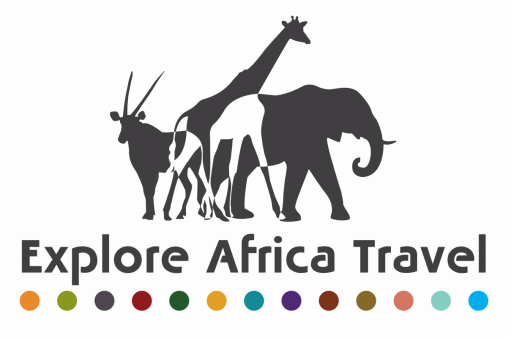
Our Team in Windhoek
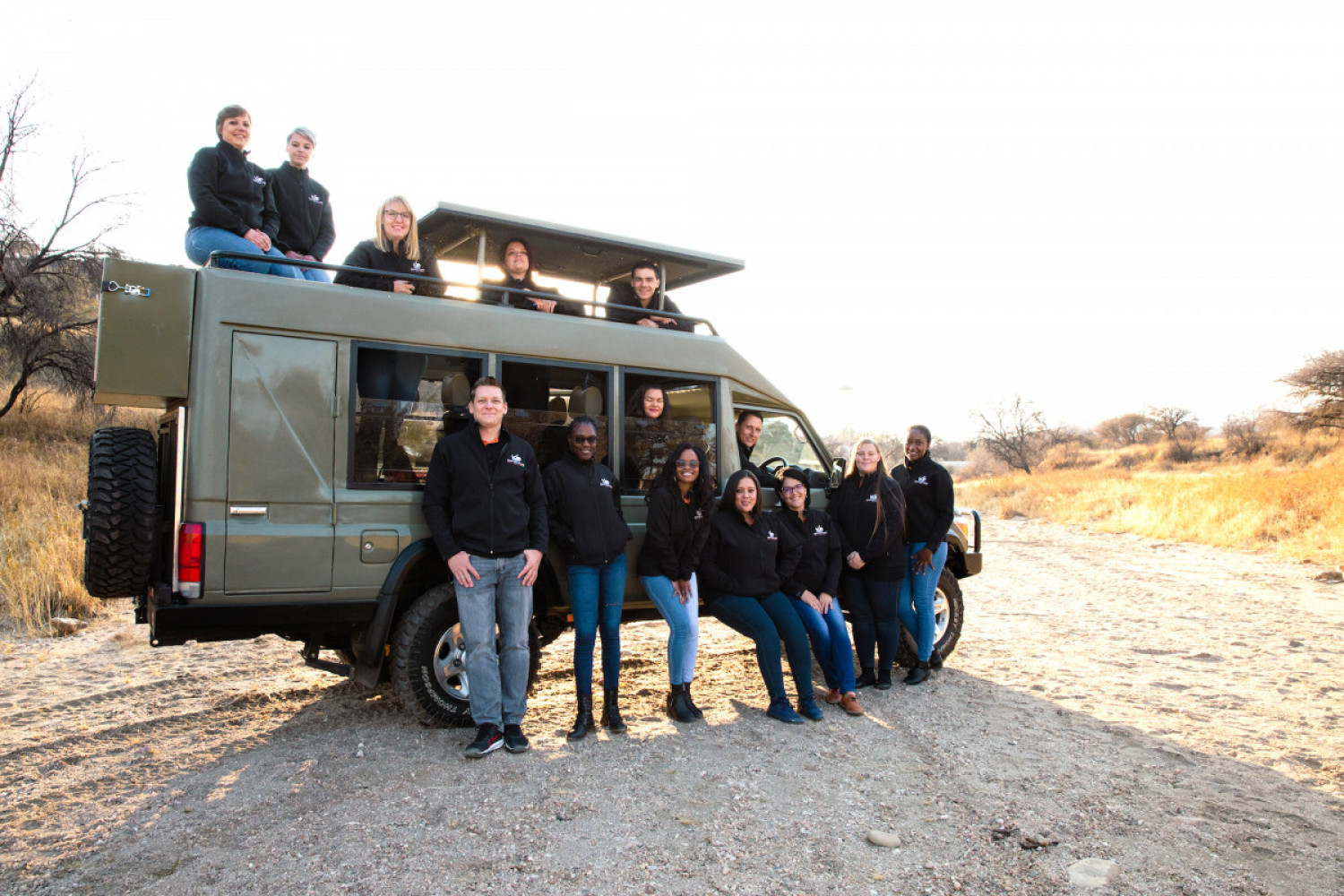
Why you should book your tour with us:
- MEINE NAMIBIA SAFARIS is a Namibian company that employs local Namibians who possess a deep love and knowledge of their country.
- We personally visit and test all the accommodations we recommend to you, ensuring that you have the best possible experience during your stay.
- With our extensive knowledge of the most beautiful routes in Namibia, we can help you choose the best roads for your individual tour.
- We work only with the best car rental companies, and can advise you on which type of vehicle is best for each particular tour, ensuring that you always reach your destination safely.
- As a local company, we meet all our clients in person and assist them with the process of receiving the rental vehicle, providing a detailed briefing and answering any questions.
- If you have any problems or questions during your tour, we are available 24/7 by phone.
- You will receive a customized, detailed, and printed tour folder with maps and all other essential materials for your tour.
- We also provide a digital itinerary, which you can download via a free app on your mobile device.
- In addition to our rental services, we offer other helpful rental items, such as individually pre-programmed GPS devices, binoculars, satellite phones, voltage converters, camera bags, and two-way radios.
- Traveling with us will usually not cost you more than planning and booking a tour by yourself, as we pride ourselves on earning only our fair commission from the lodges and rental companies. Booking with us also reduces travel risks, as you have an experienced team assisting you every step of the way.
Self-drive Safaris

Namibia Luxury Tour Lodge Partner (Omaanda Lodge)
Explore Namibia and Botswana on a Self-drive Safari!
Offroad Adventure Tours

Guided Offroad Adventure Tour 2017
Let yourself be inspired by our tour clips!

Our clip of the beautiful Okahirongo River Camp in Kaokoland

DESTINATION NAMIBIA (Meine Namibia Safaris on tour with KROLOP & GERST)

Self Drive Tours
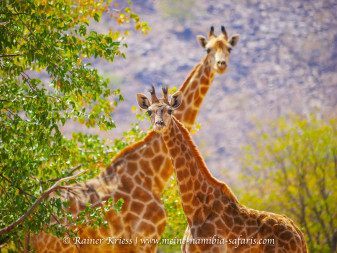
Namibia Short Tour
The Namibia Short Tour is intended for travelers who do not have much time, but still want to visit some of the highligh...
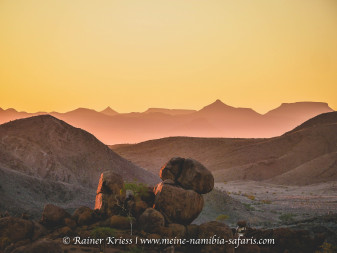
Namibia Adventure Tour
The Namibia Adventure Tour is our most popular Tour. This tour is tailored to the perfect duration, distances, highlight...
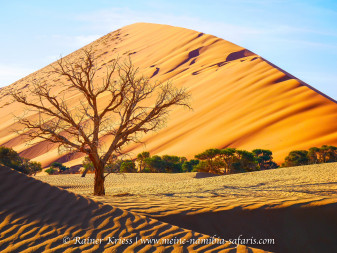
Namibia Classic Tour
As the name suggests, this is the Classic Namibia Tour!With us, this tour will look a little different then most classic...
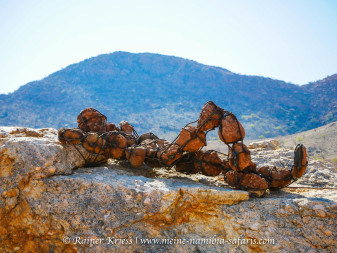
Namibia Leisure Tour
The Title of this tour says it all! If you would like a tour at a much slower pace, to have short distances between dest...
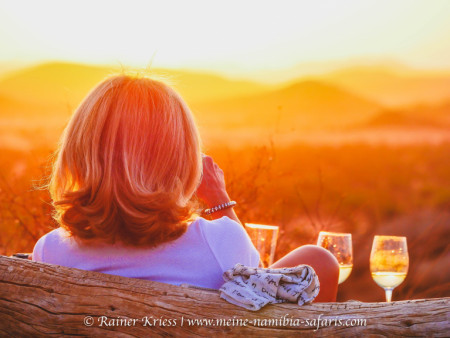
Namibia Luxury of the Landscapes
Namibia not only offers great landscapes, but also luxury. When combined, this creates the Luxury of the Landscapes Tour...
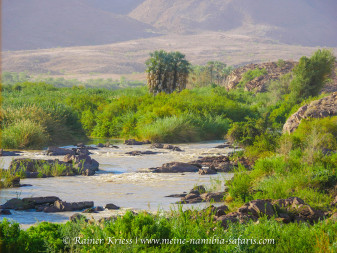
Namibia to Victoria Falls Tour
Experience the highlights in the northern parts of Namibia with a final luxurious touch at the mighty Victoria Falls. Th...
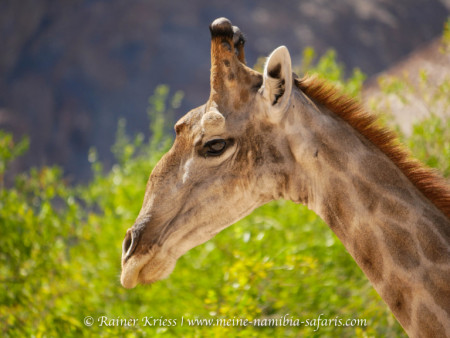
Namibia & Botswana Tour
On this tour you will visit Botswana's most renowned National Parks, the famous Victoria Falls, Caprivi Strip and the Et...
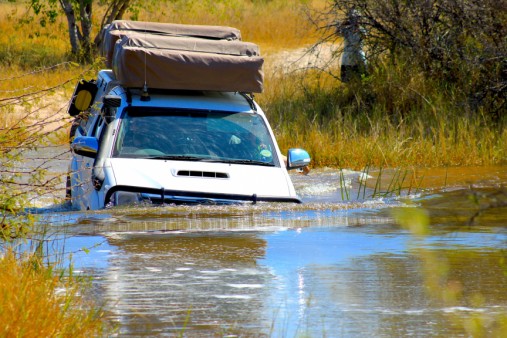
Botswana Adventure Tour
The Botswana adventure takes you to the wild and sandy heart of Botswana. A breathtaking Kalahari landscape with a huge ...
Instagram Photos
Testimonials.
Auch die zweite Reise mit und über "Meine Namibia Safaris" war ausgezeichnet. Die Organisation von Auto, Route, Unterkünften, Zwischen- und Langzeitstopps an Sehenswürdigkeiten ist TOP! Ebenso die Abwicklung bei unvorhersehbaren Pannen (in unserem Fall ein defekter Kühlschrank) ist unkompliziert und reibungslos. Jeglicher Service, von Erstkontakt via eMail bis zum Shuttle bei Abreise ist freundlich, unkompliziert und absolut Kundenorientiert. Für jeden Anspruch und jedes Budget wird hier ein unvergesslicher Tripp organisiert.
Hallo, ein klasse Route hatte uns Rainer zusammen gestellt, wir haben uns auf den Routen immer sicher gefühlt. Das Auto war Tip Top in Schuss - die ausgesuchten Logdes war toll - jede für sich hatte ein andres Highlight. Wir möchten uns hier nochmals für die tolle Reise bedanken!! Die nächste Afrika Tour ist für 2020 geplant und werden wir wieder bei Namibia-Safaris buchen!! Grüßle Anita&Reiner
Phantastic Kaoko- and Damaraland
Phantastic Tour! Very good preparation! Very good compliance with all our wishes. Best knowledge of places and what to do and see. Excellent meals cooked by Rainer himself! Perfect Service! We spent 2 weeks together and don't want to miss a minute of it.
Wir haben eine 16-tätige Selbstfahrer Rundreise unternommen. Davon waren wir 4 Tage Offroad mit Rainer unterwegs. Rainer ist Deutsch-Namibianer und kennt das Land, Flora und Fauna sowie die Tierwelt in und auswendig. Zudem ist Rainer sehr sympathisch, geduldig und ein geselliger offener Mensch für alles. Er beantwortet dir alle Fragen und führt dich bei seinen Offroad Touren ins Damaraland und Kaokoveld in die entlegensten Ecken die in keiner Karte eingezeichnet sind. Wir fuhren durch die schönsten unterschiedlichsten Farblandschaften und übernachteten an wilden Plätzen. Der Sundowner und das Braai durften natürlich auch nicht fehlen. Leider kann man keine 10 Sterne vergeben, denn die hätten Rainer und seine Teams (Meine-Namibia-Safaris, explore africa travel, explore namibia, asco car hire) mehr als verdient.
Incredibly brilliant!
Brilliant! If it were possible I would give more stars! This was a 3 week trip and 3 vehicles including Rainer as our guide and mainly camping (although the alternatives looked beautiful). The planning and organisation of the trip was meticulous to the last detail - from food, cold drinks (in 40 degrees!), showers to vehicles and tools for all eventualities. Nothing was overlooked. Namibia is a fascinating country wild and remote but such a trip needs to be taken seriously. Rainer is a very knowledgeable and experienced and sensitive to the environmental impact of such a trip on a fragile ecosystem. I had complete confidence in his ability to deal with any eventuality. The days never felt rushed; the vehicles were incredibly well prepared and safety well considered. It was an amazing trip with a great guide and I can not recommend Meine Namibia Safaris highly enough!
Ein gigantisch toller Namibia Urlaub :-)
Meine 3.- und eindrücklichste Reise in Namibia Ich bin nachts zu Hause noch eine Woche in meinen Träumen weitergefahren. Nur wunderschön was wir als Gruppe erleben und erlernen durften !!!
Durch die Videos "Destination Namibia" wurde ich auf Rainer und sein Unternehmen MEINE NAMIBIA SAFARIS aufmerksam. Anfang des Jahres '23 haben wir ihn dann auf der Touristikmesse in Stuttgart getroffen und für uns stand sofort fest, dass wir unsere nächste Tour nach Namibia über ihn buchen möchten. Mit der tollen und professionellen Unterstützung durch Rainer haben wir dann im Juni eine unvergessliche 2 1/2-wöchige Selbstfahrerrundreise durch Namibia und Botswana gemacht. Rainer hat uns von Anfang an super beraten und die Rundreise mehrfach an unsere Wünsche angepasst. Persönlich, professionell und einfach sehr sympathisch. Ob Telefonate, Emails, Whatsapp... Rainer stand jederzeit mit Rat und Tat zur Verfügung. Wir haben hervorragende Unterkünfte, wunderschöne Orte kennengelernt! Vielen lieben Dank dafür! Ein großer Dank geht ebenfalls an die Autovermietung Asco Car Hire, die eine sehr gründliche Einweisung bei der Autoübergabe vornahm. Unser Auto war bestens ausgerüstet und hat uns sicher durch Namibia und Botswana gefahren. Transfer von und zum Flughafen hat bestens funktioniert und alle waren sehr professionell, kundenorientiert und freundlich. Im nächsten Jahr möchten wir wieder nach Namibia reisen und planen erneut bei MEINE NAMIBIA SAFARIS zu buchen.
Our best experience ever. I've travelled a lot, but the passion, friendliness, and perfection of the Meine Namibia Safaris team took everything onto a new level. Thanks again for a fantastic experience!
Quick Contact
It's about a memory that will stay with you for the rest of your life.
To access your account you will need to Login.
This site uses cookies. We use cookies and other tracking technologies to improve your browsing experience on our website, to analyze our website traffic, and to understand where our visitors are coming from. By browsing our website, you consent to our use of cookies and other tracking technologies. To find out more, view our Cookie Policy .
- Alle maßgeschneiderte Safaris
- Kruger Nationalpark
- Okavango Delta
- Gorilla Trekking
- Safaris mit Frank
- Republic of the Congo
- Alle Gruppensafaris
- Alle Safari-Termine
- Reitsafaris
- Fotosafaris
- Einzigartige Safaris
- Regelmäßige Safaris
- Mobile Zeltsafaris Botswana
- Freiwilligenarbeit
- Alle Ziele anzeigen: Interaktive Karte
- Republik Kongo
- Alle ansehen
- Mobile Safaris
- Gorillas & Schimpansen
- Buschwanderungen
- Alle Ranger-Kurse
- Alle Termine
- Professionelle Ranger-Kurse
- Schnupperkurse
- Spezial-Kurse
- Onlinekurse
- Ranger-Kurse Camps
- Ranger-Kurse F.A.Q.
- Unterkünfte
- Frank’s Top 5
- Das erste Mal auf Safari
- Aktionen und Rabatte
- Was kostet eine Safari?
- Warum über uns buchen?
- Nachhaltigkeit
- Reiseinformationen
- Unsere Partner
- Gästetreueprogramm
- Gesas und Franks Geschichte
- Gästefeedback
- Preisgarantie

maßgeschneiderte Safaris
Top safaris, ost- & zentralafrika, südliches afrika, abfahrten festlegen.
- Deutschsprachige Safaris
Top Reiseziele
Ost- und zentralafrika, inseln im indischen ozean.
Die besten Safariziele im Juni
"der juni stellt den wendepunkt dar, denn die regenmonate sind jetzt endgültig vorbei und in den safarizielen beginnt die berühmte trockenzeit".
Der Juni läutet den Beginn des Winters und damit die Hochsaison für Safaris in den vielen Gebieten Afrikas ein. Egal für welches Reiseziel Sie sich entscheiden, Sie werden ein großartiges Erlebnis haben, bei warmen Temperaturen und wenig bis keinem Regen. Die Tiere versammeln sich an den Wasserquellen und die Zahl der Tiersichtungen steigt. In den Morgen- und Abendstunden können die Temperaturen fallen; packen Sie für idyllische Nächte am Lagerfeuer oder Safaris im offenen Geländewagen also lieber eine warme Jacke, Handschuhe und einen Schal ein. Alle Buschcamps sind im Juni geöffnet – Sie haben also die Qual der Wahl!
In Südafrika ist Kapstadt die Ausnahme: der Winter ist hier eher nass und kalt. Um den Krüger Nationalpark herum ist es allerdings warm und trocken; nur morgens und nachts wird es kühler.
Unser geliebtes Botswana ist den ganzen Juni über ein ausgezeichnetes Reiseziel und die meisten Camps bieten noch immer die Zwischensaisonpreise an. Sie können also auch im Juni noch ein paar Euros sparen. Da das Land langsam trocknet, müssen die Wildtiere die Makgadikgadi Pans verlassen und zu den Gewässern des Okavango Deltas wandern. Der Okavango ist nun ein reißender Strom und bietet phänomenale Möglichkeiten, Tiere zu beobachten. Das ist der optimale Start um Wasseraktivitäten zu unternehmen. Ganze Elefanten- und Büffelherden tummeln sich in den Uferbereichen der Flüsse Chobe und Linyanti.
In Namibia ist der Juni ziemlich trocken. Es ist zwar tagsüber warm, aber nachts sinken die Temperaturen. Jetzt beginnt die Safarisaison, denn die Tiere müssen sich nahe der dauerhaften Wasserquellen aufhalten. Im Etosha Nationalpark kannst du die berühmten „Arche Noah“-Szenen bestaunen! In Namibia profitieren Sie generell von einem guten Preis-Leistungs-Verhältnis, aber mit dem Beginn der Hochsaison steigt auch die Nachfrage, also besser weit im Voraus buchen!
Sambia ist in der Trockenzeit besonders aufregend: Buschwanderungen, die fantastische Tierwelt und abgelegenen Buschcamps eröffnen Ihnen ganz neue Abenteuermöglichkeiten! Der Südluangwa Nationalpark ist bekannt für seine Buschwanderungen im mittlerweile trockenen Flussbett, Fly Camping unter freiem Himmel, Raubkatzen und fantastische Erlebnisse in der Wildnis, die kaum zu übertreffen sind. Der Lower Zambezi Nationalpark bietet eine Vielzahl außergewöhnlicher Aktivitäten, während die Busanga Ebene der perfekte Ort ist, um spektakuläre Tierkämpfe zu beobachten, obwohl dies noch besser am Ende der Trockenzeit ist (September/Oktober).
In Ostafrika werden die meisten Parks geöffnet sein, und die Wildbeobachtung ist außergewöhnlich. Der südliche Rundweg Tansanias beginnt auszutrocknen, und im Ruaha-Nationalpark ziehen die Tiere langsam vom Miombo-Hochland in die Ebenen rund um den großen Ruaha River. Die Herden in der Serengeti befinden sich jetzt in den Grumeti-Reservaten, und die Durchquerung des Grumeti-Flusses sorgt für einige spektakuläre Sichtungen.
Die Tabelle zeigt welche Orte wir im Juni als “gut bis sehr gut” bewerten:
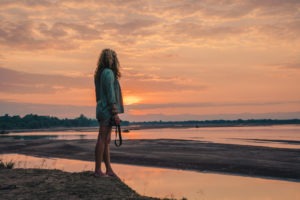
Safariziele im Juni
Bereit für ein abenteuer lassen sie uns starten.
Schicken Sie uns eine Nachricht mit Ihren Wünschen und Vorstellungen und wir helfen Ihnen Ihren Traum wahr werden zu lassen!
Unsere Partner In Afrika Machen Ihre Traumreise Wahr
[email protected] +61 (02) 7257 7683
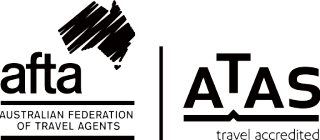
Developed by Viewport / WordPress Guys
Quick Links
- Wie viel kostet eine Safari?
- Das Okavango Delta
- Die große Migration der Gnus
- Umfangreiche Reiseversicherung
- Seitenverzeichnis
Unsere Safaris
- All Safaris
- Safari-Ideen
- Safaris Mit Frank
- Pferdesafaris
- Selbstfahrer-Safari
- Alleinreisende
- Paare & Flitterwochen
- Safari für die ganze Familie
Destinationen
Newsletter abonnieren, jetzt anfragen.
- Hidden Anfrage über
- Landesvorwahl * Afghanistan (+93) Albania (+355) Algeria (+213) American Samoa (+1684) Andorra (+376) Angola (+244) Anguilla (+1264) Antigua and Barbuda (+1268) Argentina (+54) Armenia (+374) Aruba (+297) Australia (+61) Austria (+43) Azerbaijan (+994) Bahamas (+1242) Bahrain (+973) Bangladesh (+880) Barbados (+1246) Belarus (+375) Belgium (+32) Belize (+501) Benin (+229) Bermuda (+1441) Bhutan (+975) Bolivia (+591) Bosnia and Herzegovina (+387) Botswana (+267) Brazil (+55) British Indian Ocean Territory (+246) British Virgin Islands (+1284) Brunei (+673) Bulgaria (+359) Burkina Faso (+226) Burundi (+257) Cambodia (+855) Cameroon (+237) Canada (+1) Cape Verde (+238) Cayman Islands (+1345) Central African Republic (+236) Chad (+235) Chile (+56) China (+86) Christmas Island (+61) Cocos (Keeling) Islands (+61) Colombia (+57) Comoros (+269) Cook Islands (+682) Costa Rica (+506) Croatia (+385) Cuba (+53) Curaçao (+5999) Cyprus (+357) Czechia (+420) DR Congo (+243) Denmark (+45) Djibouti (+253) Dominica (+1767) Dominican Republic (+1809) Dominican Republic (+1829) Dominican Republic (+1849) Ecuador (+593) Egypt (+20) El Salvador (+503) Equatorial Guinea (+240) Eritrea (+291) Estonia (+372) Ethiopia (+251) Falkland Islands (+500) Faroe Islands (+298) Fiji (+679) Finland (+358) France (+33) French Guiana (+594) French Polynesia (+689) Gabon (+241) Gambia (+220) Georgia (+995) Germany (+49) Ghana (+233) Gibraltar (+350) Greece (+30) Greenland (+299) Grenada (+1473) Guadeloupe (+590) Guam (+1671) Guatemala (+502) Guernsey (+44) Guinea (+224) Guinea-Bissau (+245) Guyana (+592) Haiti (+509) Honduras (+504) Hong Kong (+852) Hungary (+36) Iceland (+354) India (+91) Indonesia (+62) Iran (+98) Iraq (+964) Ireland (+353) Isle of Man (+44) Israel (+972) Italy (+39) Ivory Coast (+225) Jamaica (+1876) Japan (+81) Jersey (+44) Jordan (+962) Kazakhstan (+76) Kazakhstan (+77) Kenya (+254) Kiribati (+686) Kosovo (+383) Kuwait (+965) Kyrgyzstan (+996) Laos (+856) Latvia (+371) Lebanon (+961) Lesotho (+266) Liberia (+231) Libya (+218) Liechtenstein (+423) Lithuania (+370) Luxembourg (+352) Macau (+853) Macedonia (+389) Madagascar (+261) Malawi (+265) Malaysia (+60) Maldives (+960) Mali (+223) Malta (+356) Marshall Islands (+692) Martinique (+596) Mauritania (+222) Mauritius (+230) Mayotte (+262) Mexico (+52) Micronesia (+691) Moldova (+373) Monaco (+377) Mongolia (+976) Montenegro (+382) Montserrat (+1664) Morocco (+212) Mozambique (+258) Myanmar (+95) Namibia (+264) Nauru (+674) Nepal (+977) Netherlands (+31) New Caledonia (+687) New Zealand (+64) Nicaragua (+505) Niger (+227) Nigeria (+234) Niue (+683) Norfolk Island (+672) North Korea (+850) Northern Mariana Islands (+1670) Norway (+47) Oman (+968) Pakistan (+92) Palau (+680) Palestine (+970) Panama (+507) Papua New Guinea (+675) Paraguay (+595) Peru (+51) Philippines (+63) Pitcairn Islands (+64) Poland (+48) Portugal (+351) Puerto Rico (+1787) Puerto Rico (+1939) Qatar (+974) Republic of the Congo (+242) Romania (+40) Russia (+7) Rwanda (+250) Réunion (+262) Saint Barthélemy (+590) Saint Kitts and Nevis (+1869) Saint Lucia (+1758) Saint Martin (+590) Saint Pierre and Miquelon (+508) Saint Vincent and the Grenadines (+1784) Samoa (+685) San Marino (+378) Saudi Arabia (+966) Senegal (+221) Serbia (+381) Seychelles (+248) Sierra Leone (+232) Singapore (+65) Sint Maarten (+1721) Slovakia (+421) Slovenia (+386) Solomon Islands (+677) Somalia (+252) South Africa (+27) South Georgia (+500) South Korea (+82) South Sudan (+211) Spain (+34) Sri Lanka (+94) Sudan (+249) Suriname (+597) Svalbard and Jan Mayen (+4779) Swaziland (+268) Sweden (+46) Switzerland (+41) Syria (+963) São Tomé and PrÃncipe (+239) Taiwan (+886) Tajikistan (+992) Tanzania (+255) Thailand (+66) Timor-Leste (+670) Togo (+228) Tokelau (+690) Tonga (+676) Trinidad and Tobago (+1868) Tunisia (+216) Turkey (+90) Turkmenistan (+993) Turks and Caicos Islands (+1649) Tuvalu (+688) Uganda (+256) Ukraine (+380) United Arab Emirates (+971) United Kingdom (+44) United States (+1) United States Virgin Islands (+1340) Uruguay (+598) Uzbekistan (+998) Vanuatu (+678) Vatican City (+379) Vatican City (+3906698) Venezuela (+58) Vietnam (+84) Wallis and Futuna (+681) Western Sahara (+212) Yemen (+967) Zambia (+260) Zimbabwe (+263)
- Telefonnummer *
- Andere Suchmaschine
- TV-Auftritt oder Bücher von Gesa Neitzel
- Wer hat uns empfohlen? *
- Andere Quellen
- Meldet mich für den Newsletter an
- Hidden GDPR check
- Ich bin damit einverstanden, dass SAFARI FRANK die Daten, die ich zur Verfügung stelle, für Zwecke der Kommunikation, Reiseberatung und ggf. späterer Buchung speichern darf. Ich habe im Rahmen der geltenden gesetzlichen Bestimmungen jederzeit das Recht auf unentgeltliche Auskunft über meine gespeicherten personenbezogenen Daten, deren Herkunft und Empfänger und den Zweck der Datenverarbeitung und ggf. ein Recht auf Berichtigung, Sperrung oder Löschung dieser Daten.
- Hidden gclid
- Hidden utm_campaign
- Hidden utm_term
- Hidden utm_source
- Hidden utm_medium
- Hidden utm_content
- Hidden fbclid
- Name Dieses Feld dient zur Validierung und sollte nicht verändert werden.
Privacy Overview

IMAGES
VIDEO
COMMENTS
Namibia Reise im Juni. Der Juni eröffnet die Saison für Wildtierbeobachtungen auf Namibia-Reisen.In der Mitte des Jahres fällt zusehendes weniger Regen, die Luft wird trockener und die Nächte kühlen auf bis zu 5°C ab. Das konstante Wetter im Juni sorgt dafür, dass alle Hauptstraßen und die meisten Wege frei befahrbar sind, was die Wintermonate in Namibia ideal für Safari-Reisen in ...
Our most popular safaris in Namibia in June: Many highlights in a short time. Private Lodge Tour Namibian Explorer. Places Namib Desert, Swakopmund, Skeleton Coast, Damaraland, Etosha National Park. 7 Days . from 30,800 NAD (based on 6 persons) A classic Namibia safari. Small Group Lodge Tour
Durchschnittliche Temperaturen in Namibia im Juni. Es gibt regionale Unterschiede im Klima, aber ganz Namibia bleibt im Juni generell trocken und regenfrei. In höher gelegenen Gebieten, wie der Hauptstadt Windhoek, liegen die Temperaturen tagsüber bei etwa 20°C, während sie nachts auf 10°C fallen können.
Compare 259 Namibia safari tours offered by 33 specialized tour operators. Find the best deals using the largest marketplace for African safaris. Best price guarantee! Menu. Safaris & Tours. Botswana (534) Congo (DRC) (28) Eswatini (12) Ethiopia (136 ...
Compare 199 of the best Namibia safari tours offered by 28 specialized tour operators. Find the best deals using the largest marketplace for African safaris. Best price guarantee! Menu. Safaris & Tours. Botswana (584) Congo (DRC) (28) Eswatini (12) Ethiopia (138 ...
Spend 2 nights / 3 days exploring the oldest desert in the world. This camping safari offers the best value option starting…. 5. Private 3 Days Tour to Sossusvlei Namib Desert - Lodges. This 3 Days Sossusvlei Tour has been designed to give all the clients an snapshot of Namibia iconic landscape.
Here at SecretNamibia we are committed to making your safari dreams a reality. Based in Namibia, our team of dedicated safari architects specialise in crafting luxury Namibia safari holidays that are completely bespoke and tailored to your requirements. From self-drive adventures to elite honeymoon escapes, luxury family getaways to 5-star fly ...
Family. Christmas & New Year. Visit the impressive Etosha Pan and then view the Big 4. Admire the scenic Damaraland and connect with locals. Explore the Sossusvlei area and then climb the Dune 45. Duration. 6 days. Destinations. Windhoek, Etosha National Park, Damaraland, Swakopmund, Namib-Naukluft Park, Sesriem, Sossusvlei, Rehoboth.
6-Day Wilderness Luxury Guided Safari. This short tour allows one to focus mainly on wildlife viewing in form of game drives and walking safaris while enjoying some of the best accommodations and cuisines. This allows one to feel the tranquility of the lodges, at the same enjoying the privacy and flexibility of the activities.
6 Days Sossusvlei, Swakopmund and Etosha National Park Lodging. Safari. Family. Wildlife. Jeep & 4WD. Christmas & New Year. Go on a half-day game drive in Etosha. Shop at Okahandja Wood Carving Market. Explore Namib Naukluft National Park.
By Melanie van Zyl. Escape the mainstream safari itineraries at Bwabwata National Park. Often overlooked in favour of Namibia's more famous safari parks, I like to think of this area as a more affordable Okavango Delta. With lush landscapes and riverine forests, the wetlands of the Zambezi Region (formerly known as the Caprivi Strip) in ...
Namibia Safari im Juni: Der Nordosten - Sambesi-Region. Besuchst du im Juni die Nationalparks im Sambesi-Streifen (der frühere Caprivi-Strip), geht es selbst in diesem Monat nicht ohne einen 4×4 Geländewagen. Wenn es auch nicht durchgängig feucht bis sumpfig ist, so können einige Stellen zumindest sehr tiefsandig sein.
Day 6 Sossusvlei Desert Lodge in the NamibRand Nature Reserve. The name says it all: Namibia's three big destinations on one simple fly-in itinerary plus great accommodation and 10 well-paced days to do it all in. Private settings and romantic, luxurious camps mean that this is a great tour for romantic travellers and safari-goers looking for comfort while off the beaten path.
1. Africa's natural art gallery. Namibia requires time. It's one of the world's most sparsely populated countries and it's difficult getting around. There's virtually nothing other than wilderness. Even a town that's signposted for 500 kilometres passes by in the blink of an eye. Most of the land is inhospitable.
Safari Description. This 7 day and 6 night accommodated safari is a tailor made opportunity to visit the best of Namibia in a perfect time frame. Experience a moving insight into wildlife conservation and rehabilitation at the N/a'an ku se Wildlife Sanctuary before seeking amazing wildlife encounters in Etosha National Park.
6-Day Namibia Highlights Flying Safari. On this Namibia safari, fly between two premier destinations and stay in some of Namibia's most remote and luxurious properties. You'll begin with a light aircraft flight from Windhoek into a private reserve within the Namib Desert to visit the dunes of Sossusvlei with guided activities included.
With 2 million people in a country twice the size of France, Namibia is one of the world's least populated countries. Yet with its towering sand dunes, vast lunar plains, free-roaming wildlife and star-speckled night sky, it's also one of the most beautiful. C&TH Guide to Responsible Tourism. Review: Wilderness Destinations, Namibia
Dennoch eignen sie sich als optimale Reisezeit, weil die Sonne viele Stunden am Tag scheint und es wenige Regentage in diesen Monaten gibt. Die beste Reisezeit für Namibia in der Monatsübersicht: Mai: 23°C, 10h Sonne, 1 Regentag, 37% Luftfeuchtigkeit. Juni: 20°C, 10h Sonne, 0 Regentage, 32% Luftfeuchtigkeit.
07:30. Scenic drive to Damaraland. Taleni Etosha Village → Damaraland. Enjoy an early morning breakfast and departure from your lodge is at 07h30.... read more. Half Day. Drive down to the Skeleton Coast. → Skeleton Coast. A light roadside lunch is served en-route in the shadow of Namibia's talles... read more. Late Afternoon.
Die beste Reisezeit für Safaris in Namibia sind die trockenen Monate im Juli, August und September.In dieser Zeit sind viele Gewässer bereits ausgetrocknet, was dazu führt, dass die Tierwelt nur noch an festen Wasserstellen und Wasserlöchern ausreichend Trinkwasser findet.. Wenn du nun an den Wasserlöchern mit etwas Zeit und Geduld die Wartezeit überbrückst, kommen die Tiere früher ...
7-Day Unique Luxury Fly-in Safari. $6,336 pp (USD) Namibia: Private tour Luxury Lodge & Hotel. You Visit: Windhoek (Start), Sossusvlei (Sand Dunes), Swakopmund (City), Damaraland, Etosha NP, Hosea Kutako Airport (End) People Tours And Safari. 4.8/5 - 60 Reviews. 7-Day Sossusvlei and Swakopmund Self-Drive Safari.
As a specialist in guided adventure tours through remote regions of Namibia, we also organize self-drive tours through Namibia and Botswana for you. Book your adventure now! | Meine Namibia Safaris, Ihr Spezialist für geführte Safaris im Kaokoland/Damaraland und für organisierte Selbstfahrer Touren in Namibia und Botswana.
Oktober. November. Dezember. Der Juni läutet den Beginn des Winters und damit die Hochsaison für Safaris in den vielen Gebieten Afrikas ein. Egal für welches Reiseziel Sie sich entscheiden, Sie werden ein großartiges Erlebnis haben, bei warmen Temperaturen und wenig bis keinem Regen. Die Tiere versammeln sich an den Wasserquellen und die ...